Sony Group PCG551L Notebook PC with Integral Wireless LAN Card User Manual Harp UG
Sony Corporation Notebook PC with Integral Wireless LAN Card Harp UG
Contents
- 1. Manual Part 1
- 2. Manual Part 2
Manual Part 2

1
Welcome.......................................................9
Using Your VAIO Computer .....................11
Using the Keyboard...................................................12
Functions of the keyboard keys .........................................13
Combinations and functions with the Windows key .........14
Indicators ...........................................................................15
Combinations and functions with the Fn key ....................16
Using VAIO Action Setup ........................................19
Using the Jog Dial Control........................................20
Launcher mode ..................................................................20
Guide mode........................................................................21
Using the Jog Dial control with Sony software .................21
Using the Jog Dial control with other software .................22
Internal timer......................................................................23
Using Memory Stick Media ......................................24
Types of Memory Stick media...........................................24
Notes on using Memory Stick media.................................26
Using PC Cards.........................................................28
To insert PC card ...............................................................28
To remove a PC Card while your computer is on..............29
Notes on PC Cards.............................................................29
Using Power Saving Modes......................................31
Normal mode .....................................................................31
Standby mode ....................................................................31
Hibernate mode..................................................................31
Notes on power saving modes ...........................................32
Connecting a Telephone Cable ................................33
To connect a telephone cable.............................................33
Connecting to a LAN ................................................34
To set up a network............................................................35

Change text in this variable definition to document title.
2
Connecting to a Wireless LAN.................................36
Turning On Wireless LAN................................................ 36
The Wireless LAN Access Point ...................................... 36
Communicating with an Access Point (infrastructure)..... 37
Communicating without an access point (ad-hoc)............ 38
Turning Off Wireless LAN ............................................... 40
Notes on using Wireless LAN .......................................... 40
Connecting Peripheral Devices ...............41
Connecting a Floppy Disk Drive ..............................42
To connect a floppy disk drive.......................................... 42
To insert a floppy disk into the floppy disk drive............. 43
To remove a floppy disk from the floppy disk drive ........ 44
To disconnect a floppy disk drive when the computer is on.
44
To carry an floppy disk drive............................................ 45
Notes on handling floppy disks......................................... 45
Connecting a PC Card Bus Drive .............................46
To connect an optical drive............................................... 46
To insert a disc .................................................................. 47
To remove the drive.......................................................... 48
Notes on CD and DVD discs ............................................ 49
Connecting an i.LINK Optical Disc Drive ...............50
To connect an i.LINK optical disc drive........................... 50
To disconnect an i.LINK optical disc drive...................... 52
Notes on using i.LINK optical disc drives........................ 52
Connecting a USB Mouse or Keyboard ...................53
To connect a USB mouse or keyboard.............................. 53
Connecting a USB Device ........................................55
To connect a USB device.................................................. 55

3
Connecting a USB Printer.........................................56
To connect to a USB printer ..............................................56
Connecting an i.LINK Audio-Video Device.............58
To connect a digital video camera recorder.......................58
Notes on connecting an i.LINK device..............................59
Connecting an External Display................................60
To connect a computer display ..........................................60
To connect a projector .......................................................61
Changing the display when connecting an external computer
display or projector ............................................................62
Connecting with another VAIO computer ................63
Connecting External Speakers ..................................64
To connect external speakers.............................................64
Connecting a Microphone .........................................65
To connect a microphone...................................................65
To record from a microphone or audio equipment............65
Adjusting the volume.........................................................66
Expanding Your Computer Capabilities ...................68
Personal Digital Assistant..................................................68
Wireless LAN Access Point ..............................................68
Wireless LAN PC Card......................................................69
Customizing Your VAIO Computer..........71
Displaying the Sony Notebook Setup Screen ...........72
Sony Notebook Setup tabs.................................................73
Controlling Power Management ...............................74
Viewing the Power Management status icons ...................74
To access PowerPanel Help...............................................74
Power Management profiles..............................................75
Power Management commands .........................................77
Conserving battery power..................................................78

Change text in this variable definition to document title.
4
Displaying Battery Information................................79
To display the Battery Information window..................... 79
To display the Battery Information toolbar....................... 79
To close the Battery Information toolbar.......................... 79
Battery icon descriptions................................................... 80
Displaying detailed battery information ........................... 80
Changing the window design of Sony software................ 81
Selecting the Display Mode......................................83
To select the display mode................................................ 83
Adding Memory.........................................85
Precautions and Procedures ......................................86
Typical expansion memory configuration ........................ 86
Installing a Memory Module ....................................87
Removing a Memory Module...................................90
Confirming Added Memory Capacity......................92
About the Software on Your Computer...93
Software Overview ...................................................93
DVgate application notes..........................................99
Digital video captures ....................................................... 99
Adjusting image resolution ............................................... 99
Hard disk drive partition ................................................... 99
Software Support Information ................................101
Sony Service Center........................................................ 103
Using the Recovery CDs ........................105
Application, Driver, and System Recovery CDs ....106

5
Using Your Recovery CDs......................................107
To use the Application Recovery CD(s)..........................107
To use the Driver Recovery CD(s) ..................................108
To use the System Recovery CD(s).................................109
Troubleshooting......................................113
Troubleshooting Your Computer ............................114
My computer does not start. ............................................114
My computer starts, but a BIOS error appears. ...............114
My computer starts, but the message “Operating system not
found” appears and Windows does not start....................115
My computer stops responding or does not shut down. ..116
The Power Management setting is not responding..........116
The sound of my computer’s fan is too loud. ..................117
Why does the System Properties dialog box display a slower
CPU speed than advertised? ............................................117
Troubleshooting the LCD Screen............................118
My LCD screen is blank. .................................................118
The image on my connected external display is not centered
or sized properly. .............................................................118
I cannot simultaneously display movies, DVD video, or the
Smart Capture (Finder) window on the LCD display and an
external display................................................................118
I want to change the video resolution of my display. ......118
Troubleshooting the Mouse and Touchpad.............119
My mouse does not work.................................................119
My touchpad does not work properly. .............................119
The pointer does not move while I am using the Touchpad or
Mouse...............................................................................119
Troubleshooting Drives, PC Cards and Peripheral De-

Change text in this variable definition to document title.
6
vices ........................................................................121
My floppy disk drive icon doesn’t appear even though it is
connected. ....................................................................... 121
My optical drive is not playing my disc properly. .......... 121
My optical disc drive tray does not open........................ 122
I cannot use digital video (DV) devices. The message “DV
equipment seems to be disconnected or turned off” appears.
122
My PC Card is not working. ........................................... 123
Troubleshooting i.LINK devices ............................124
I cannot establish a connection between two VAIO comput-
ers when using an i.LINK cable...................................... 124
Troubleshooting Software.......................................125
My software program stops responding or crashes......... 125
When I click an application icon, the message “You must in-
sert the application CD into your CD-ROM (DVD-ROM)
drive” appears, and the software does not start............... 125
I cannot use the DVgate software. .................................. 125
My computer’s start-up time seems longer after I have in-
stalled AOL. What can I do?........................................... 125
What software do I use for CD-R/CD-RW software func-
tions? ............................................................................... 126
Troubleshooting the Modem...................................127
My modem does not work. ............................................. 127
My modem connection is slow. ...................................... 127
Troubleshooting Wireless LAN functions..............128
I cannot use the Wireless LAN functionality.................. 128
The computer cannot connect to a Wireless LAN Access
Point. ............................................................................... 128
I cannot access the Internet............................................. 128
The data transfer speed is slow. ...................................... 129
The communication speed is interrupted or slowed down

7
when MPEG2 data is transferred.....................................129
Data transfers are interrupted...........................................129
Troubleshooting Audio ...........................................131
My speakers have no sound.............................................131
There is noise distortion while listening to music with USB
speakers or USB headphones...........................................131
My microphone does not work. .......................................132
Troubleshooting Memory Stick Media ...................133
Image files do not open even though I insert Memory Stick
media into the slot............................................................133
Memory Stick media does not work. I cannot access the re-
movable drive. .................................................................133
Getting Help.............................................135
Support Options.......................................................135

Change text in this variable definition to document title.
8

9
Welcome
Congratulations on your purchase of this Sony VAIO® computer, and
welcome to the VAIO User Guide.
This User Guide provides detailed information on all aspects of using
your new VAIO computer, from keyboard functions to preinstalled
software applications.
In the left navigation window, click the topics you want to learn more
about, and that information will be displayed in this main window.
✍Click here to find the latest updates and supplemental information about your
computer.

Change text in this variable definition to document title.
10

11
Using Your VAIO Computer
This section describes the following aspects of your new computer:
❑Using the Keyboard
❑Using VAIO Action Setup
❑Using the Jog Dial Control
❑Using Memory Stick Media
❑Using PC Cards
❑Using Power Saving Modes
❑Connecting a Telephone Cable
❑Connecting to a LAN
❑Connecting to a Wireless LAN
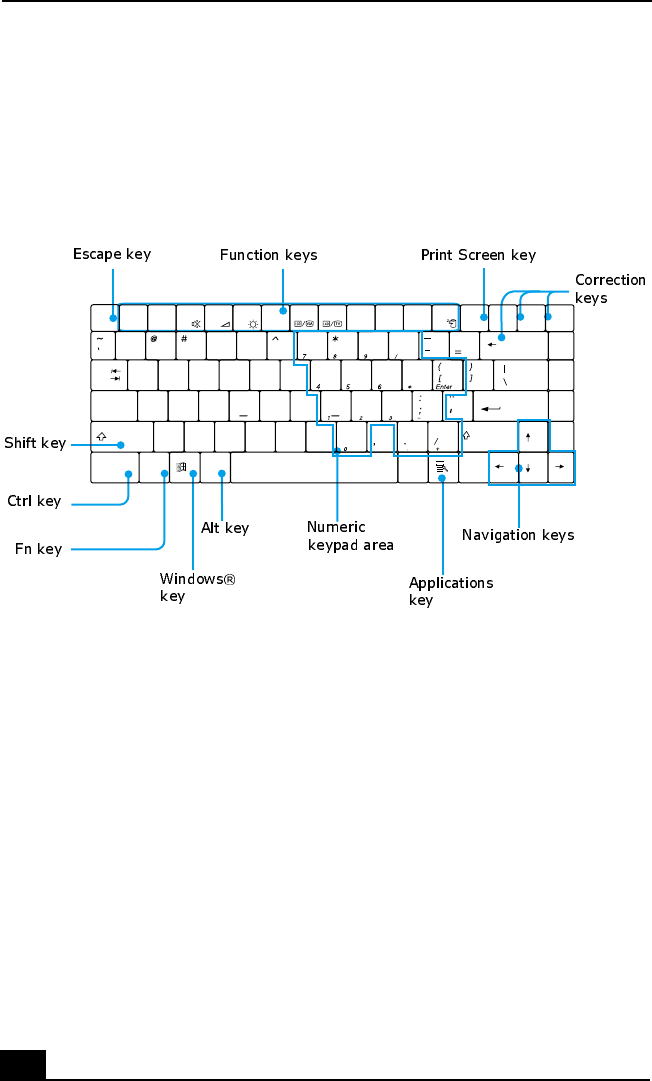
Change text in this variable definition to document title.
12
Using the Keyboard
Your keyboard is very similar to a typewriter’s, but your computer keyboard has
additional keys that perform specific computer-related tasks.
Keyboard
Esc F1 F2 F3 F4 F5 F6 F7 F8 F9 F10 F11 F12 NumLk
Scr Lk Prt Sc
SysRq Insert
Pause Delete
Break
Tab
Caps Lock
Shift
Shift
Ctrl Ctrl
Home
Page
Up
Page
Down
End
Fn Alt Alt
Z
A
Q
X
S
W
C
D
E
V
F
R
B
G
T
N
H
Y
M
J
U
<
K
I
>
L
O
?
P
2134567890
!$% & ( )
Enter
+
Backspace

Using the Keyboard
13
Functions of the keyboard keys
Key Description
Numeric keypad area Contains the keys found on a typical calculator. Use the
numeric keypad area to type numbers or to perform
mathematical calculations such as addition and
subtraction. Numbers appear on the front beveled edge of
the numeric keys. You must press the Num Lock key to
activate the numeric keypad. (When you do so, the Num
Lock indicator lights up.)
Navigation keys Several keys are devoted to moving the cursor on the
screen (the four arrow keys which also function as the
Home, End, Page Up, and Page Down keys).
Correction keys The Insert, Backspace, and Delete keys enable you to
make corrections in your documents.
Function keys The twelve function keys along the top of the keyboard
are used to perform designated tasks. For example, in
many applications, F1 is the Help key. The task associated
with each function key may vary among applications.
Escape key The Esc (Escape) key is used to cancel commands.
Print Screen key The Print Screen key takes an electronic snapshot of the
screen and moves it to the Windows® Clipboard. You can
then paste the screen shot into a document and print it.

Change text in this variable definition to document title.
14
Combinations and functions with the Windows key
Operator keys (Shift,
Ctrl, Alt keys)
Several keys are always used with at least one other key:
Ctrl, Alt, and Shift. When held down with another key,
the Ctrl (Control) and Alt (Alternate) keys offer another
way to give commands. For example, in many
applications, instead of choosing the Save command from
a menu, you can hold down Ctrl and press the S key
(referred to as Ctrl+S). The Shift key operates the same
way as on a typewriter; it is used to produce capital letters
or special symbols, such as @ and $.
Windows® key The key with the Windows® logo displays the Windows®
Start menu; it’s the equivalent of clicking Start on the
taskbar. See “Combinations and functions with the
Windows key” for more information.
Fn key The Fn key is used in combination with other keys to
issue commands. See “Combinations and functions with
the Fn key” for more information.
Applications key The Applications key displays a shortcut menu of
context-sensitive choices. Pressing this key is the
equivalent of clicking the right mouse button.
Combination Function
+ F1 Displays VAIO® Help and Support Center.
+ Tab Switches the selected button on the taskbar.
+ E Displays Windows® Explorer.
Key Description

Using the Keyboard
15
Indicators
+ F Displays the Search window to find a file or folder. This
is the equivalent of selecting Search from the Start
menu.
+ Ctrl + F Displays the search results window where you can
locate other computers. This is the equivalent of
selecting Search, and then Computers from the Start
menu.
+ M Minimizes all displayed windows (with Num Lock off).
Shift + + M Returns all minimized windows to their previous size.
+ R Displays the Run window. This is the equivalent of
selecting Run from the Start menu.
Fn + + Insert Displays the System Properties window. This is the
equivalent of selecting Control Panel, and then System
from the Start menu.
Indicator Function
Power Lights up when the power to the computer is turned on, flashes in
Standby mode, and turns off when the computer is in Hibernate
mode or powered off.
Battery
Lights up when the computer is using battery power, flashes when
the battery is running out of power, double-flashes when the
battery is charging.
Hard disk Lights up when data is read from or written to the hard disk drive.
Do not enter Standby mode or turn off the computer when this
indicator light is on.
Combination Function

Change text in this variable definition to document title.
16
Combinations and functions with the Fn key
Wireless
LAN
Lights up when the Wireless LAN function is running.
Memory
Stick®
Lights up when data is read from or written to the Memory Stick
media. (Do not enter Standby mode or turn off the computer when
this indicator light is on.) When indicator is off, the Memory Stick
media is not being accessed.
Num Lock Lights up when the number keys area in the numeric keypad are
active. When indicator is off, the alphanumeric character keys in
the keypad area are active.
Caps Lock Lights up when the letters appear in uppercase as you type. The
Shift key lowers the case of typed letters when Caps Lock is on.
When the indicator is off, the letters appear in lower case as you
type (unless you hold down the Shift key).
Scroll Lock Lights up when the screen scrolls differently. (Exactly how it
scrolls depends on the specific application. This function does not
work with all applications.) When indicator is off, information
moves across the display normally.
✍If you switch user identities during a computing session, the Fn+F7 key
functionality (if available on your computer) will be interrupted. To switch to an
external display or monitor, see “Selecting the Display Mode” for more information.
Indicator Function
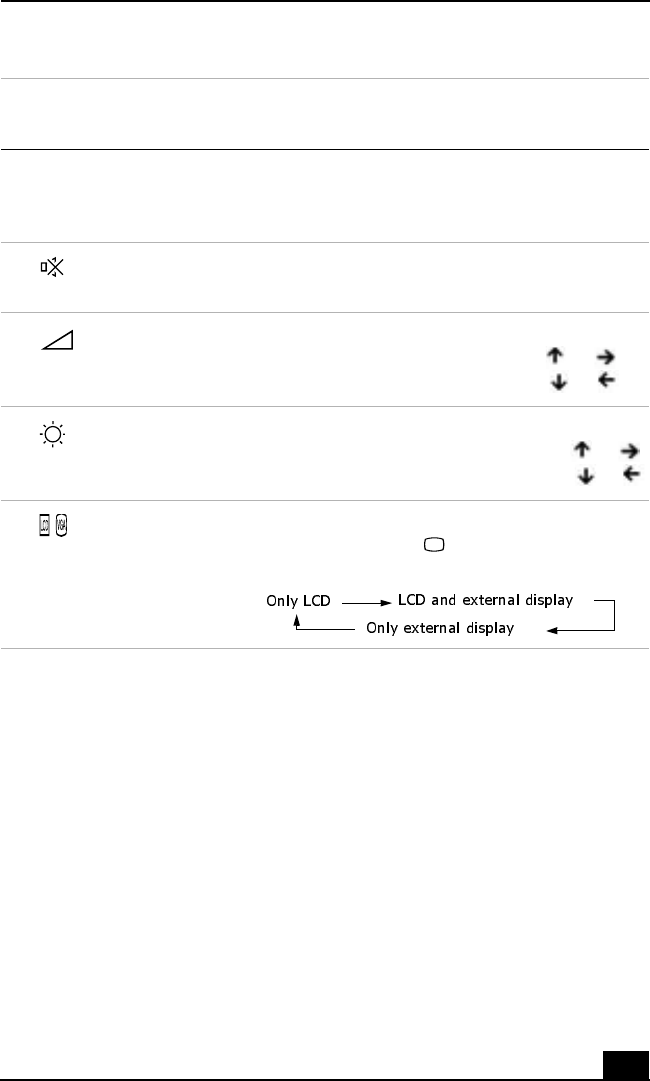
Using the Keyboard
17
Combinations/
Feature Functions
Fn+ (ESC)
Standby
Puts the system into Standby mode, a power
management state. To return the system to the active
state, press any key on your computer.
Fn+ (F3)
Speaker switch
Toggles the built-in speaker off and on.
Fn+ (F4)
Speaker volume
Adjusts the built-in speaker volume.
To increase volume, press Fn+F4, then or .
To decrease volume, press Fn+F4, then or .
Fn+ (F5)
Brightness control
Adjusts the brightness of the LCD.
To increase the intensity, press Fn+F5 and or .
To decrease the intensity, press Fn+F5 and or .
Fn+ (F7)
Switch to the
external display
Toggles between the LCD, external display
(connected to the VGA Monitor port), and both
LCD and external display modes.

Change text in this variable definition to document title.
18
Fn+ (F12)
Hibernate
Provides for the lowest level of power consumption.
When you execute this command, the state of the
system and state of the peripheral devices are
written to the hard disk, and the system power is
turned off. To return the system to the original state,
press the power button briefly to turn on the power.
Fn+B
Bass Boost
Toggles the bass-boost function off and on. This
feature is available only while using headphones.
Fn+ F Display control. Minimizes and maximizes the LCD
screen. If the default display resolution is reduced,
this function maximizes the display resolution to fit
the screen size. Maximizing the display screen
enables you to view the display at a greater
resolution.
✍Some functions are not available until Windows® launches.
Combinations/
Feature Functions

Using VAIO Action Setup
19
Using VAIO Action Setup
VAIO Action Setup manages the settings for your computer’s Jog Dial™ control,
Memory Stick® media, and i.LINK®* interface. With VAIO Action
Setup, you can:
❑Change the Jog Dial setting
❑Change the USB device connection setting
❑Change the time setting.
For more information on changing the settings using VAIO Action Setup, right-
click the Jog Dial control icon or in the taskbar, and click Help Topics.
* i.LINK is a trademark of Sony used only to designate that a product contains an IEEE1394
connection. The i.LINK connection may vary, depending on the software applications, oper-
ating system and compatible i.LINK devices. All products with an i.LINK connection may
not communicate with each other. Refer to the documentation that came with your compati-
ble i.LINK device for information on operating conditions and proper connection. Before
connecting compatible i.LINK PC peripherals to your system, such as a CD-RW or hard disk
drive, confirm their operating system compatibility and required operating conditions.
MEMORY STICK TM
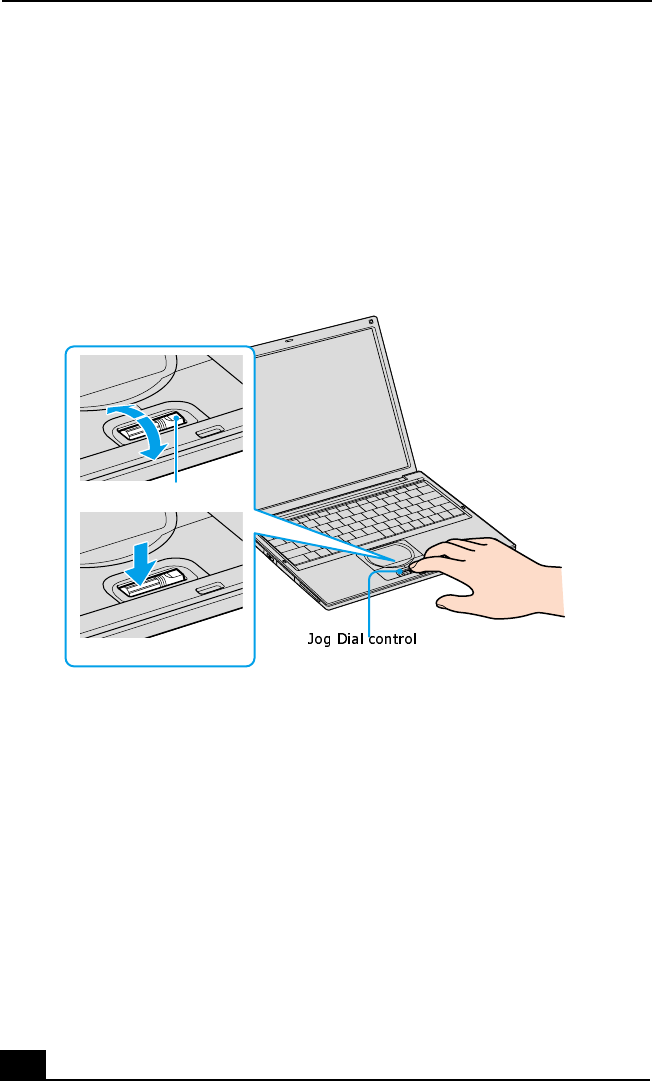
Change text in this variable definition to document title.
20
Using the Jog Dial Control
Your computer is equipped with a Jog Dial™ control on the bottom center
portion of the unit. The Jog Dial control enables you to open an application,
folder, or document from a predefined list by rotating and pressing the Jog Dial
control. In addition, when you press the Jog Dial control, you can turn on your
computer automatically and start the selected application or document.
The Jog Dial control window always appears in the display. It is either in the
launcher mode or in the guide mode.
For information on how to change the Jog Dial control’s settings, right-click the
Jog Dial control icon in the taskbar, and click Help Topics.
Launcher mode
The Jog Dial control window is in launcher mode until a software application is
launched or the Jog Dial control window becomes active. When an arrow is
displayed next to an item in the Jog Dial control window, you can display a
submenu of that item by selecting it and pressing the Jog Dial control button.
Using the Jog Dial Control
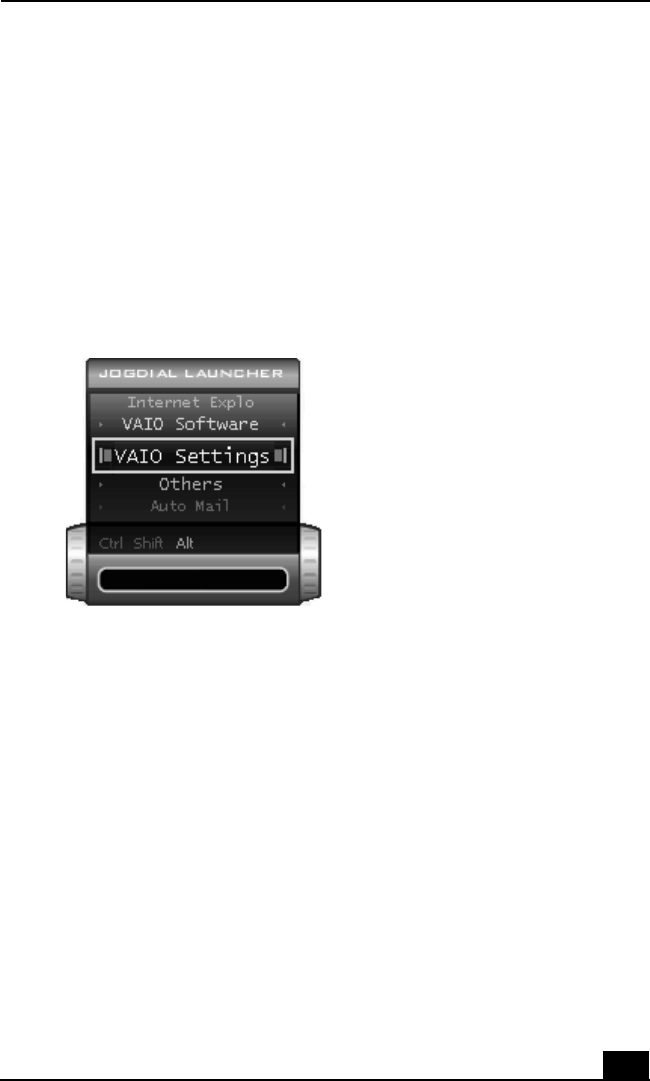
Using the Jog Dial Control
21
Using Launcher mode
To use the Jog Dial control, double-click the Jog Dial control window or the Jog
Dial control icon in the taskbar. Alternatively, you can press the Jog Dial control
while pressing the Ctrl key on the keyboard to switch to the launcher mode.
1Turn the Jog Dial control to select the item you want, and press the Jog Dial
control. The window switches to the guide mode and shows the Jog Dial
control’s function.
2Turn or press the Jog Dial control to use the desired function.
Guide mode
The Jog Dial control window is in the guide mode when software is in use and
the software window is active. Depending on the software you are using, you can
select items from the displayed list using the Jog Dial control. Some Sony
software applications have two modes in List View, Simple Menu, and Full
Menu. You can switch the mode by pressing the Shift key while turning the Jog
Dial control.
Using the Jog Dial control with Sony software
If Sony software that supports the Jog Dial™ control is active, you can use the
Jog Dial’s functions that are allocated to that software. For more information on
functions allocated to software, see the software application’s online Help.
Jog Dial Launcher Dialog Box

Change text in this variable definition to document title.
22
Using the Jog Dial control with other software
If the software you are using does not support the Jog Dial control, you can still
perform the following functions:
* Some software applications do not support these functions.
Using a dialog box
When a window such as Screen Properties is active, the Dialog box is displayed
in the Jog Dial™ window. You can select an item in the window by rotating the
Jog Dial control. Pressing the Jog Dial control is the equivalent of pressing Enter.
Action Description
Maximize Window* Press the Jog Dial control button to maximize the size
of the active window. Press it again to return to
normal window size.
Minimize Window* Press the Jog Dial control button to minimize the size
of the active window. Press it again to return to
normal window size.
Finish Window* Press the Jog Dial control button to close the active
application.
Scroll* Press the Jog Dial control button to begin scrolling
within the active window.
Jog Dial Launcher Press the Jog Dial control button to return the Jog Dial
control to Jog Launcher mode.
Menu Bar Press the Jog Dial control button, and then use the Jog
Dial control to scroll through the active window’s
toolbar.
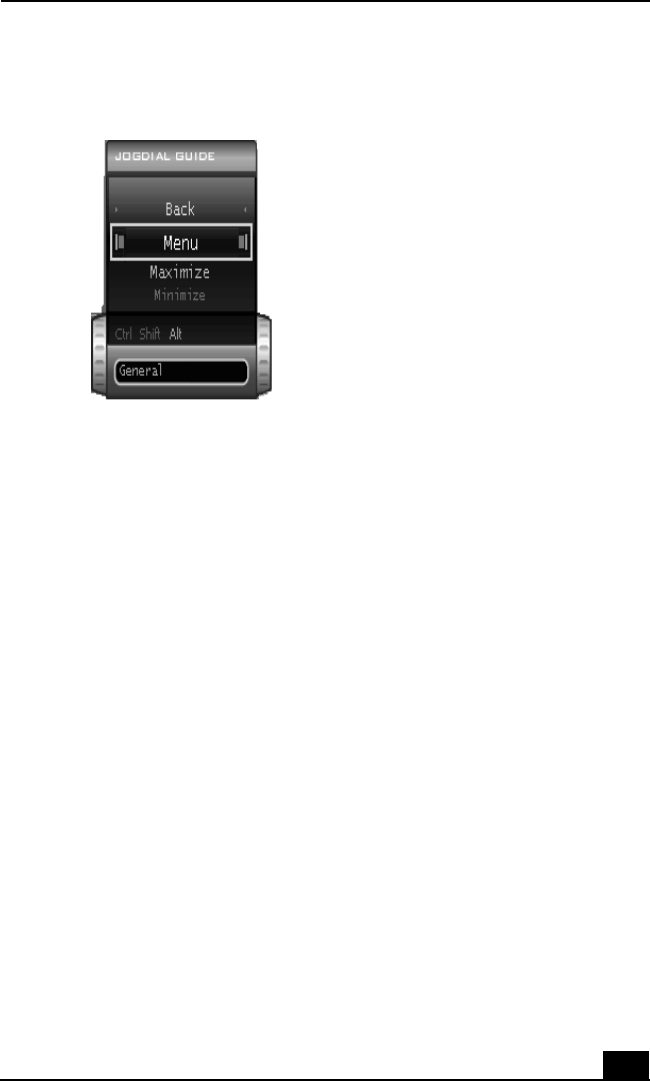
Using the Jog Dial Control
23
Internal timer
You can use the internal timer to start an application at a specific time. When set,
the time can launch applications even when the computer is turned off.
1Rotate or push the Jog Dial™ control, and select VAIO Action Setup in the
Jog Dial Launcher window.
2Click Timer from the left menu, and then click the clock icon.
3Select either Recommended Settings, Program Files, All Files, or Drag &
Drop from the left menu, then select the file or application you want to
launch in the right window.
4Click Next until the One-Time-Only Setting dialog box appears.
5Select the Date and Time and click Next twice.
6Click Finish, and close the VAIO Action Setup window.
Jog Dial Guide Dialog Box

Change text in this variable definition to document title.
24
Using Memory Stick Media
This new compact, portable, and versatile recording medium has a data capacity
exceeding that of a floppy disk. The media is specially designed for exchanging
and sharing digital data with compatible products. Because it is removable, you
can use the media for external data storage.
Types of Memory Stick media
Your computer uses two types of Memory Stick® media:
❑MagicGate™ Memory Stick media (hereafter referred as MG Memory
Stick media), is provided with copyright protection. (The MG Memory Stick
media are colored white.)
❑Memory Stick media, does not have the same copyright protection as
MagicGate. (The Memory Stick media are colored purple.)
For music, which requires copyright protection, you can only use MG Memory
Stick media. You can also use compatible MagicGate devices to record and play
back music when they are connected to your computer.
You can store mixed data on the Memory Stick media. For example, you can
copy an image onto MG Memory Stick media that already contains music.
What is MagicGate?
MagicGate technology is copyright protection that consists of authentication and
encryption technology. Authentication technology ensures that protected content
is only transferred between compliant devices and media. Protected content is
recorded and transferred in an encrypted format to prevent unauthorized
duplication or playback.
To insert a Memory Stick media
1Hold the Memory Stick media with the label facing up and the arrow facing
toward the Memory Stick® media slot.
2Carefully insert the Memory Stick media into the slot until it clicks into
place.
✍Ensure that the MG Memory Stick media has the MG mark .
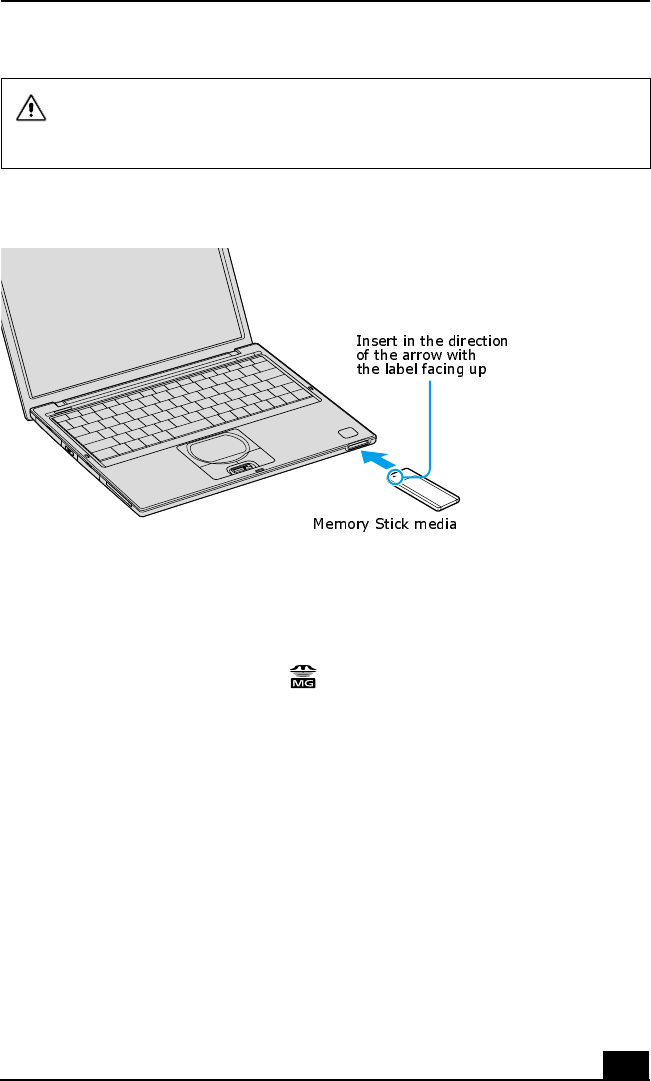
Using Memory Stick Media
25
To view the contents of Memory Stick media
1Click Start on the Windows® taskbar, and then My Computer.
2Click the Sony Memory Stick icon. The Sony Memory Stick window
appears, displaying the contents of your MemoryStick media.
To remove a Memory Stick media
1Wait a minimum of 10 seconds after the media finishes reading or writing
data before removing it. If the media is removed prematurely, an error
message appears, prompting you to continue or exit. Reinsert the media into
the slot and press Enter to continue. This enables the media to finish reading
or writing data.
2Make sure the Memory Stick indicator is off. When the indicator is off, the
Memory Stick media is not being accessed.
Inserting the media in the wrong direction may damage the connector pins.
To avoid damaging the computer or the Memory Stick Media, do not force
the Memory Stick media into the slot.
Inserting Memory Stick
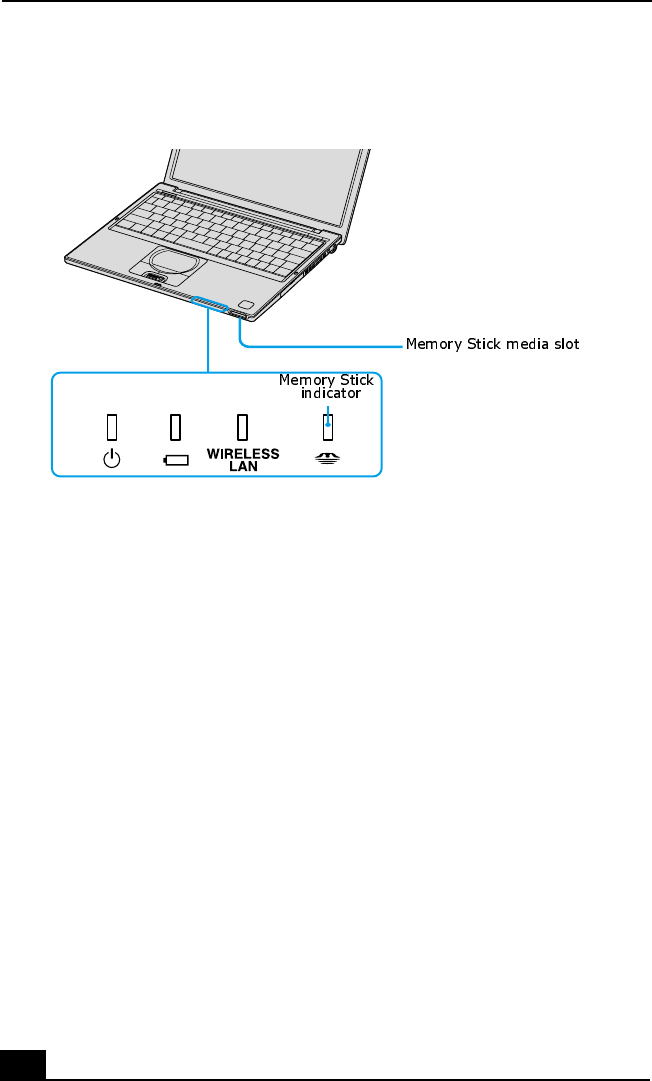
Change text in this variable definition to document title.
26
3Push the media in toward the computer.
4When the media ejects, pull it out. The Memory Stick media may eject
completely from the slot.
Notes on using Memory Stick media
❑When the media’s write-protect tab is set to LOCK, you cannot record or
erase data.
❑Before using Memory Stick media, you should back up important data.
❑You can enjoy video clips that you have recorded with compatible Memory
Stick digital camcorders.
❑The media slot accommodates one media at a time.
❑To copy images from a digital video camera via Memory Stick® media, see
“Connecting an i.LINK Audio-Video Device” for more information.
❑Only MG™ Memory Stick media can be used with copyright protected data
like music.
❑Do not remove the media or turn off the power while the access light is on.
Memory Stick media indicator

Using Memory Stick Media
27
❑Do not use the media in locations that are subject to static electricity or
electrical noise.
❑Do not touch the media connector with your finger or metallic objects.
❑Do not attach labels other than the supplied label to a media.
❑Do not bend, drop, or shock the media.
❑Do not disassemble or modify the media.
❑Do not allow the media to get wet.
❑Do not use or store the media in a location that is subject to:
❑Extremely high temperatures, such as in a car parked in the sun.
❑Direct sunlight.
❑High humidity or places with corrosive substances.
❑To prolong the life of the media, use the supplied storage case. See the
instructions supplied with your media for more information on its use.
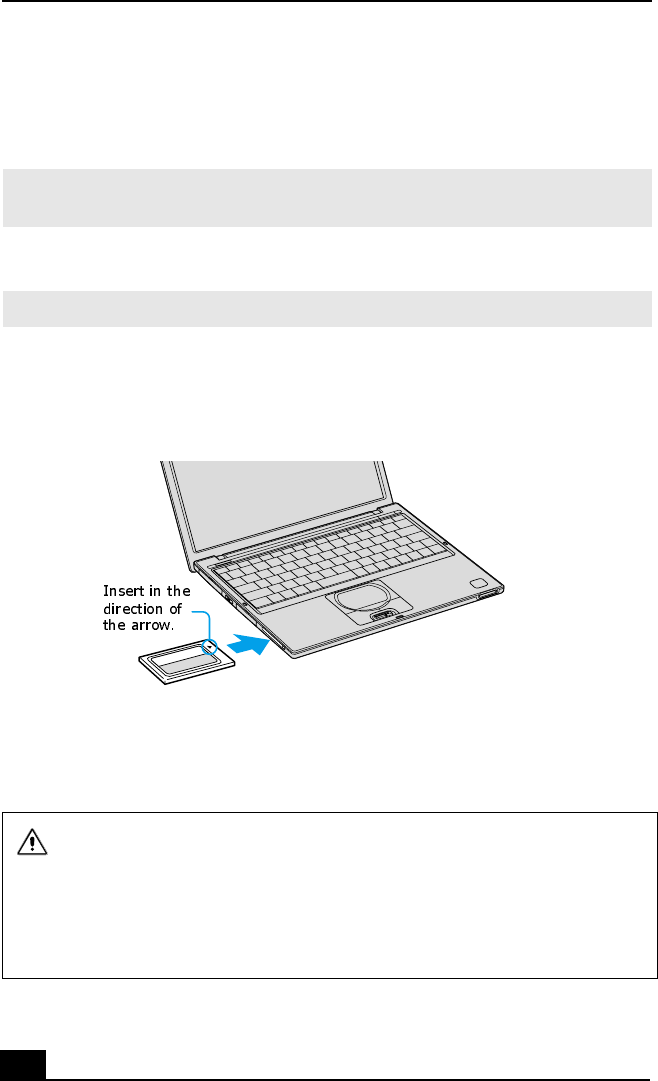
Change text in this variable definition to document title.
28
Using PC Cards
Your computer includes a PC Card slot, which enables you to connect portable
external devices, such as an optical disc drive.
To insert PC card
1Insert the PC Card into the PC Card slot with the front label facing up.
2Gently push the PC Card into the slot until it is firmly seated in the port and
the release button pops out.
✍The PC Card slot accommodates a Type I or Type II PC Card. This slot is compatible
with Card Bus. Type III PC Cards are not supported.
✍You do not need to shut down the computer before inserting or removing a PC Card.
Inserting PC Card
Do not force a PC Card into the slot. It may damage the connector pins.
When a PC Card is inserted, do not place your computer in a bag or case.
Pressure or shock to a PC Card may damage your computer.
Touching the head of the PC Card will not cause damage to the connector
pins, but damage can occur if the head of the PC Card is sticking out of the
computer while the unit is being transported.
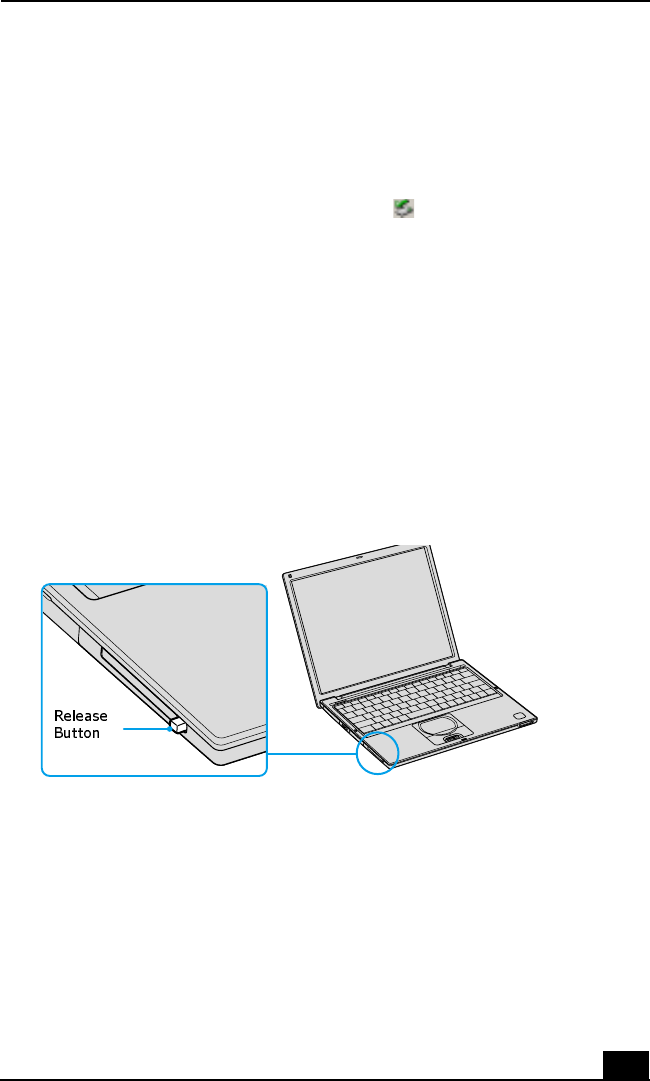
Using PC Cards
29
To remove a PC Card while your computer is on
Failure to follow this procedure may result in a malfunction.
1Before disconnecting this drive, close all active applications to help prevent
data loss.
2Double-click the Safely Remove Hardware icon in the taskbar. The
Safely Remove Hardware window appears.
3In the Hardware devices box, select the appropriate PC Card name if it is not
already selected, and click Stop. The Stop a Hardware device window
appears.
4Make sure the appropriate PC Card name is selected, and click OK. A
message appears stating it is safe to remove the hardware.
5Press the Release button. The PC Card pops out.
6Gently grasp the PC Card and pull it out.
Notes on PC Cards
❑For some PC Cards, if you alternate between normal power operation and
the Standby or Hibernate power management modes while the card is
inserted, you may find that a device connected to your system is not
recognized. Restart your system to correct the problem.
Release Button

Change text in this variable definition to document title.
30
❑Some PC Cards may require that you disable idle devices when using the PC
Card. You can use Sony Notebook Setup to disable devices. See “Displaying
the Sony Notebook Setup Screen” for more information.
❑Be sure to use the most recent software driver provided by the PC Card
manufacturer.
❑If an exclamation mark (!) appears on the Device Manager tab in the System
Properties dialog box, remove the software driver, and reinstall it.
❑You may not be able to use some PC Cards or some functions of the PC Card
with this computer. If you have difficulty inserting a card, check that you are
orienting the card correctly. See the manual supplied with your PC Card for
more information on its use.

Using Power Saving Modes
31
Using Power Saving Modes
When you use a battery as the power source for your computer, you can use the
power management settings to conserve battery life. In addition to the normal
operating mode, which enables you to turn off specific devices, your computer
has two distinct power saving modes: Standby and Hibernate. When using battery
power, the computer automatically enters Hibernate mode when the remaining
battery charge drops below 5 percent, regardless of the power management
setting you select.
Normal mode
Normal mode is the normal state of your computer when it is in use. The power
indicator displays green when your computer is in this mode. To save power, you
can turn off a specific device such as the LCD or the hard disk.
Standby mode
In Standby Mode the computer saves the current state of the system in RAM and
switches off power to the CPU. The amber power indicator flashes in this mode.
To activate Standby mode
1Press the key combination Fn+Esc. You can also use the PowerPanel™
utility to enter Standby mode.
2Press any key to return to normal mode.
Hibernate mode
In the Hibernate mode, the state of the system is saved on the hard disk drive and
power is turned off. The power indicator is off in this mode.
✍If the battery level falls below 10 percent, you should either attach the AC adapter to
recharge the battery or turn off your computer and insert a fully charged battery.

Change text in this variable definition to document title.
32
To activate Hibernate mode
1Press the key combination Fn+F12, or press the power button and release it
immediately. The “Save to Disk Manager” screen appears, and the computer
enters Hibernate mode.
2Press the power button to return to normal mode.
Notes on power saving modes
❑Standby uses more power than Hibernate.
❑Standby requires less time than Hibernate to return to normal mode.
✍Do not move the computer until its power indicator turns off.
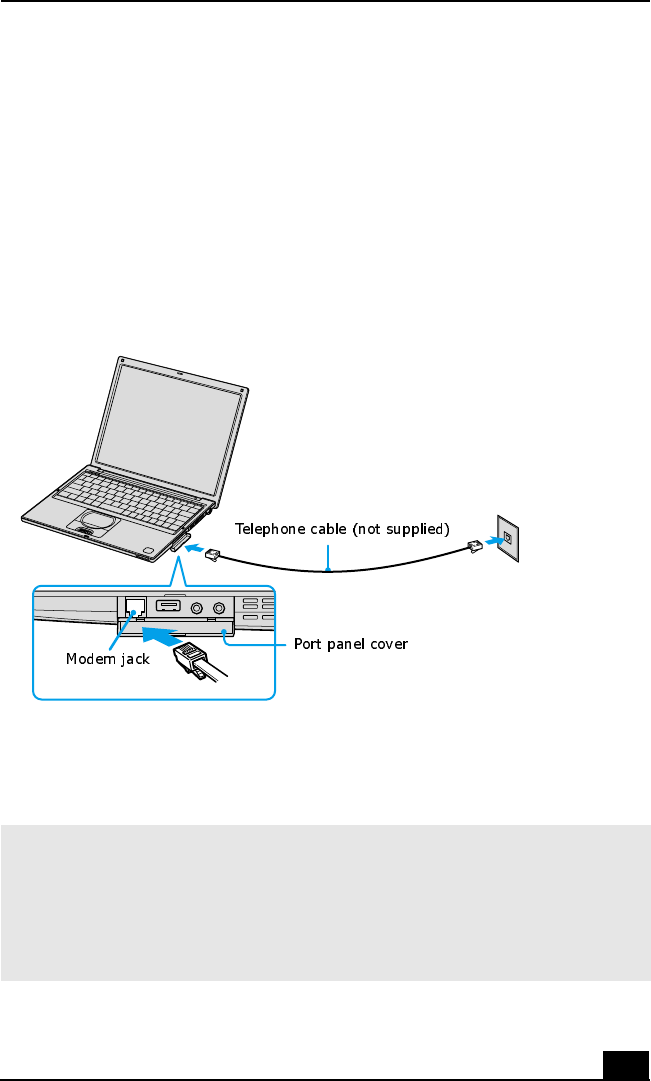
Connecting a Telephone Cable
33
Connecting a Telephone Cable
You need to connect a telephone cable (not supplied) to register your VAIO®
computer, use online services and the Internet, and use Sony Computing Support.
To connect a telephone cable
1Open the port panel on the right side of the computer, and locate the modem
jack.
2Plug one end of the telephone cable into the Modem jack. Make sure it clicks
into place.
3Plug the other end into the wall jack.
Plugging in Telephone Jack
✍Your computer does not work with party lines, cannot be connected to a coin-
operated telephone, and may not work with multiple phone lines or a private branch
exchange (PBX). Some of these connections may result in excess electrical current
and could cause a malfunction in the internal modem.
If you connect a phone line coming through a splitter, the modem or connected
device may not work properly.
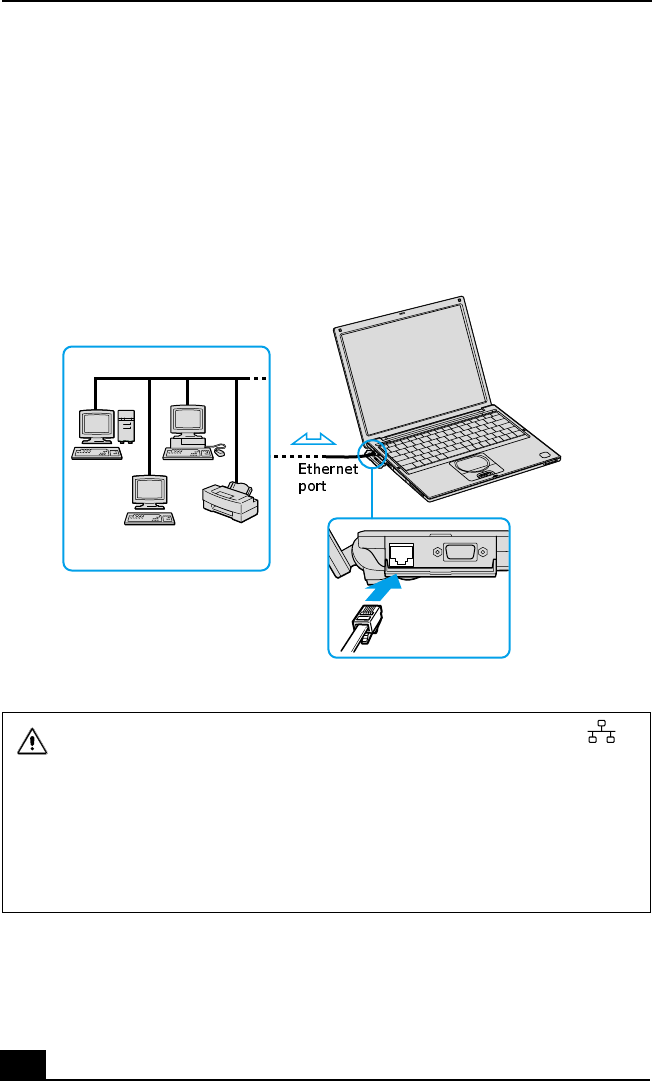
Change text in this variable definition to document title.
34
Connecting to a LAN
You can connect your computer to 10BASE-T and 100BASE-TX-type Local
Area Networks (LANs) by using the computer’s Ethernet port. For the detailed
settings and devices needed to connect to the network, ask your network
administrator.
Connecting to LAN
Warning: Only connect 10BASE-T and 100BASE-TX cables to the
Ethernet port. Do not connect any other type of network cable or a
telephone cable. Connecting cables other than those listed above may result
in an electric current overload and could cause a malfunction, excessive
heat, or fire in the port. To connect the unit to the network, contact your
network administrator.
If you enable Wake on LAN, the power saving mode will be switched to
Standby mode.

Connecting to a LAN
35
To set up a network
1From the Start menu, click Control Panel. The Control Panel window
appears.
2Click Network and Internet Connections. The Network and Internet
Connections window appears.
3Under “Pick a task,” click “Set up or change your home or small office
network,” depending on your configuration. The Network Setup Wizard or
the Location Information dialog box appears, depending on your choice.
4Follow the on-screen instructions.
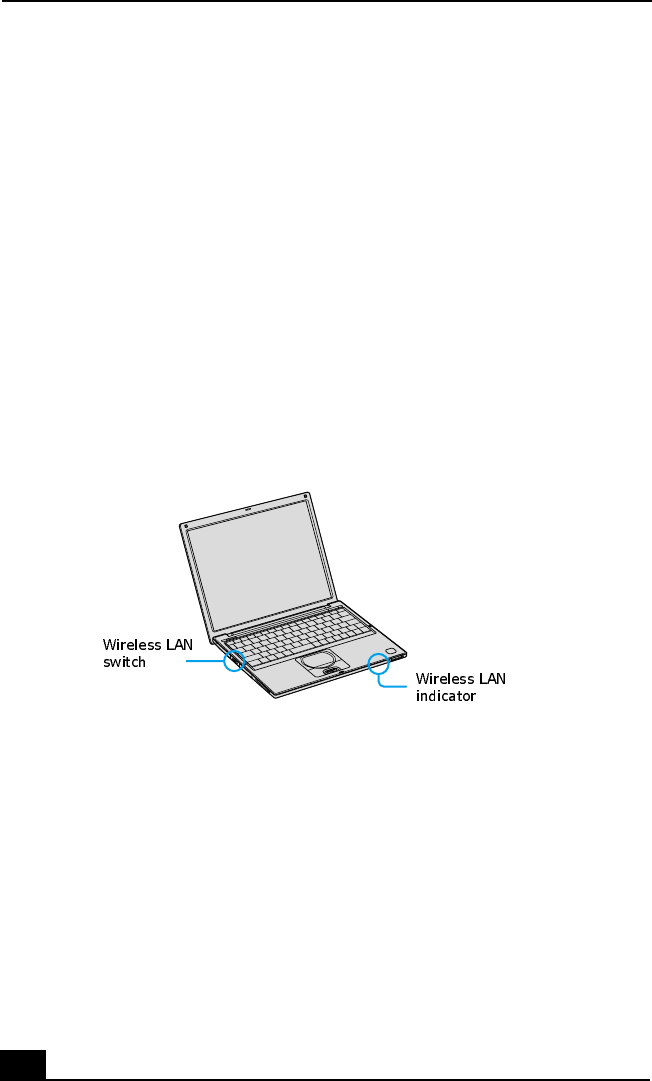
Change text in this variable definition to document title.
36
Connecting to a Wireless LAN
Your computer is equipped with a built-in mini PCI card that allows for wireless
connections. With Sony’s Wireless Local Area Network (LAN) functionality, all
compatible digital devices can communicate freely without cable connections. A
Wireless LAN is a network in which a mobile user can connect to a LAN through
a wireless (radio) connection. You can opt to purchase a Wireless LAN Access
Point to set up a LAN.
Turning On Wireless LAN
To enable Wireless LAN functionality, first locate the Wireless LAN switch that
is located on the left side of the computer. Move the switch to the ON position.
The Wireless LAN indicator on the bottom left front portion of the computer
lights up.
The Wireless LAN Access Point
The Wireless LAN Access Point, also called the access point, is designed for
building a Wireless LAN environment. If you purchase an access point, you can
easily build a wireless LAN environment by plugging the access point into an
AC power outlet, and using the provided software with compatible devices.
Because a wireless LAN configuration requires no wiring, you can operate
multiple computers more freely than ever before.
Connecting to a wireless LAN
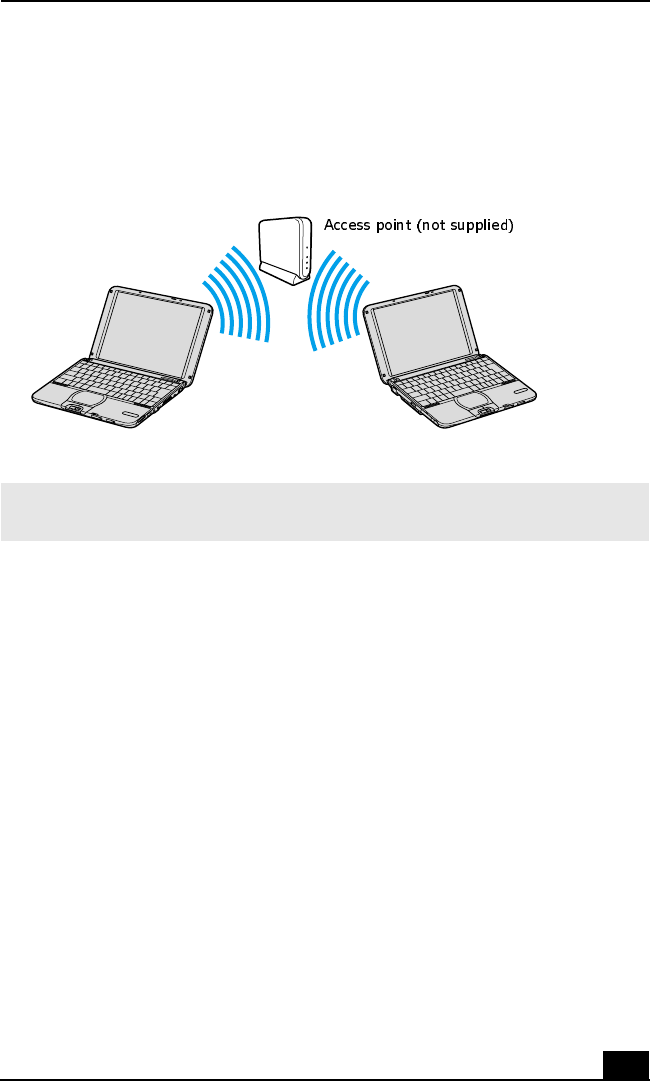
Connecting to a Wireless LAN
37
You can also connect an access point to a telephone line, Integrated Services
Digital Network (ISDN) router, cable modem, or Digital Subscriber Line (xDSL)
modem to share access to the Internet among multiple computers.
Communicating with an Access Point (infrastructure)
An infrastructure network is one that extends an existing wired local network to
wireless devices by providing an access point. The access point bridges the
wireless and wired LAN, and acts as a central controller for the Wireless LAN.
The access point coordinates transmission and reception from multiple wireless
devices within a specific range.
To communicate with an access point [[Cannot confirm steps yet]]
1Locate the Wireless LAN switch that is located on the left side of the
computer. Move the switch to the ON position.
2From the Start menu, point to Connect To, and click Wireless Network
Connection. The Wireless network Connection Status window appears.
3Click Network and Internet Connections, and then Network Connections.
4Double-click the Wireless Network Connection icon. The Connect to
Wireless Network dialog box opens.
Communicating via Wireless LAN Access Point
✍For information on available Sony products, go to:
http://www.sonystyle.com/wirelesslan.
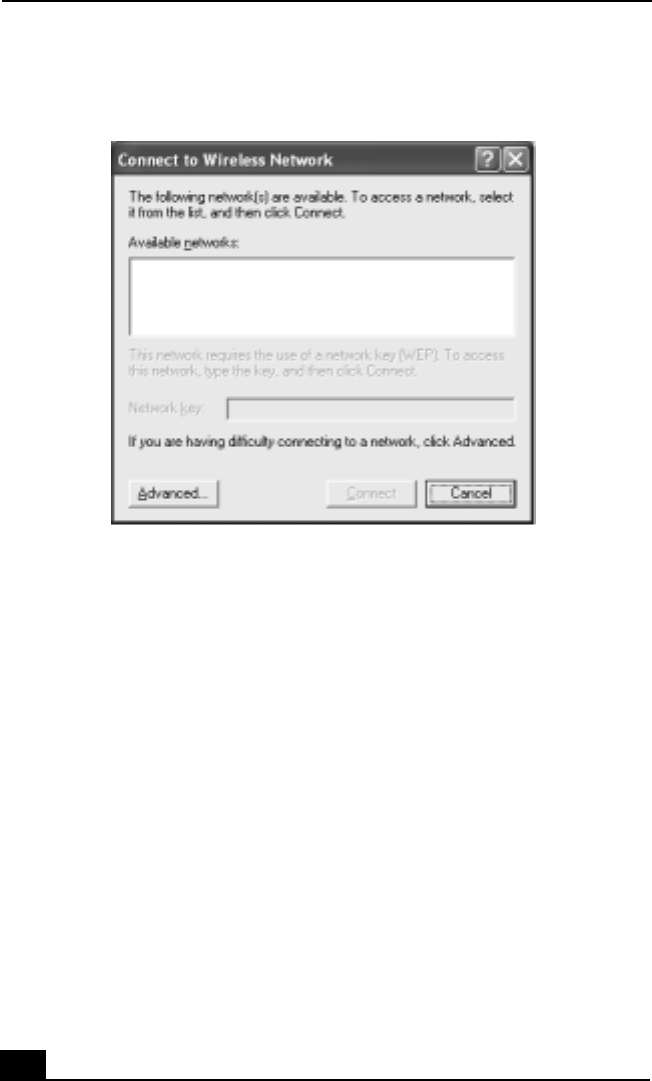
Change text in this variable definition to document title.
38
5Select a network from the Available Networks list box.
6Click Connect.
Communicating without an access point (ad-hoc)
An ad-hoc network is one in which a local network is created only by the
wireless devices themselves, with no other central controller or access point.
Each device communicates directly with other devices in the network. You can
set up an ad-hoc network easily at home.
To communicate without an access point [[Cannot confirm steps yet]]
1Turn on the Wireless LAN switch located on the left side of the computer.
The Wireless LAN indicator on the bottom left front portion of the computer
lights up. See “Turning On Wireless LAN” for more information.
2Click Start on the taskbar, point to Connect To, and click Wireless Network
Connection.
Connecting to a wireless LAN
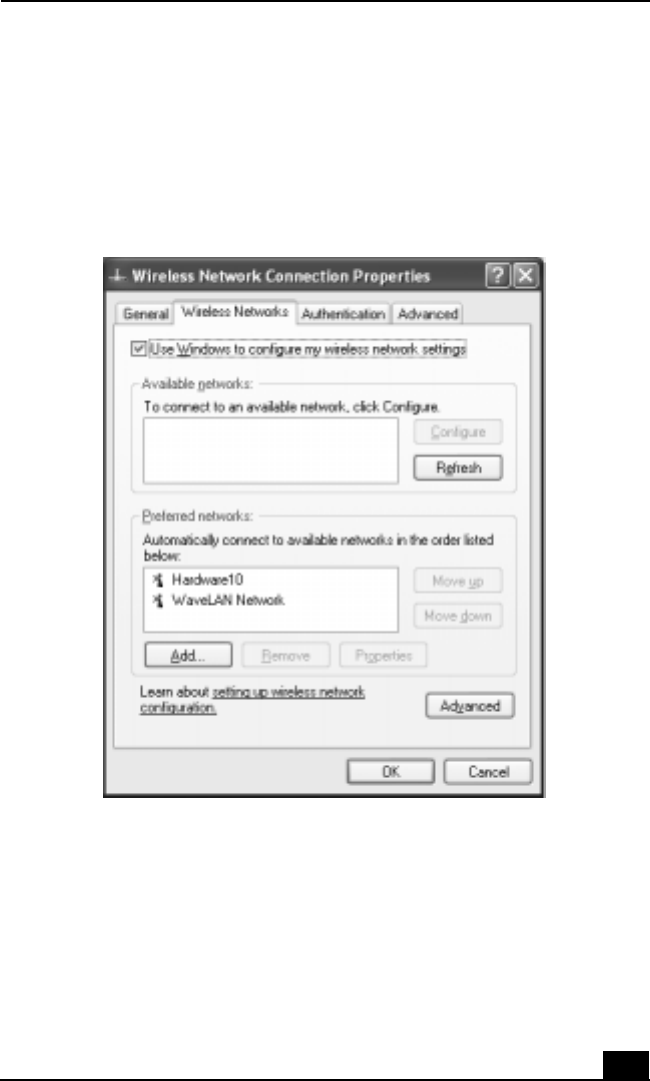
Connecting to a Wireless LAN
39
3Click View Available Wireless Networks. The Connect to Wireless Network
dialog box appears.
4Click the Advanced button. The Wireless Network Connection Properties
dialog box appears.
5Select the Wireless Networks tab.
6Click the Add... button. The Wireless Network Properties dialog box
appears.
7Enter a Network name (SSID). Choose a 6-digit name.
8Check the box to select Data encryption (WEP enabled).
Setting Wireless Network Connection Properties
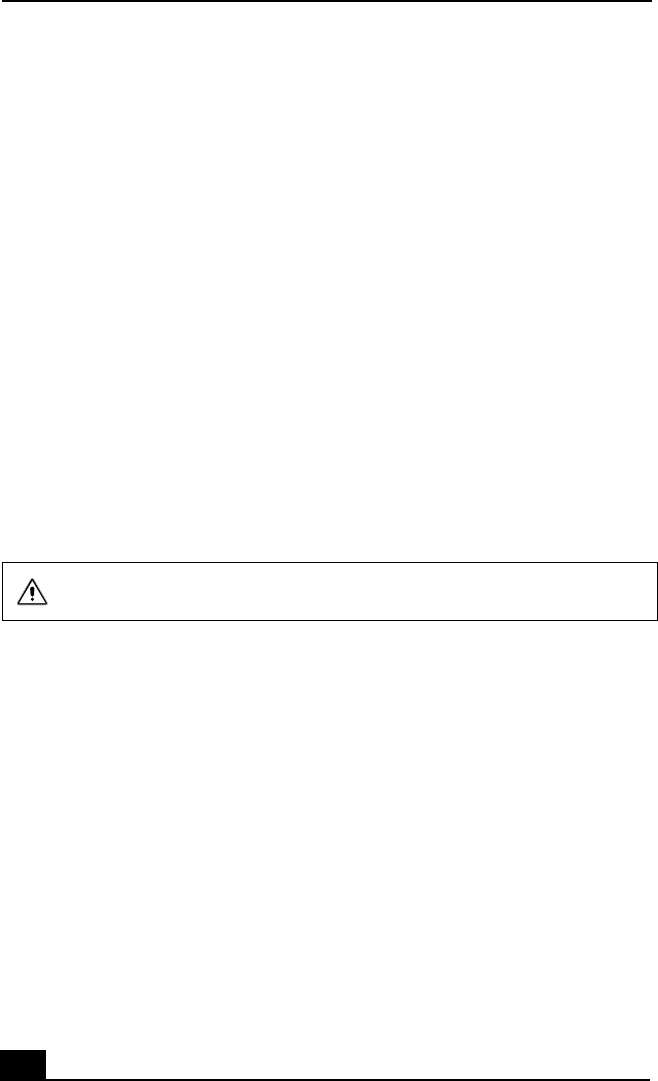
Change text in this variable definition to document title.
40
9Check the box to select Network Authentication (Shared mode).
10 Clear the box to deselect the option “The key is provided for me
automatically.” Some information boxes become visible.
11 Fill in the Network key. Choose a 5-digit name.
12 Click OK. Your new Network name appears in the Preferred networks
window.
13 Click Advanced. The Advanced dialog box appears.
14 Select the option “Computer-to-computer (ad hoc) networks only.”
15 Click Close.
16 Click OK.
Turning Off Wireless LAN
To turn off Wireless LAN functionality, locate the Wireless LAN switch that is
located on the left side of the computer, above the PC Card slot. Move the switch
to the OFF position. The Wireless LAN indicator on the bottom left front portion
of the computer turns off.
Notes on using Wireless LAN
❑Sony Wireless LAN devices support the IEEE802.11b standard. Devices
connecting to a Wireless LAN using the IEEE802.11a standard cannot
connect to devices using the IEEE802.11b standard.
❑Wireless LAN communication occurs on divided frequency bands known as
channels. Third-party Wireless LAN Access Point channels may be preset to
different channels from Sony devices.
❑If using a Wireless LAN Access Point, refer to connectivity information
contained in those instructions.
Turning off the Wireless LAN functionality while accessing remote
documents, files, or resources may result in data loss.

41
Connecting Peripheral Devices
You can add functionality to your notebook by connecting a variety of
peripherals, as discussed in the following sections:
❑Connecting a Floppy Disk Drive
❑Connecting a PC Card Bus Drive
❑Connecting an i.LINK Optical Disc Drive
❑Connecting a USB Mouse or Keyboard
❑Connecting a USB Device
❑Connecting a USB Printer
❑Connecting an i.LINK Audio-Video Device
❑Connecting an External Display
❑Connecting with another VAIO computer
❑Connecting External Speakers
❑Connecting a Microphone
❑Expanding Your Computer Capabilities

Change text in this variable definition to document title.
42
Connecting a Floppy Disk Drive
You can connect a floppy disk drive (not supplied) to a USB port on your
computer, port replicator, or docking station.
To connect a floppy disk drive
1Before connecting this drive, close any active applications to help prevent
data loss.
2Plug the USB connector into the USB port. The logo on the floppy disk
drive should face upward.
✍You do not need to shut down your computer before connecting or disconnecting a
floppy disk drive.
Before disconnecting the floppy disk drive, see “To disconnect a floppy disk drive
when the computer is on” for more information.
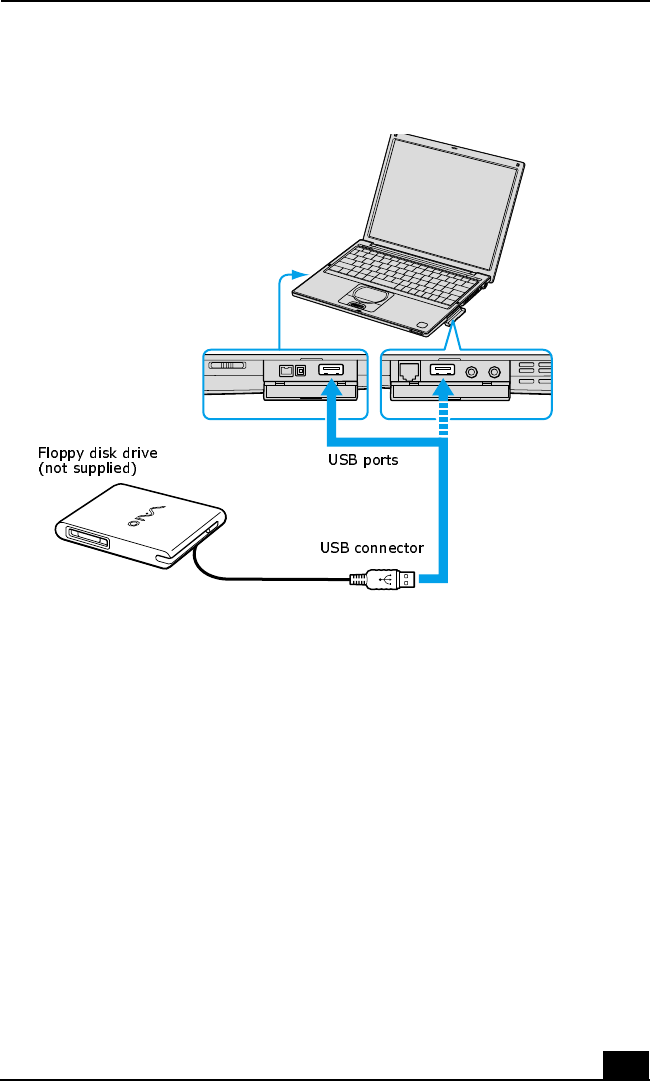
Connecting a Floppy Disk Drive
43
To insert a floppy disk into the floppy disk drive
1Hold the floppy disk with the label facing up.
2Gently push the floppy disk into the drive until it clicks into place.
Connecting an Floppy Disk Drive
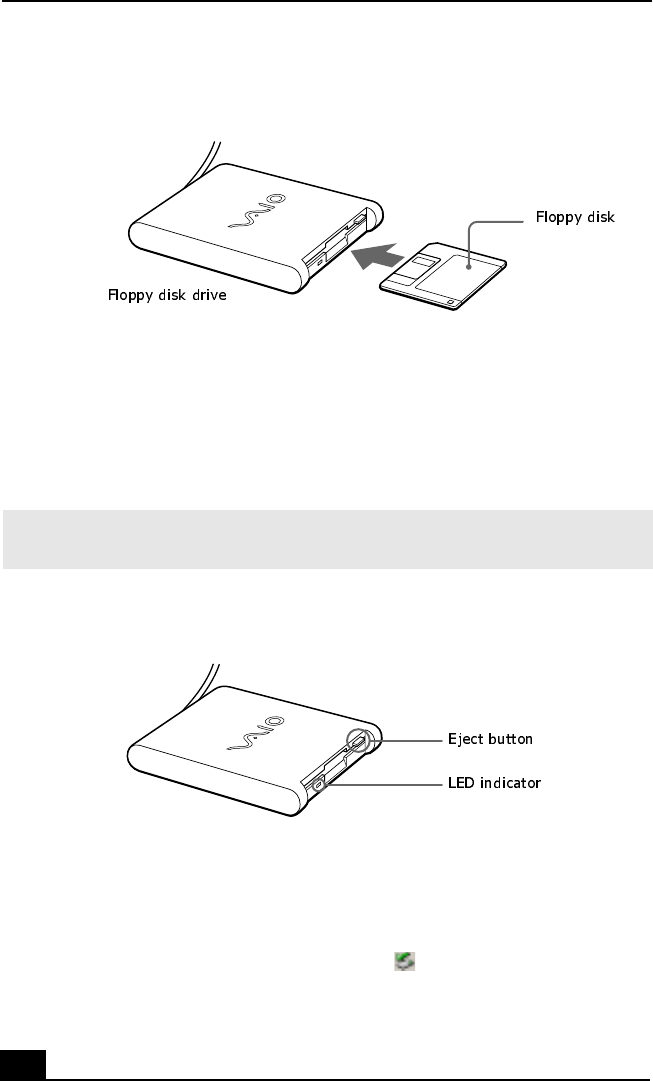
Change text in this variable definition to document title.
44
To remove a floppy disk from the floppy disk drive
1Close all applications that were opened from the disk and wait for the LED
indicator to turn off.
2Push the Eject button, and remove the disk.
To disconnect a floppy disk drive when the computer is on
1Before disconnecting this drive, close any active applications to help prevent
data loss.
2Double-click the Safely Remove Hardware icon in the taskbar. The
Safely Remove Hardware window appears.
Inserting a Floppy Disk
✍Do not push the Eject button when the LED indicator is turned on; otherwise, you
may lose data.
Removing a Floppy Disk
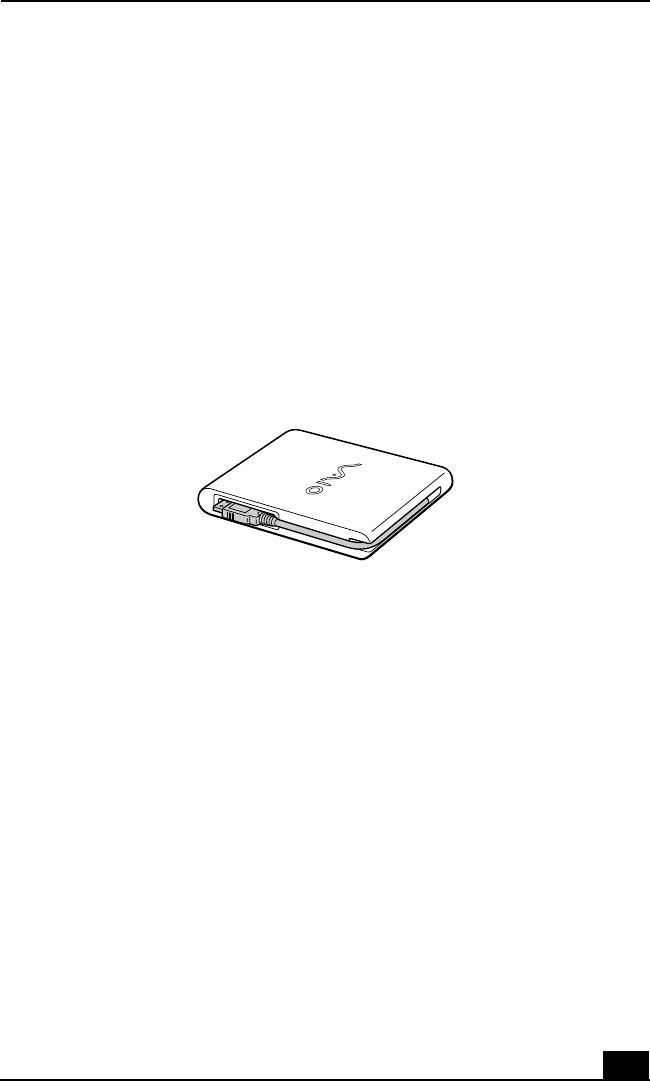
Connecting a Floppy Disk Drive
45
3In the Hardware devices box, select Y-E Data USB Floppy, and click Stop.
The Stop a Hardware device window appears.
4Make sure Y-E Data USB Floppy is selected, and click OK. A message
appears stating it is safe to remove the hardware.
5Unplug the floppy disk drive from the computer, port replicator, or docking
station.
To carry an floppy disk drive
❑Fold the floppy disk drive cable and connector into the side compartment on
the floppy disk drive.
Notes on handling floppy disks
❑Do not open the shutter manually and touch the surface of the floppy disk.
❑Keep floppy disks away from magnets.
❑Keep floppy disks away from direct sunlight and other heat sources.
Carrying an Floppy Disk Drive
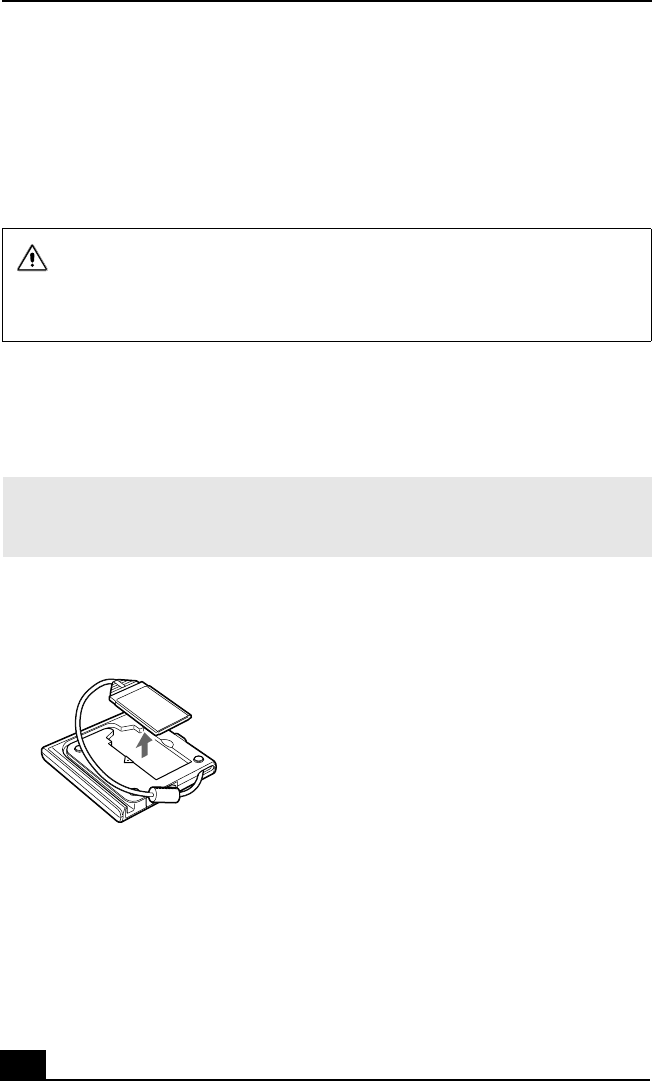
Change text in this variable definition to document title.
46
Connecting a PC Card Bus Drive
[[Cannot confirm steps yet]]
You can use an optional optical drive with your computer. If you use an optional
drive when your computer is running on battery power, the battery life will be
shorter. The drive draws power from the computer through a PC Card.
To connect an optical drive
Procedures for connecting an optical drive may vary, depending on the specific
drive you purchase. See the manual supplied with your optical drive for more
information on its installation and use.
1Remove the PC Card from the bottom side of the optical drive.
2Insert the PC Card into the PC Card slot with the logo facing up. See “Using
PC Cards” for details.
If you connect a non-Sony DVD drive to your VAIO® computer, the DVD
playback may not function properly. The DVD software (supplied) must
be installed to play a DVD.
For best performance, use a Sony compatible DVD drive.
✍You can connect an optical drive while the computer is on. For specific instructions
on using your supplied Application, Driver, and System Recovery CDs, see “Using
Your Recovery CDs” for more information.
Removing PC Card
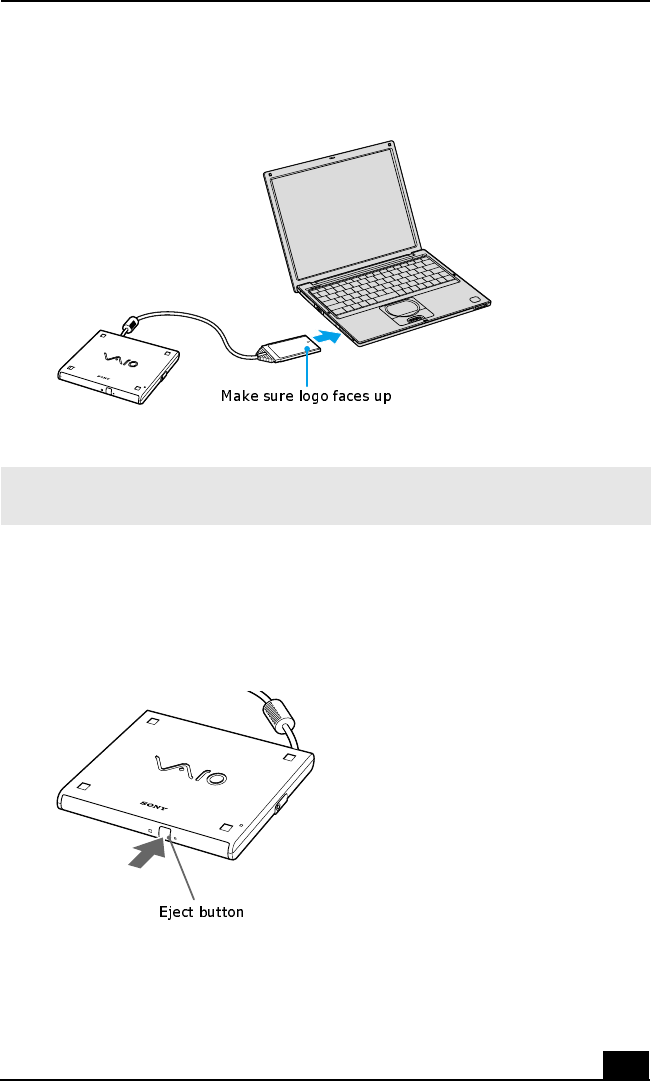
Connecting a PC Card Bus Drive
47
To insert a disc
1Press the Eject button. The disc tray slides out.
2Place the disc in the tray with the label facing up.
3Push the disc onto the hub until the disc clicks into place.
Inserting PC Card
✍A protective cover is attached to the lens of the optical drive at the factory. Before
using the optical drive, remove the protective cover.
Optical Drive
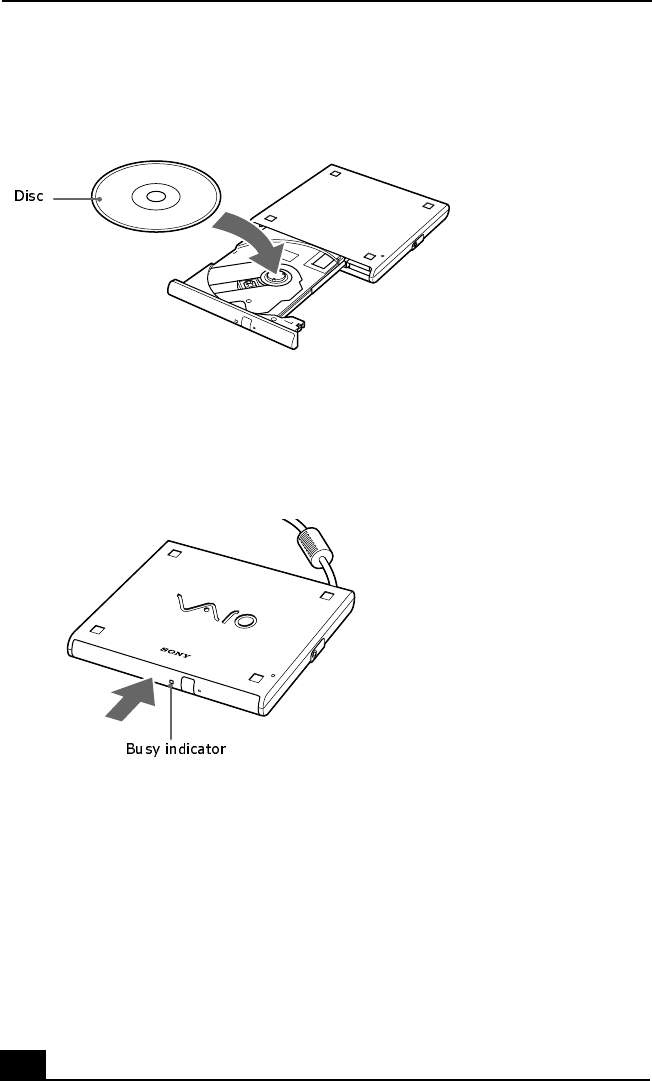
Change text in this variable definition to document title.
48
4Close the tray by pushing it in gently. The Busy indicator on the drive flashes
while your computer is reading data from the disc.
To remove the drive
Remove the PC Card from the computer. See “To disconnect a floppy disk drive
when the computer is on” for more information.
Inserting Disc
Flashing Busy Indicator

Connecting a PC Card Bus Drive
49
Notes on CD and DVD discs
Handling CD or DVD discs
❑Do not touch the surface of the disc.
❑Do not drop or bend the disc.
❑Avoid using adhesive labels to identify your discs. Adhesive labels may
come off while the disc is in use in your optical drive and damage to the unit.
Cleaning CD or DVD discs
❑Fingerprints and dust on the surface of a disc may cause data reading errors.
Proper care of the disc is essential to maintain its reliability. Do not use
solvents such as benzine, thinner, commercially available cleaners or anti-
static spray, as they may damage the disc.
❑For normal cleaning, hold the disc by its edge and use a soft cloth to wipe the
surface from the center outward.
❑If the disc is badly soiled, moisten a soft cloth with water, wring it out well,
and use it to wipe the surface of the disc from the center out. Wipe off any
remaining moisture with a dry soft cloth.

Change text in this variable definition to document title.
50
Connecting an i.LINK Optical Disc Drive
You can connect an i.LINK®* optical disc drive to your computer, port
replicator, or docking station. This computer is preinstalled with software that
enables you to create CDs and play DVD movies. The i.LINK optical disc drive
draws power from the computer through a peripheral cable. This peripheral cable
connects to both the i.LINK port and DC OUT jack on the computer.†
To connect an i.LINK optical disc drive
1Before connecting this drive, close any active applications to help prevent
data loss.
2Turn on power to the computer.
3Insert the L-shaped connector of the peripheral cable (supplied with the
i.LINK drive) into the matching jack on the i.LINK drive. Secure the
connector by turning the LOCK device clockwise.
* i.LINK is a trademark of Sony used only to designate that a product contains an IEEE1394
connection. The i.LINK connection may vary, depending on the software applications, oper-
ating system and compatible i.LINK devices. All products with an i.LINK connection may
not communicate with each other. Refer to the documentation that came with your compati-
ble i.LINK device for information on operating conditions and proper connection. Before
connecting compatible i.LINK PC peripherals to your system, such as a CD-RW or hard disk
drive, confirm their operating system compatibility and required operating conditions.
† If you connect and use an optional drive when your computer is running on battery power,
the battery life will be reduced.
✍If you use an optional drive when your computer is running on battery power, the
battery life will be shorter.
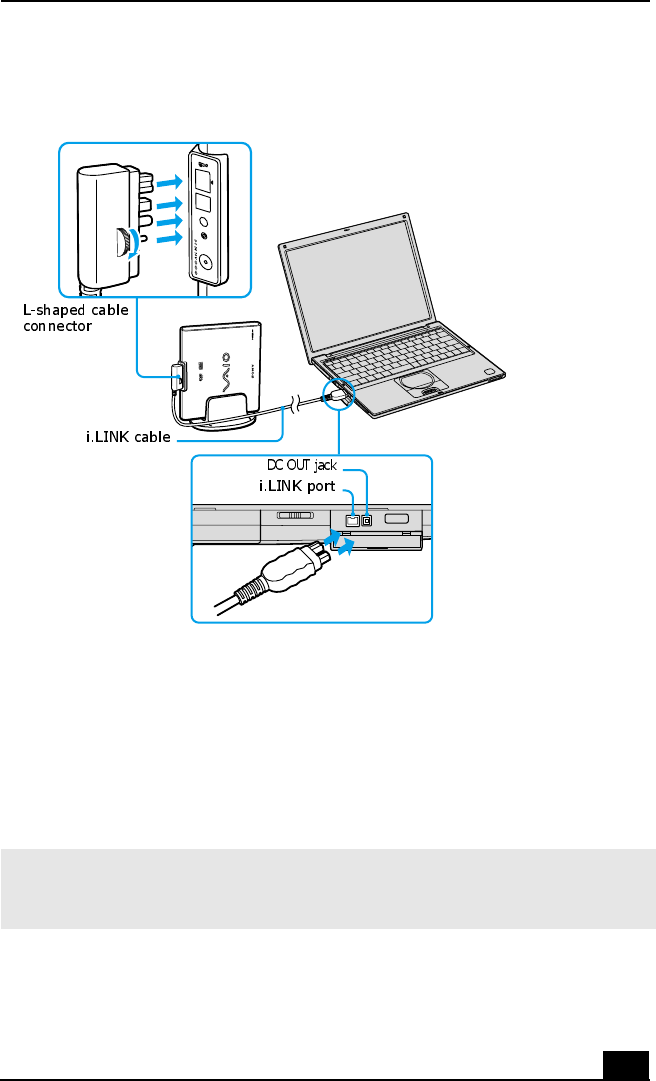
Connecting an i.LINK Optical Disc Drive
51
4Insert the straight-shaped, two-prong connector of the peripheral cable into
both the computer’s i.LINK port and DC OUT jack.
5The i.LINK drive’s power indicator lights up, and the computer
automatically detects and identifies the connected drive.
6Click Start on the Windows® operating system taskbar, and select My
Computer to verify that an icon for the i.LINK optical disc drive was added
in the window.
Connecting i.LINK optical disc drive
✍The Sony i.LINK optical disc drive is compatible only with certain Sony VAIO®
PCG series computers preinstalled with Microsoft® Windows® XP Home Edition or
Professional.

Change text in this variable definition to document title.
52
To disconnect an i.LINK optical disc drive
1Before disconnecting this drive, close any active applications to help prevent
data loss.
2Double-click the Safely Remove Hardware icon in the taskbar. The
Safely Remove Hardware window appears.
3In the Hardware devices box, select the appropriate i.LINK drive if it is not
already selected, and click Stop. The Stop a Hardware device window
appears.
4Make sure the appropriate i.LINK drive is selected, and click OK. A
message appears stating it is safe to remove the hardware.
5Unplug the i.LINK optical disc drive from the computer, port replicator, or
docking station.
Notes on using i.LINK optical disc drives
❑You can use the supplied Application Recovery, Driver Recovery, and
System Recovery CDs with an i.LINK optical disc drive. See “Application,
Driver, and System Recovery CDs” for more information.
❑Do not use an optional i.LINK optical disc drive and an optional optical disc
drive with PC Card at the same time. Connecting both drives may cause a
system malfunction.
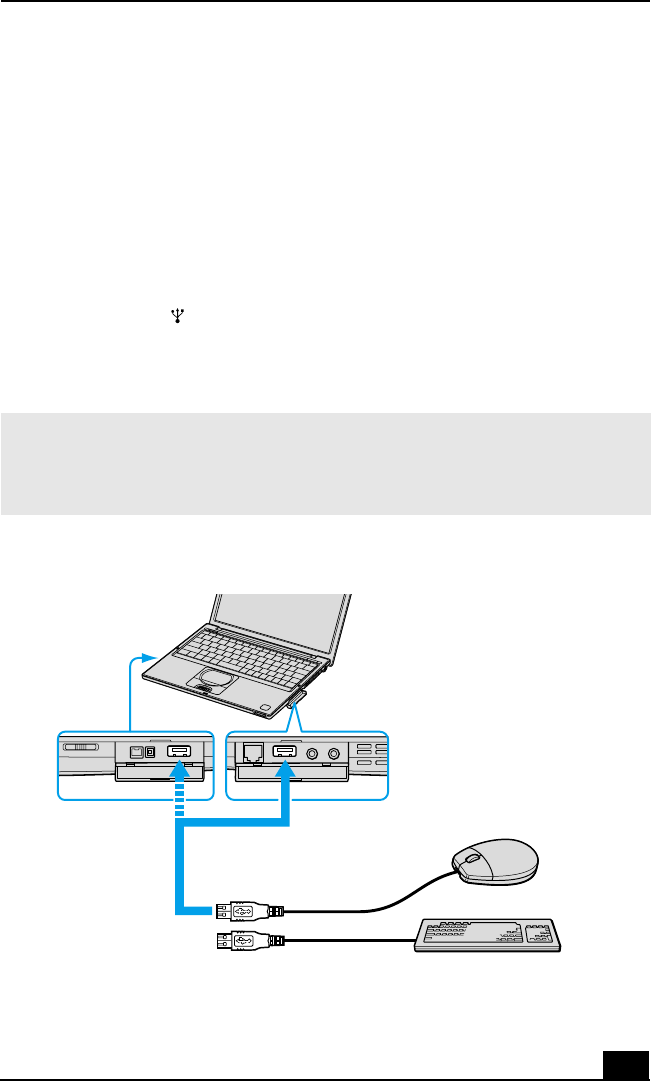
Connecting a USB Mouse or Keyboard
53
Connecting a USB Mouse or Keyboard
You can connect a universal serial bus (USB) mouse or keyboard to your
computer, port replicator, or docking station. Make sure the USB device is
compatible with the Windows® operating system.
To connect a USB mouse or keyboard
1Turn off your computer before you connect or disconnect the mouse or
keyboard.
2Locate the USB port on your computer, port replicator, or docking
station.
3Plug the mouse or keyboard cable into this port.
✍You can use a Sony USB mouse (not supplied) with this computer. The USB mouse
software driver is preinstalled; however, the first time you connect a mouse, on-
screen installation instructions may appear. Press Enter to complete the on-screen
instructions.
Connecting a USB Mouse or Keyboard

Change text in this variable definition to document title.
54
✍See the manual that came with your mouse or keyboard for more information on its
installation and use.
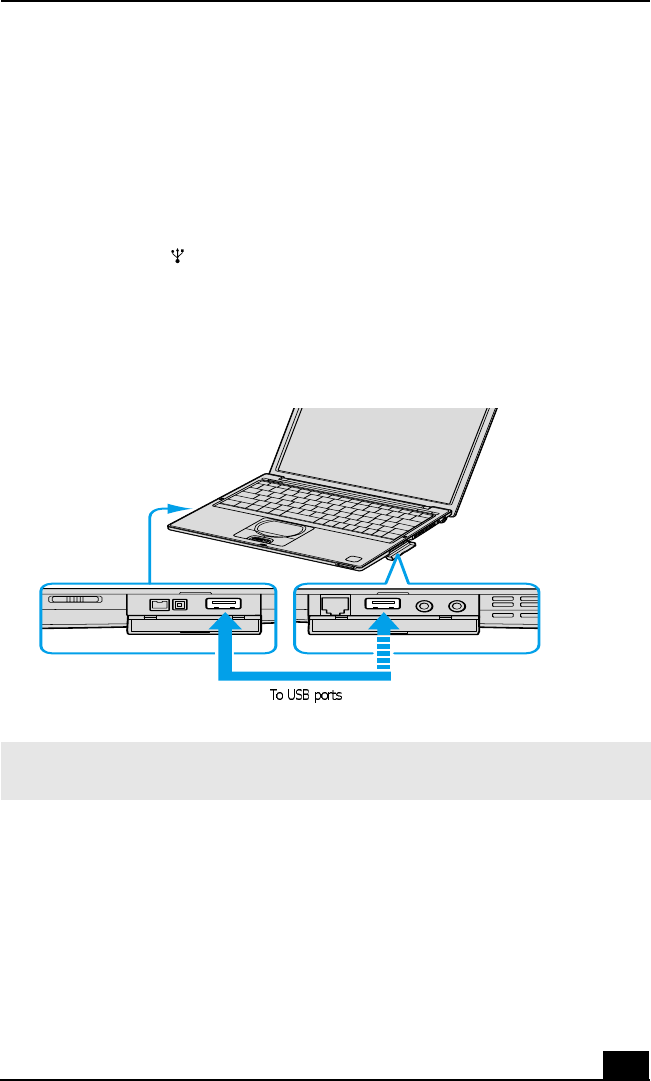
Connecting a USB Device
55
Connecting a USB Device
You can connect a universal serial bus (USB) device, such as speakers or
microphones, to your computer, port replicator, or docking station. Make sure the
USB device is compatible with the Windows® operating system.
To connect a USB device
1Locate the USB port.
2Plug the USB cable (not supplied) into this port, and plug the opposite end of
the cable into the USB device, if it is not already connected.
Connecting a USB Device to a USB Port
✍See the manual that came with your USB device for more information on its
installation and use.
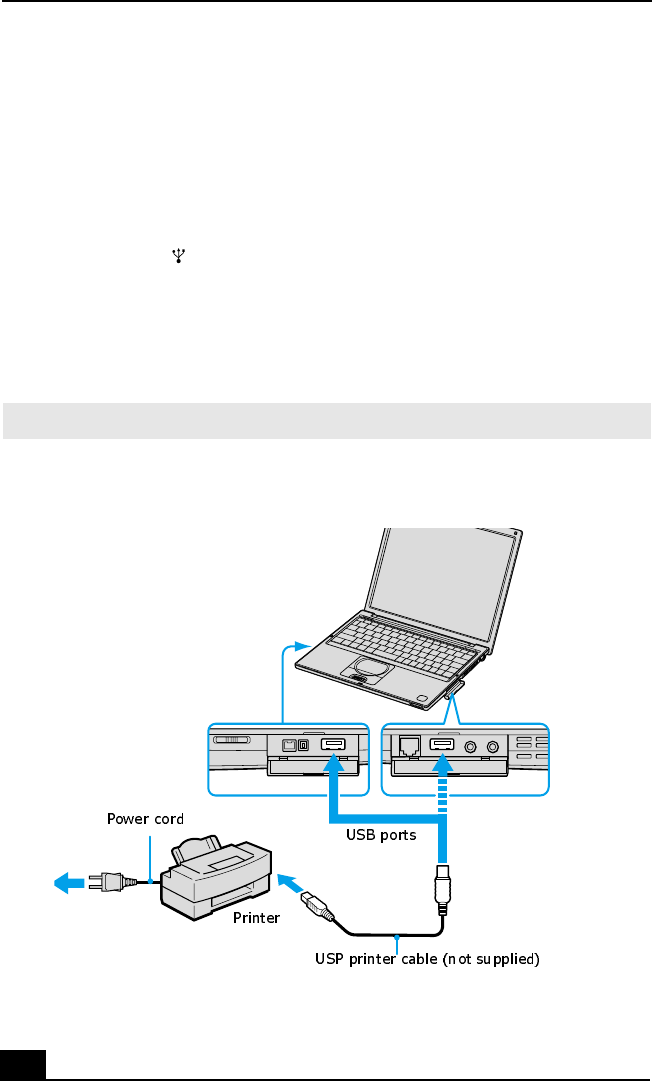
Change text in this variable definition to document title.
56
Connecting a USB Printer
You can connect a universal serial bus (USB) printer to your computer, port
replicator, or docking station. Make sure the USB device is compatible with the
Windows® operating system.
To connect to a USB printer
1Locate the USB port.
2Plug the USB printer cable (not supplied) into the USB port, and plug the
opposite end of the cable into the USB port on your printer.
3Make sure your computer’s printer settings are properly set. See “Displaying
the Sony Notebook Setup Screen” for more information.
✍To use a printer, you need to install the driver software that came with your printer.
Connecting a USB Printer Cable

Connecting a USB Printer
57
✍See the manual that came with your printer for more information on its installation
and use.
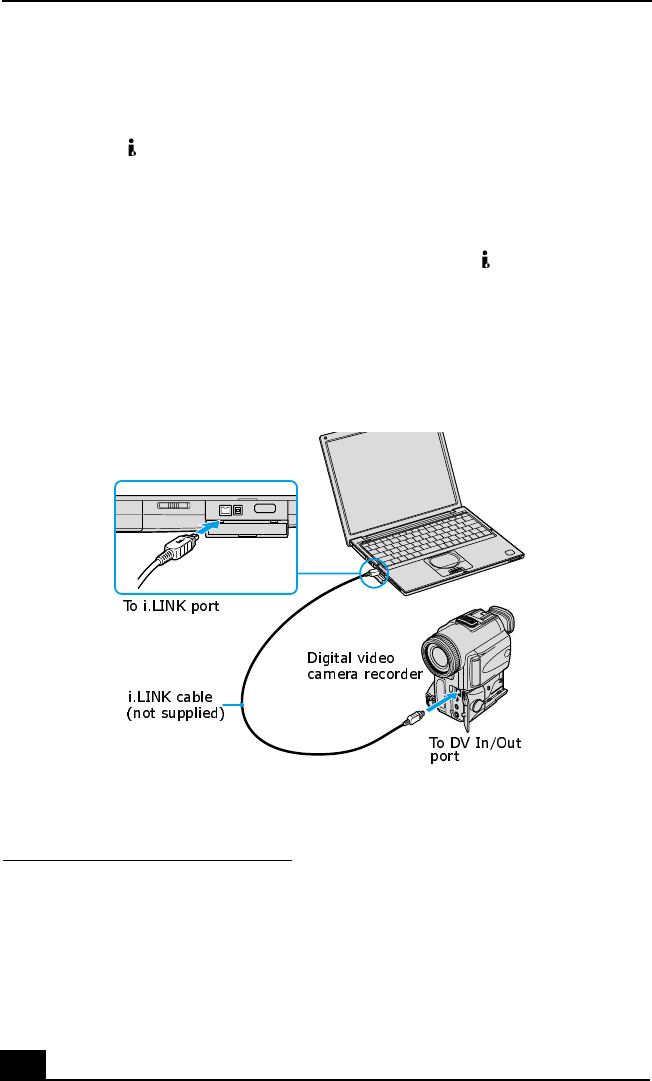
Change text in this variable definition to document title.
58
Connecting an i.LINK Audio-Video Device
You can connect an i.LINK®* enabled digital video camera recorder to the
i.LINK® S400 (IEEE 1394) port on your computer, port replicator, or docking
station.
To connect a digital video camera recorder
1Plug the i.LINK® cable (not supplied) into the i.LINK port on the
computer, port replicator, or docking station.
2Plug the opposite end of the i.LINK cable into the DV IN/OUT port on the
digital video camera recorder.
* i.LINK is a trademark of Sony used to designate that a product contains an IEEE 1394 con-
nector. The i.LINK connection may vary, depending on the software application, operating
system, and compatible i.LINK devices. All products with an i.LINK connection may not
communicate with each other. Refer to the documentation that came with your compatible
i.LINK device for more information on operating conditions and proper connection. Before
connecting compatible i.LINK PC peripherals to your system, such as a CD-RW or hard disk
drive, confirm their operating system compatibility and required operating conditions.
Connecting Digital Video Camera Recorder to i.LINK Port*

Connecting an i.LINK Audio-Video Device
59
Notes on connecting an i.LINK device
❑Only the Sony digital video camera port labeled DV IN/OUT or i.LINK are
i.LINK-compatible.
❑Do not connect more than one digital video camera at a time. The software
supplied with your computer will not recognize multiple cameras.
❑The i.LINK port does not supply power to external devices. If the external
device requires power from the i.LINK port, you cannot use the device with
the computer.
❑The computer supports transfer rates up to 400 Mbps; however, the actual
transfer rate is the lowest transfer rate of the external device.
❑The i.LINK features available may vary depending on the software
applications you use. See the documentation that accompanied your software
for more information.
❑See the manual that came with your digital video camera recorder for more
information on its installation and use.
* In this illustration, a Sony digital video camera recorder is connected to the computer.
Instructions for connecting a different type of digital video camera recorder may differ.
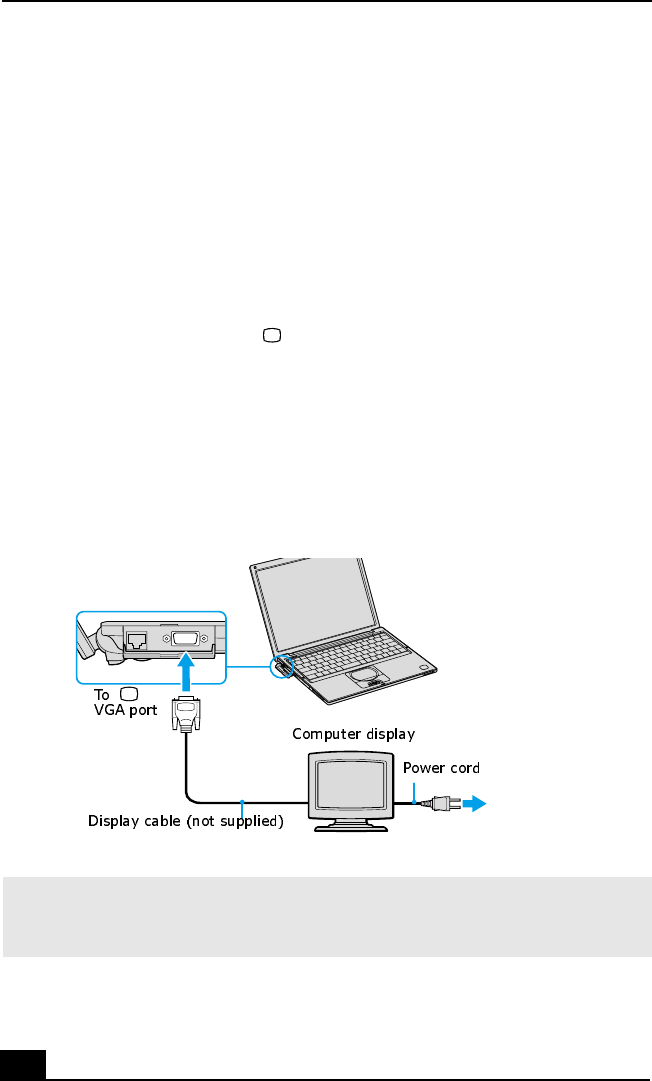
Change text in this variable definition to document title.
60
Connecting an External Display
You can connect any of the following external displays to your computer, port
replicator, or docking station:
❑Computer display (monitor)
❑Projector
To connect a computer display
1Turn off the computer before you connect the computer display.
2Locate the VGA (Monitor) port.
3Plug the display cable (not supplied) into the VGA (Monitor) port.
4Verify that the power cord is plugged into the computer display and an AC
outlet.
5Turn on all external devices before turning on the computer.
Connecting an External Computer Display
✍You cannot use the monitor port on your computer when the docking station is
connected to the computer; however, you can use the monitor port on the docking
station.
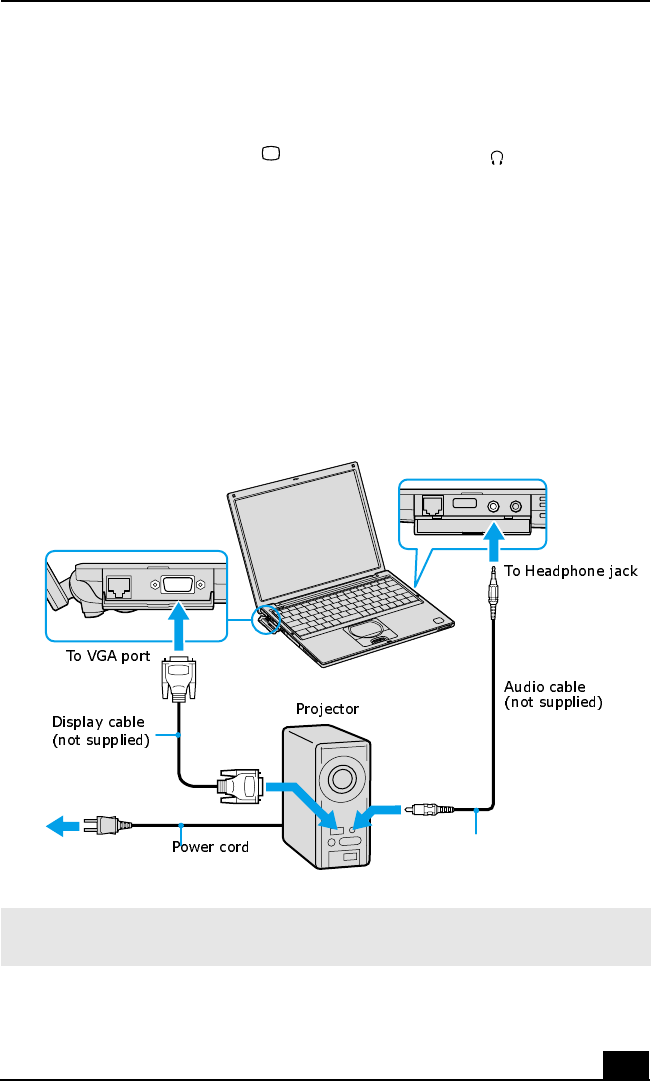
Connecting an External Display
61
To connect a projector
1Turn off the computer before you connect the projector.
2Locate the VGA (Monitor) port and the Headphone jack.
3Plug the display cable (not supplied) into the VGA port, and plug the
opposite end into the appropriate port on the projector.
4Plug the audio cable (not supplied) into the Headphone jack, and plug the
opposite end into the appropriate port on the projector.
5Verify that the power cord is plugged into the projector and an AC outlet.
6Turn on all external devices before you turn on the computer.
Connecting a Projector
✍See the manual that came with your projector for more information on its installation
and use.
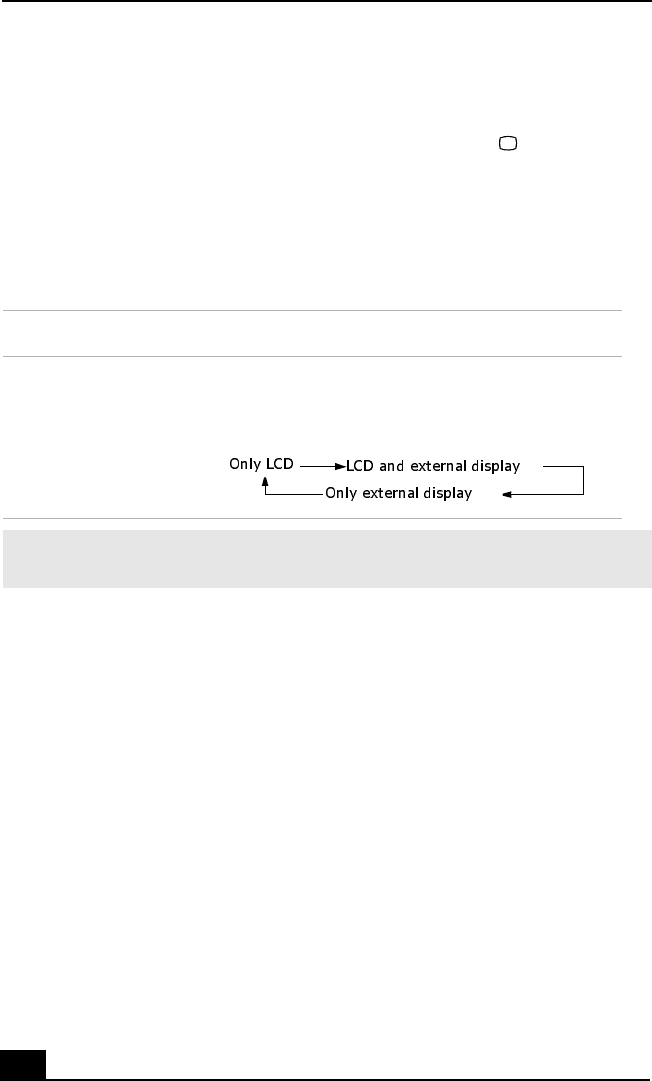
Change text in this variable definition to document title.
62
Changing the display when connecting an external computer
display or projector
When you connect an external display to the VGA (Monitor) port, you can
toggle the output between the Liquid Crystal Display (LCD), the external
monitor, or both devices.
To change
Press the Fn+F7 key combination to select a display. See “Selecting the Display
Mode” for more information.
To Press Result
Switch to an
external display
Fn+F7 Toggles between the LCD, the external display
connected to the Monitor port, or both the LCD
and external display.
✍Connect the external display to the notebook or port replicator before you turn on the
unit, otherwise the Fn+F7 key combination will not work.
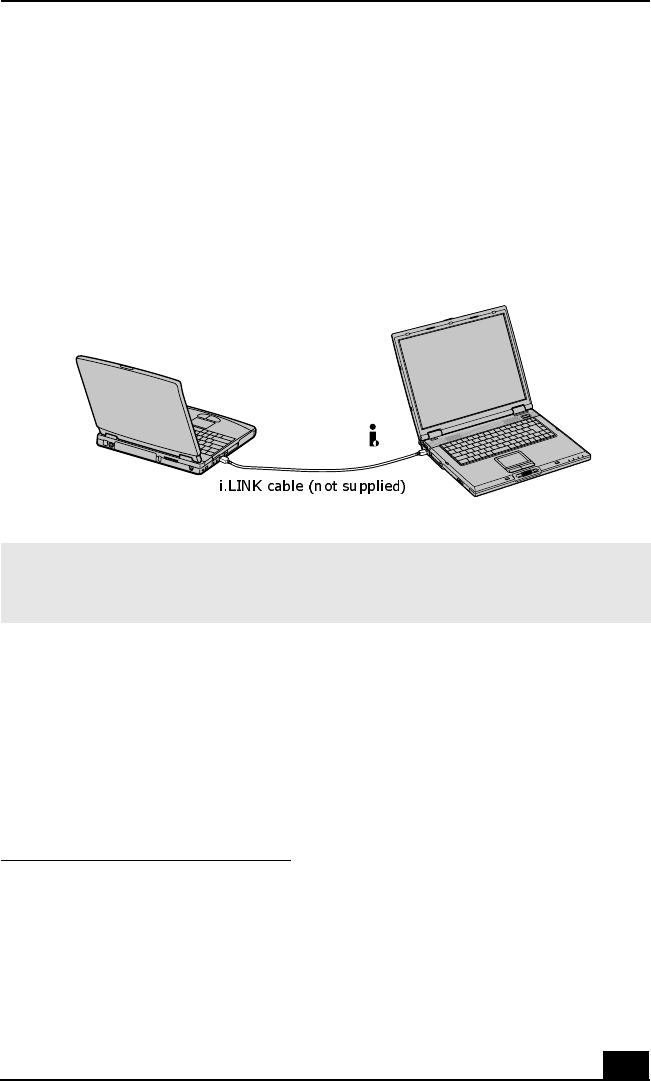
Connecting with another VAIO computer
63
Connecting with another VAIO computer
Use an i.LINK®* cable (not supplied) to connect your VAIO computer to another
computer that also has an i.LINK port. You can use one computer to edit, copy or
delete files on the other computer. You can also print from a printer attached to
either computer.
* i.LINK is a trademark of Sony used to designate that a product contains an IEEE 1394 con-
nection. The i.LINK connection may vary, depending on the software applications, operating
system, and compatible i.LINK devices. All products with an i.LINK connector may not
communicate with each other. Refer to the documentation that came with your compatible
i.LINK device for information on operating conditions and proper connection. Before con-
necting compatible i.LINK PC peripherals to your system, such as a CD-RW or hard disk
drive, confirm their operating system compatibility and required operating conditions.
Connecting with an i.LINK Cable
✍When you connect two VAIO computers, you must assign each computer a unique
name. You can identify the computers by this unique name when the two computers
are networked together.
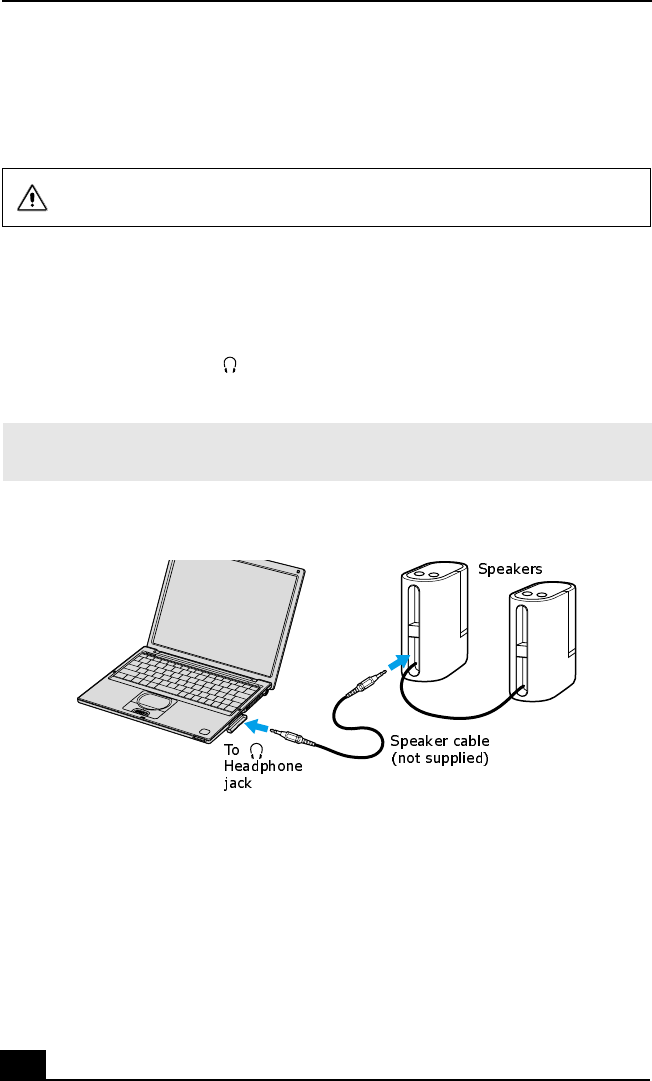
Change text in this variable definition to document title.
64
Connecting External Speakers
You can enhance the sound quality of your computer by connecting external
speakers (not supplied).
To connect external speakers
1Verify that your speakers are designed for computer use.
2Turn down the volume of the speakers.
3Locate the Headphone jack, and plug the speaker cable (not supplied) into
this jack.
Do not place floppy disks on the speakers; the speakers’
magnetic field may damage the data on the floppy disks.
✍See the manual that came with your speakers for more information on its installation
and use.
Connecting Speakers to the Headphone Jack
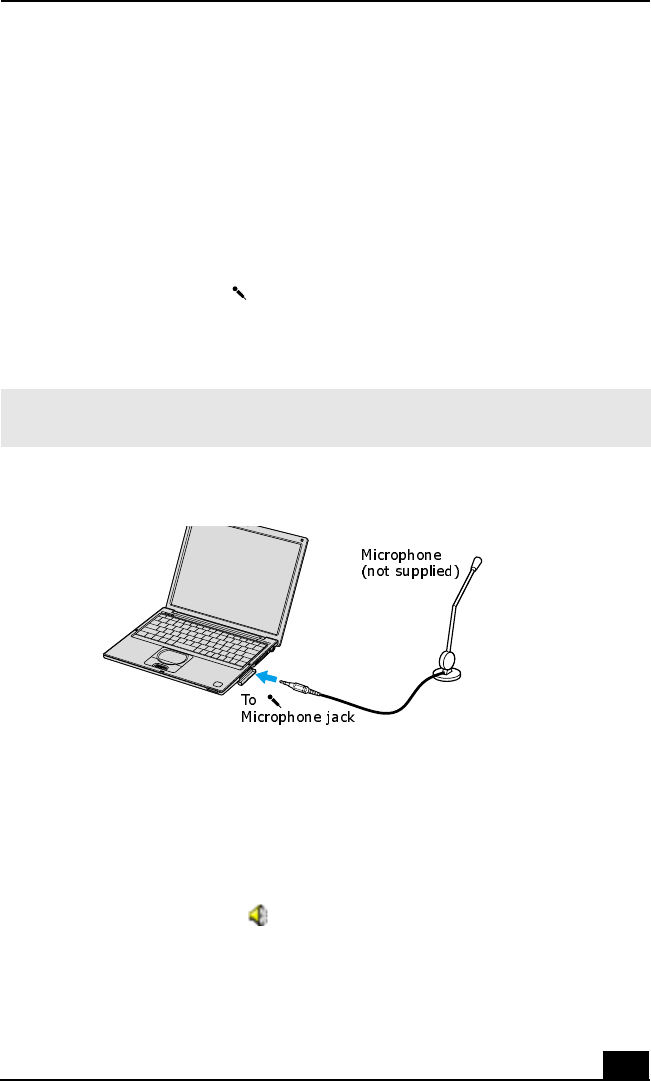
Connecting a Microphone
65
Connecting a Microphone
You can enhance the quality of sound input by using a microphone (not
supplied).
To connect a microphone
1Verify that your microphone is designed for computer use and compliant
with the plug-in power microphone. Double check
2Locate the Microphone jack. A protruding dot above the Microphone
jack distinguishes this jack from the Headphone jack.
3Plug the microphone cable (not supplied) into the Microphone jack.
To record from a microphone or audio equipment
You can record messages, memos, or other recordings in analog by connecting a
microphone or other audio equipment to the Microphone jack of your computer,
port replicator, or docking station and switching the jack functionality. The
Microphone jack is for MIC IN (monaural).
1Double-click the Volume icon on the taskbar. The Volume Control
window appears.
2From the Options menu, click Properties. The Properties window appears.
✍See the manual that came with your microphone for more information on its
installation and use.
Connecting to a Microphone Jack

Change text in this variable definition to document title.
66
3In the Adjust volume for box, click the Recording option button to select it,
and then click OK. The Recording Control window appears.
4If it is not already turned on, click the Select check box at the bottom of the
Microphone column. Close the Recording Control window.
5Click Start on the taskbar, and select All Programs, Accessories,
Entertainment, and then Sound Recorder. The Sound - Sound Recorder
window appears.
Adjusting the volume
You can adjust the volume for playing or recording, but you can only adjust the
recording volume in the Recording Control window. If you adjust the volume,
the adjustment is only effective for playing sound. It does not adjust the volume
for recording sound.
To adjust the volume when playing
1Double-click Volume icon in the taskbar. The Volume Control window
appears.
2In the Volume Control column, move the slider up for increased volume and
down for decreased volume.
✍You are ready to begin recording. For help using Sound Recorder, click Help in the
Sound Recorder window.
Sound device Function
Volume Control Adjust the sound level from the speakers or
headphones.
Wave Adjust the wavfile sound or the system sound of
Windows.
SW Synth
CD Audio Adjust the volume of the CD in the optional optical
drive.

Connecting a Microphone
67
Microphone Adjust the internal or external microphone volume.
Telephony Adjust the modem or telephone line volume.
PC Beep Adjust the beep sound when inserting or removing
the PC Card and other devices.
Sound device Function

Change text in this variable definition to document title.
68
Expanding Your Computer Capabilities
You can connect the following peripheral devices to your computer to expand its
capabilities and enhance its versatility to meet your needs:
❑A Personal Digital Assistant (PDA)
❑A Wireless LAN Access Point
❑A Wireless LAN PC Card
Personal Digital Assistant
A handheld PDA is the quintessential personal planner and entertainment center
that fits in your pocket. With a PDA, you can easily perform the following
functions:
❑Enter your schedule details in the calendar and view them by the day, week,
or month, and even set an alarm to remind you of important events.
❑Keep your contact names, addresses, phone numbers, and other details in the
address book and find them when you need them.
❑Add tasks to the To Do List, prioritize them, and assign them due dates.
❑Synchronize your data with the software on your computer to back up your
data.
❑Track expenses when you are out of the office and transfer the data to your
notebook.
❑Exchange data with your computer.
Wireless LAN Access Point
The Wireless LAN Access Point is designed for building a wireless Local Area
Network (LAN) environment. The Access Point comes with the Wireless LAN
PC Card and required software. You can easily build a wireless LAN
environment by plugging the Access Point into an AC power outlet, installing the
Wireless LAN PC Card in your computer, and using the provided software.
Because a wireless LAN configuration requires no wiring, you can operate
multiple computers more freely than ever before.
You can also connect your Access Point to a telephone line, Integrated Services
Digital Network (ISDN) router, cable modem, or Digital Subscriber Line (xDSL)
modem to share access to the Internet among multiple computers.

Expanding Your Computer Capabilities
69
Wireless LAN PC Card
The Wireless LAN PC Card, which comes with the Wireless LAN Access Point,
can be purchased separately and is designed for building a wireless LAN
environment. You can use the Wireless LAN PC Card with or without the access
point. With the access boint, you can build a wireless LAN between computers
that are equipped with the Wireless LAN PC Card and gain access to the Internet.
Without the Access Point, you can achieve direct communication (Peer-to-Peer
mode) between computers.
✍For more information on Sony Wireless LAN, go to
http://www.sonystyle.com/vaio/wirelesslan.shtml

Change text in this variable definition to document title.
70

71
Customizing Your VAIO
Computer
You can customize the settings of your computer. The following sections
briefly describe how to change your computer’s default settings. You can
also refer to Sony Notebook Setup Help for more detailed information.
❑Displaying the Sony Notebook Setup Screen
❑Controlling Power Management
❑Displaying Battery Information
❑Selecting the Display Mode
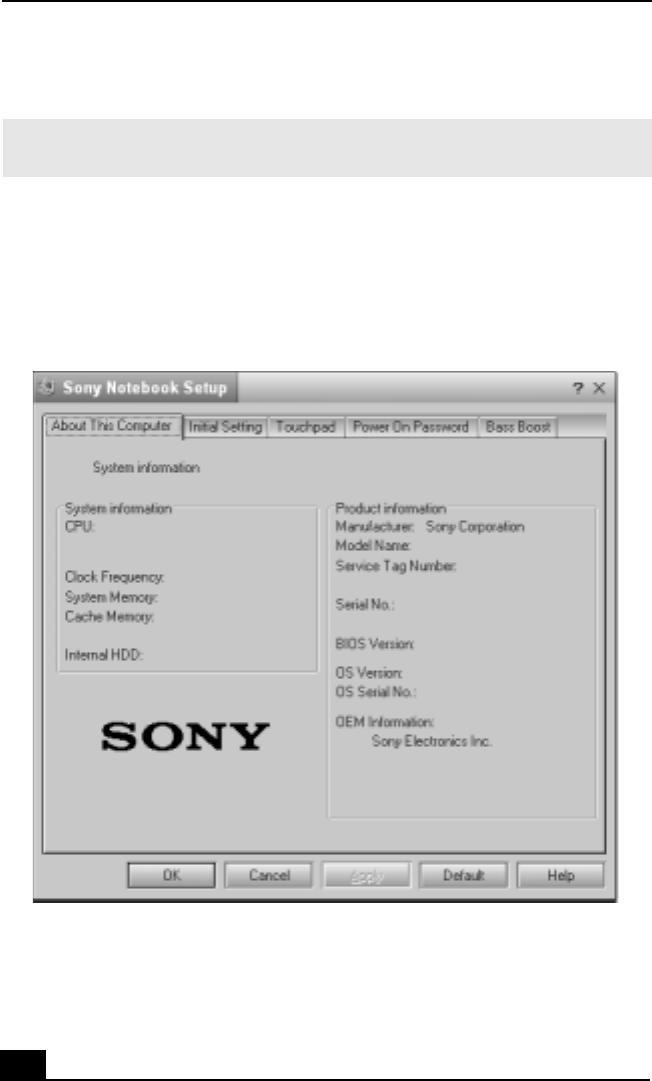
Change text in this variable definition to document title.
72
Displaying the Sony Notebook Setup Screen
To display the Sony Notebook Setup screen
1From the Start menu, point to All Programs, and then Sony Notebook Setup.
2From the Sony Notebook Setup menu, click Sony Notebook Setup.
3Select the tab for the item you want to change. See “Sony Notebook Setup
tabs” for more information.
4After you finish making your changes, click OK.
✍See the manual supplied with your computer display for more information on its
installation and use.
Sony Notebook Setup Screen

Displaying the Sony Notebook Setup Screen
73
Sony Notebook Setup tabs
Tab Description
About This Computer Display system information, including memory
capacity, serial number, and BIOS version.
Initial Setting Change the volume of the sounds that play while the
operating system is loading. Select the order of drives
and devices from which you want to load the operating
system. You can specify the hard drive as well as other
drives inserted into your computer.
Touchpad Change touchpad settings, or enable/disable touchpad
functionality if you are using an external mouse.
Power On Password Set the password to secure your computer.
Bass Boost Set the Bass Boost option.
✍For more information about each option, click Help on the Sony Notebook Setup
screen to display the Help file.

Change text in this variable definition to document title.
74
Controlling Power Management
The PowerPanel™ utility enables you to control the power management of your
computer and provides key information about system activity and battery life.
The following sections briefly describe how to conserve your computer’s battery
power. You can also refer to PowerPanel Help for more information.
Viewing the Power Management status icons
The Power Management status icons are displayed on the taskbar. Move the
pointer over the icons to see the tool tip that displays information about the active
profile.
The current profile icon’s appearance changes depending on which power
management profile is currently selected. To change the power management
profile, right-click the current profile icon, and then select a profile from the pop-
up list. See “Power Management profiles” for a description of available
options.To select another power management command, click that icon in the
Power Management toolbar.
You can change the power management settings, such as the system timer and the
brightness of the screen.
To access PowerPanel Help
1Click Start, point to All Programs, and select PowerPanel.
2Click Help. The PowerPanel Help window appears.
✍When you use the battery pack to power your computer, your system selects the
Maximum Battery Life power management profile by default. If you select a
different power management profile while using battery power, that profile is
selected automatically the next time you use the battery pack to power your
computer.
Refer to PowerPanel Help for information on customizing the Power Management
settings.

Controlling Power Management
75
To customize Power Management settings
1Right-click the current Profile icon on the taskbar.
2Select Edit/Create Profiles from the menu. The Profile Editor window
appears.
3Click a profile whose setting you want to change from the list in the left
field.
4Double-click an item whose setting you want to change from the list in the
right field.
5Click the desired setting.
6Click the File menu, and then click Save.
7Click the File menu, and then click Exit.
Power Management profiles
The PowerPanel™ utility provides several predefined power management
profiles. Each profile consists of a group of power management settings that are
designed to meet specific power management goals — ranging from maximum
power management to no power management. You can change the settings for
any of the predefined profiles (except for the Disable Power Management
profile), or you can create your own profile to suit your portable computing
needs.
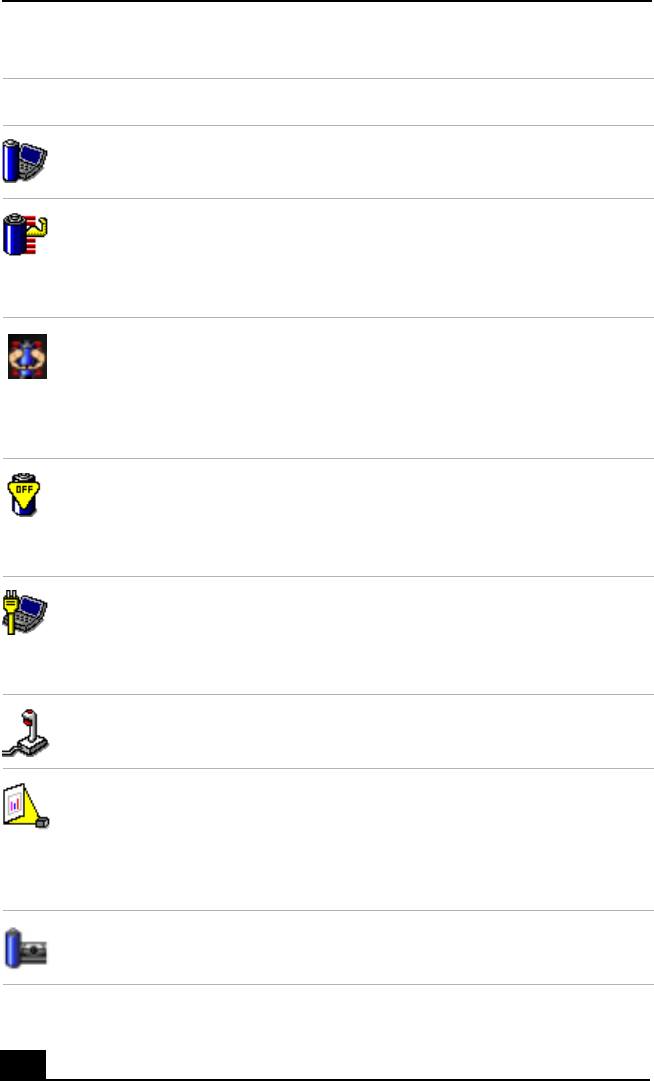
Change text in this variable definition to document title.
76
Icon Description
Maximum Performance
Provides the best system performance while still conserving power.
Maximum Battery Life
Provides power saving features to give you maximum battery life and
good performance. It slows the computer and puts it into Standby
mode after a specified time period.
Ultimate Battery Life
Extends the Maximum Battery Life by disabling ports such as the
i.LINK port.
This profile disables many applications such as Memory Stick,
DVgate, and Smart Capture.
Disable Power Management
Turns off all power management features such as Standby and
Hibernate modes.
You can not change the settings of this profile.
AC Power
The power management state when AC power is in use. Similar to the
Power Management Off setting. Power Management automatically
loads the AC profile unless you disable this feature.
Games
Disables the display and the Hard Disk Standby timer.
Presentation
Keeps the display on at all times while it conserves power. This option
is ideal for slide show presentations. You can establish settings for
LCD (Video) Standby, Hard Disk Standby, and Standby to optimize
power management for your system.
Camera
Optimizes performance and power requirements for camera usage.

Controlling Power Management
77
Power Management commands
PowerPanel™ also provides power management commands that you can use to
activate specific power management functions and to control power for a specific
device. You can use these commands to override a profile setting or initiate an
immediate action.
Word Processing
Optimizes power management with longer timeouts on the hard disk
and display screen. You can also establish settings for LCD (Video)
Standby, Hard Disk Standby, and Standby to optimize power
management for your system.
Spreadsheet
Optimizes performance and power requirements for spreadsheet
applications.
Communications
Extends battery life by initiating a quick display timeout. The Internal
modem remains powered. You can also establish settings for LCD
(Video) Standby, Hard Disk Standby, and Standby to optimize power
management for your system.
Automatic Profile Selection
Automatically switches to a profile suitable for active applications.
✍Do not choose the Automatic Profile Selection when connected to AC power.
Icon Description

Change text in this variable definition to document title.
78
Conserving battery power
When using the computer with a battery, the LCD display and the hard disk drive
can be set to switch off automatically to conserve battery power.
See “Power Management profiles” for more information.
Icon Description
Standby
Puts the system into Standby mode, a power management state that
saves the state of the system and peripheral devices in memory
(RAM). Power consumption reduces to a minimum, and the system
remains on. To return the system to the active state, press any key or
the power button on your computer.
Hibernate
Provides for the lowest level of power consumption. The system
writes the state of the system and peripheral devices to the hard disk
drive and turns off the system power. To return the system to the
original state, use the power button to turn on power. The system
saves the data in the Save to Disk Partition on the hard disk drive.
LCD (Video) Standby
Turns off the video display to save power. If you turn off the Video
Standby timer, the display remains active except when the system
enters Standby mode. The video display system is one of the largest
consumers of power in the system.

Displaying Battery Information
79
Displaying Battery Information
[[Can’t confirm yet]]
You can display information for the battery on your computer. The following
sections briefly describe how to display your computer’s general battery
information. You can also refer to PowerPanel Help for more detailed
information.
To display the Battery Information window
1Double-click the current Profile icon on the taskbar. The Battery Information
window appears.
2For additional information, click the Help button. The PowerPanel Help
window appears.
To display the Battery Information toolbar
1Right-click the taskbar, point to Toolbars, and select Battery Information.
2The Battery Information toolbar appears on the taskbar.
The toolbar displays battery status gauges and the battery status icon.
❑Percentage indicator — Displays the percentage of the remaining capacity.
❑Time indicator — Displays estimated time (hours:minutes) remaining
before the battery fully drains, also referred to as the time-to-empty.
To close the Battery Information toolbar
1Right-click the Battery Information toolbar, and point to Toolbars.
2Click to deselect Battery Information. The toolbar disappears from view.
Battery Information Toolbar

Change text in this variable definition to document title.
80
Battery icon descriptions
Displaying detailed battery information
Double-click the battery icon on the task tray to display the Battery Information
window. The screen appears displaying the Battery tab, which contains
information such as the estimated time-to-empty and charging time.
Battery icon Battery status
Charging
Fully charged
Discharging
No battery
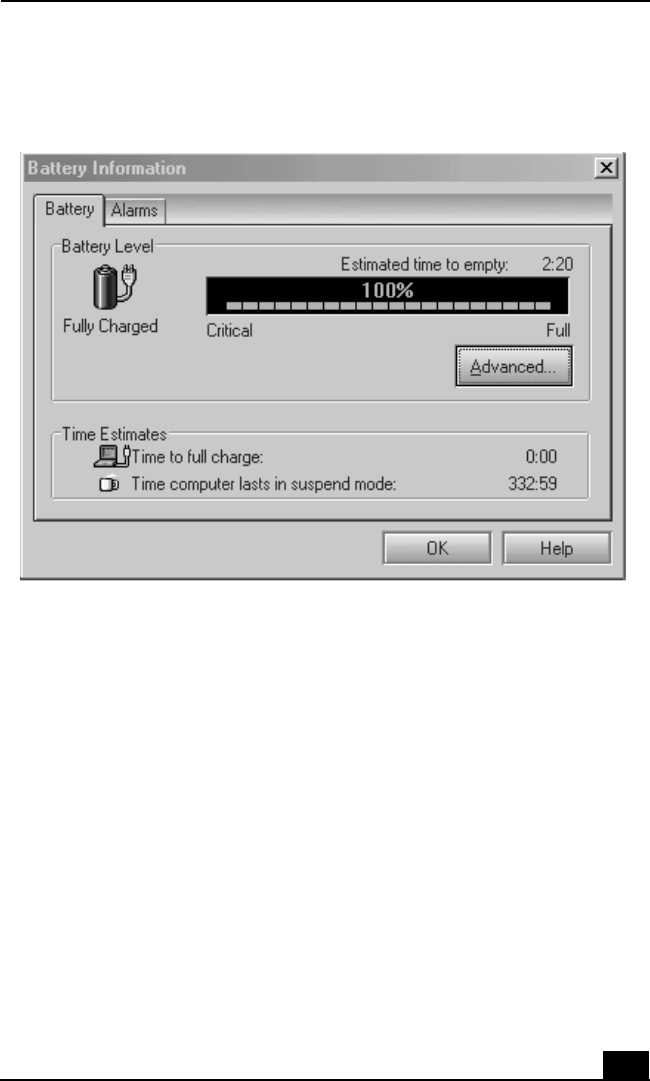
Displaying Battery Information
81
Customizing the Battery Information toolbar and alarm system
You can customize the Battery Information toolbar to suit your portable
computing needs, including modifications to the alarm settings. Refer to
PowerPanel Help for more information.
Changing the window design of Sony software
To change the window design
1Click the Start button, then select Control Panel.
2In the left window pane of Control Panel, click “Switch to Classic View.”
3Double-click UI Design Selector.
4Click << or >> and select the desired design.
Battery Information Window

Change text in this variable definition to document title.
82
5Click Apply. The “UI Design Selector” window design changes. The
window design for your Sony software will match the “UI Design Selector”
window.
6To try another selection, click << or >> and then click OK to close the UI
Design Selector.
✍This feature is available with UI Design Selector-compatible software only.

Selecting the Display Mode
83
Selecting the Display Mode
[[Can’t confirm steps yet]]
This computer uses the Intel® video controller, which enables you to select the
desired display when the computer is connected to an external monitor. When
you connect an external display, you can switch the display mode between your
notebook’s LCD display and the external monitor.
To select the display mode
1Click Start, and point to Control Panel.
2Click Display. The Display Properties window appears.
3From the Settings tab, click Advanced, and select the Intel® Graphics
Technology tab to display the Intel® 82815 Graphics Controller Properties
dialog box.
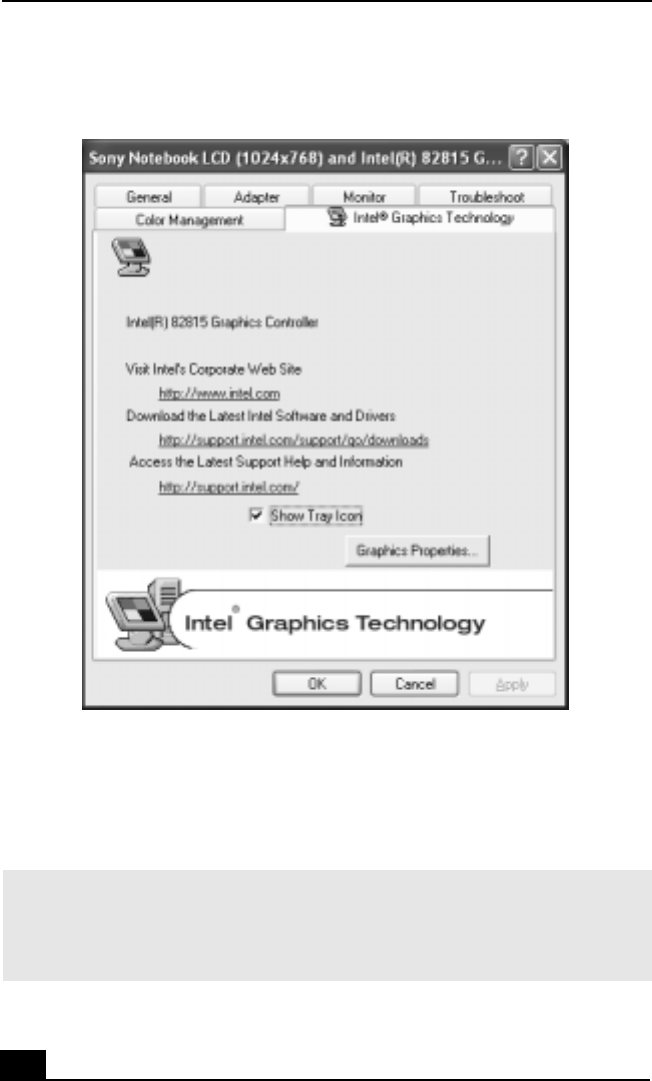
Change text in this variable definition to document title.
84
4Click the Intel® Graphics Technology tab, then click the Graphics Properties
button.
5Click the Device tab.
6Select the type of display.
Intel® 82815 Graphics Controller Properties Screen
✍You may not be able to display the computer LCD screen and an external display or
projector at the same time, depending on the types of computer displays and
projectors you are using.
Turn on the computer after you turn on the peripheral devices.

85
Adding Memory
In the future you may want to install memory modules to expand the
functionality of your computer. See the Specifications flyer supplied with
your computer for the amount of memory preinstalled on your computer.
Expansion memory modules are available as options. For memory
upgrades, use only unbuffered PC100 (CL2) SDRAM µDIMM modules.
(Sony offers the optional 128 MB PCGA-MM128T memory module.)
This section provides you with information on removing and replacing a
memory module:
❑Precautions and Procedures
❑Removing a Memory Module
❑Installing a Memory Module
❑Confirming Added Memory Capacity

Change text in this variable definition to document title.
86
Precautions and Procedures
The procedures described below assume familiarity with the general terminology
associated with personal computers and with the safety practices and regulatory
compliance required for using and modifying electronic equipment.
❑Disconnect the system from its power source and from any
telecommunications links, networks, or modems before you open the system
or follow any of the procedures described below. Failure to do so may result
in personal injury or equipment damage.
❑Electrostatic discharge (ESD) can damage disk drives and other components.
Perform the procedures described below only at an ESD workstation. If such
a station is not available, do not work in a carpeted area, and do not handle
materials that produce or hold static electricity (cellophane wrappers, for
example). Ground yourself by maintaining contact with an unpainted metal
portion of the chassis while performing the procedure.
❑Do not open the memory module package until you are ready to install the
module. The package protects the module from ESD.
❑Use the special protective package to store a memory module and prevent
ESD, or wrap the memory module in aluminum foil.
Typical expansion memory configuration
Sony recommends that memory upgrades be performed by an authorized
Sony Service Center. To find the nearest center or agent, go to:
http://www.sony.com/pcsupport.
Be careful when installing a memory module in your computer, and be sure
to observe the proper safety precautions listed below. Mistakes that occur
when installing or removing a memory module may cause a malfunction.
Total System Memory (MB) On board (MB) Slot (MB)
128 128 0
256 128 128
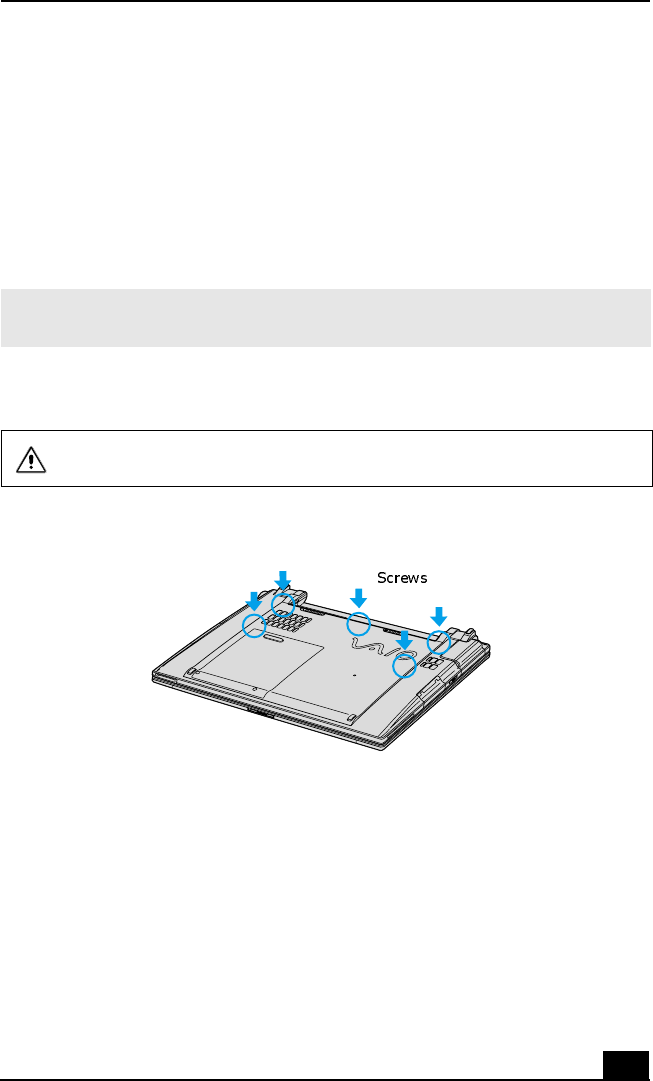
Installing a Memory Module
87
Installing a Memory Module
To add a memory module, proceed as follows:
1Turn off the computer and all peripheral devices.
2Disconnect the power cord and all cables from the computer, and remove the
battery.
3Wait for the computer to cool down.
4Use an appropriate screwdriver to loosen and remove the three screws at the
bottom of the computer.
5Slide the LCD lock lever and lift the cover.
6Slide the keyboard toward the LCD display, then lift it away slightly.
✍The interior of the computer becomes extremely hot during operation. Wait at least
one hour for the computer to cool down before you remove the screws.
To avoid damaging the computer, do not remove or loosen any other screws.
Removing Bottom Screws
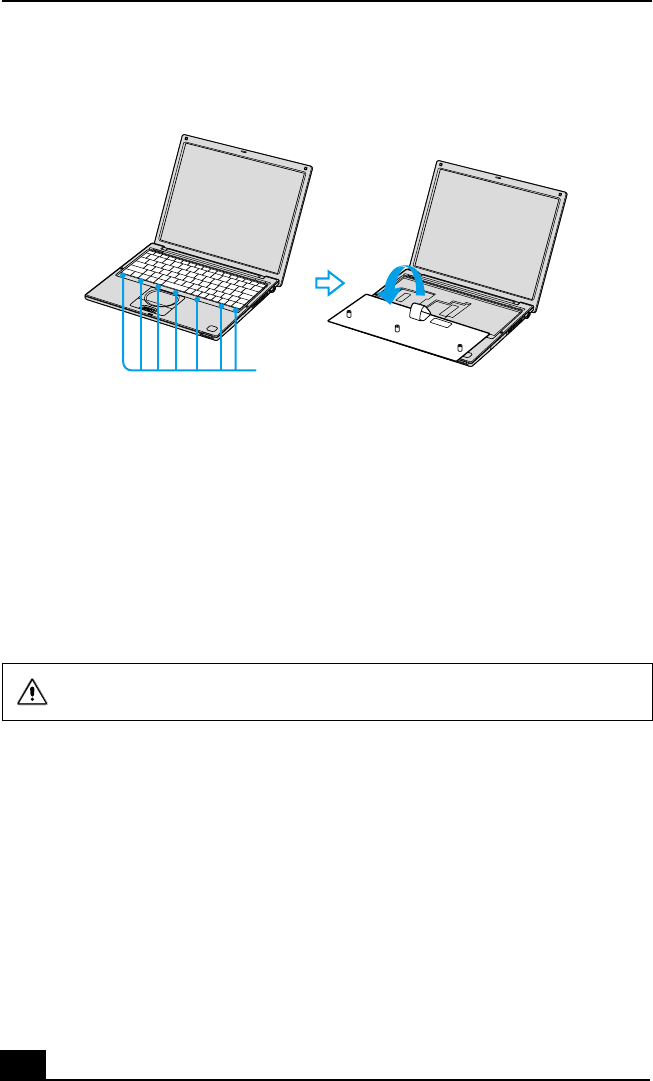
Change text in this variable definition to document title.
88
7Lift the keyboard from the LCD display side.
8Gently turn the keyboard over the touchpad. Take care not to detach the
cable when lifting the keyboard.
9Touch a metal object (such as the connector panel on the back of your
computer) to discharge static electricity.
10 Remove the existing memory module.
11 Remove the new memory module from its packaging.
12 Install the memory module by sliding the module into the open slot.
Lifting the Keyboard
Do not touch any part of the motherboard or the other components inside
the computer.
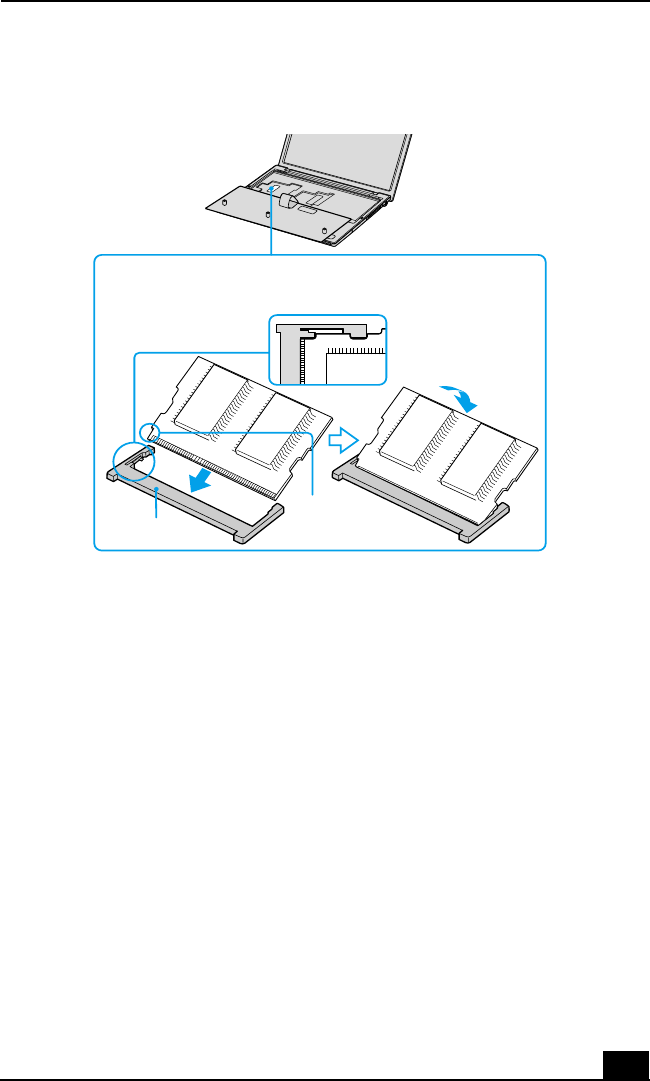
Installing a Memory Module
89
13 Snap the connectors into place when the board is correctly seated.
14 Close the computer cover and replace the three (3) fastening screws on the
bottom of the computer.
Installing New Memory Module
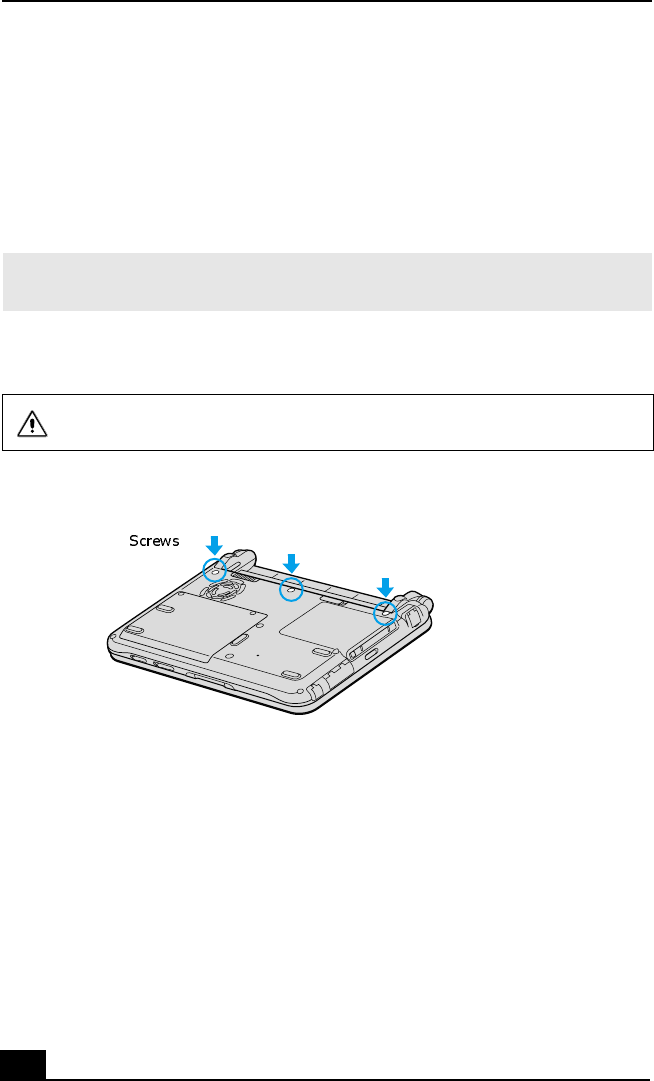
Change text in this variable definition to document title.
90
Removing a Memory Module
1Turn off the computer and all peripheral devices.
2Disconnect the power cord and all cables from the computer, and remove the
battery.
3Wait for the computer to cool down.
4Use an appropriate screwdriver to loosen and remove the three screws at the
bottom of the computer.
5Slide the LCD lock lever and lift the cover.
6Slide the keyboard toward the LCD display, then lift it away slightly.
✍The interior of the computer becomes extremely hot during operation. Wait at least
one hour for the computer to cool down before you remove the screws.
To avoid damaging the computer, do not remove or loosen any other screws.
Removing Bottom Screws
Double
check
grfx???
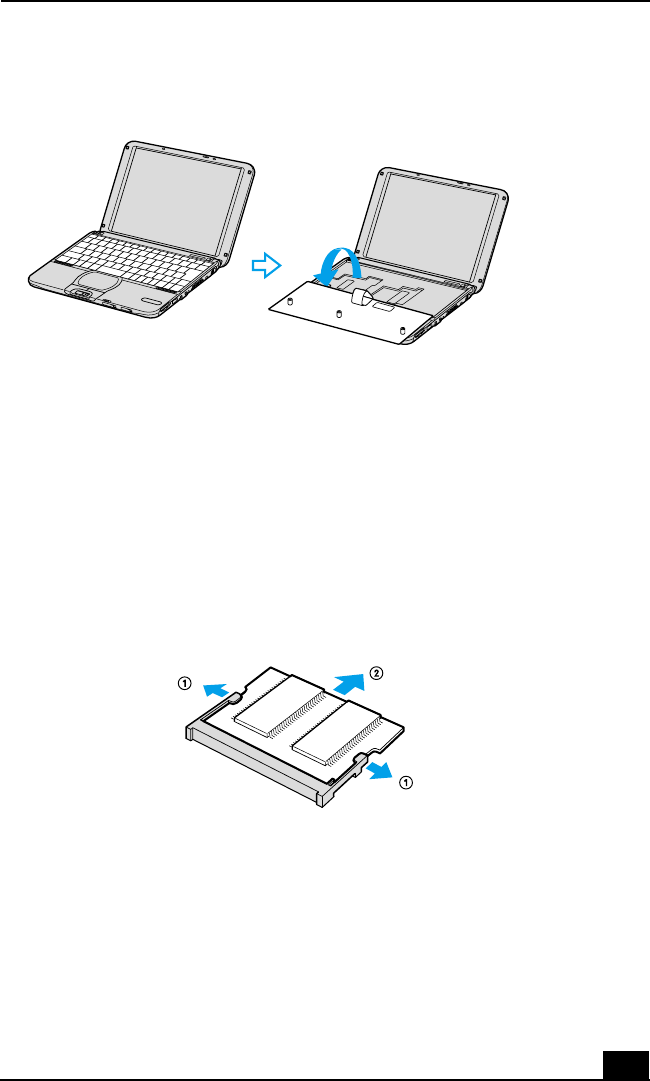
Removing a Memory Module
91
7Lift the keyboard from the LCD display side.
8Gently turn the keyboard over the touchpad. Take care not to detach the
cable when lifting the keyboard.
9Touch a metal object (such as the connector panel on the back of your
computer) to discharge static electricity.
10 Remove the memory module by pulling out the tabs (see arrows No. 1), and
pulling out the module in the direction of arrow No. 2.
11 Gently replace the keyboard, then press it into your computer.
12 Close the computer cover and replace the three (3) fastening screws on the
bottom of the computer.
Lifting the Keyboard
Removing a Memory Module
???
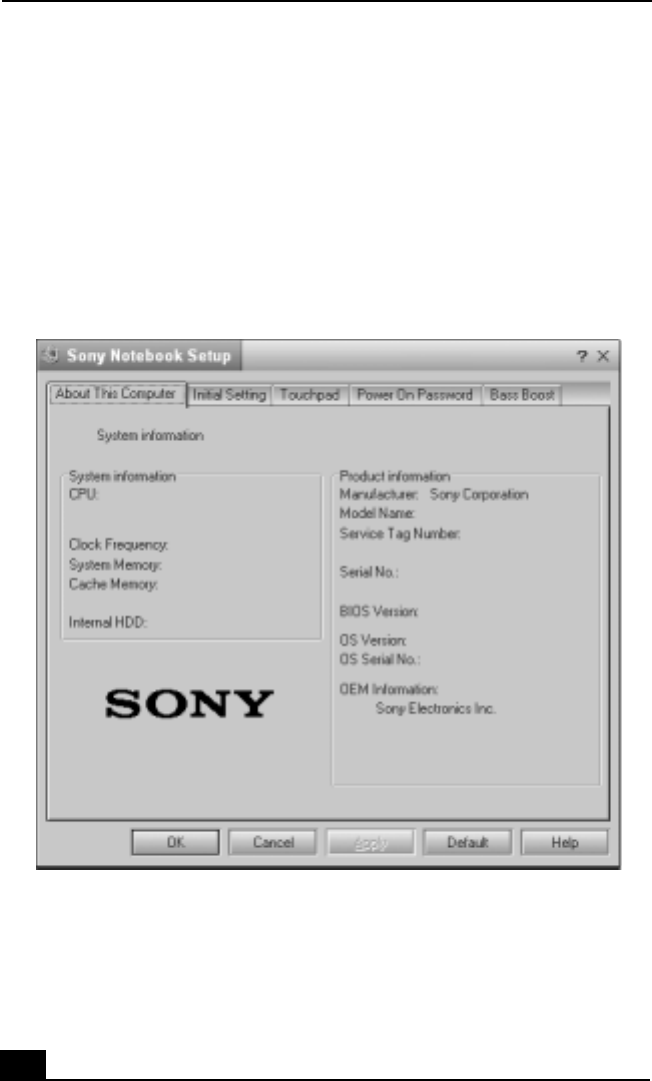
Change text in this variable definition to document title.
92
Confirming Added Memory Capacity
1Turn on the computer.
2Click Start on the Windows® taskbar, point to All Programs, and then click
Sony Notebook Setup.
3Click the About This Notebook tab. Verify that the System Memory
displayed in the left panel matches the amount of memory installed.
Sony Notebook Setup Dialog Box

93
About the Software on Your
Computer
Your VAIO® computer is ready to help you work, play, learn, and
communicate as soon as you turn it on. This section gives you the
following:
❑Software Overview
❑DVgate application notes
❑Software Support Information
Software Overview
Your computer may not be supplied with all of the software listed below,
depending on the configuration you purchased. Preinstalled software may not be
identical to retail versions, or include supporting documentation.
Your computer may not be supplied with all of the software listed below,
depending on the configuration you purchased. Preinstalled software may not be
identical to retail versions or include supporting documentation.
Adobe® Acrobat® Reader®
Adobe Systems Inc.
Acrobat Reader software allows you to view, navigate, and print electronic
documents in Adobe’s Portable Document Format (PDF), an open file format
that is intended to preserve the fidelity of documents created on all major
computer platforms.
Adobe® Photoshop® Elements (On selected models)
Adobe Systems Inc.
Using state-of-the-art image editing tools, you can unleash your artistic ability
and create digital images for print, e-mail and posting to the Web. The versatile
image capturing options allow you to start working with digital and traditional
photos immediately. Explore endless creative possibilities for your personal
images with Adobe Photoshop Elements software.

Change text in this variable definition to document title.
94
America Online®
America Online, Inc.
America Online is a popular Internet online service. Stay in touch with family
and friends with easy-to-use e-mail. Manage your personal finances, get the latest
news and sports scores, and chat with thousands of others who share your
interests.
DigitalPrint
Sony Electronics Inc.
This image management software makes it fun and easy to edit, import, and
organize your digital pictures in a photo album for rich digital printing to any
standard color laser or ink-jet printer. DigitalPrint can also be used to make
custom CD labels for your audio CDs.
DVgate™
Sony Electronics Inc.
Connect a digital video camera recorder to the i.LINK® port and capture your
own video clips and still images. You can edit clips from your video, add new
clips, and combine clips into new movie segments. You can also save your
images in a variety of popular file formats.
EarthLink Total Access®
EarthLink, Inc.
An Internet Service Provider that supplies access, information, and assistance to
its customers, introducing them to the Internet. Member benefits include e-mail,
newsgroups, a Personal Start Page, free storage space for your personal Web site,
a member magazine, and 24-hour technical support.
EverQuest (On selected models)
Sony Online Entertainment Inc.
This introductory edition of EverQuest, a living, constantly evolving fantasy
world, takes users to new heights of online role-playing gaming.
Jog Dial Utility
Sony Electronics Inc.
The Jog Dial Utility enables you to easily scroll, launch applications, access
settings, and perform other useful functions by manipulating the center Jog
Dial™ control, which is located near the touchpad.

About the Software on Your Computer
95
Microsoft® Office XP Professional (On selected models)
Microsoft Corp.
Microsoft Office XP software redefines the relationship between people and
software by providing a smarter, simpler way of working. New Office XP
software features include context-sensitive smart tags, enhanced formatting
options, and more, that enable you to continually integrate additional services
into Office and access information anytime.
Microsoft® Office XP Small Business Edition (On selected models)
Microsoft Corp.
With Microsoft Office XP system you’ll find a powerful new technology that will
help you get work done more quickly by providing real-time, context-sensitive
options for important actions, from formatting to error correction. Task panes
consolidate important tasks into a single integrated view, enabling you to conduct
searches, launch and format documents, and view the contents of your Clipboard
from one location.
Microsoft® Word (On selected models)
Microsoft Corp.
Microsoft Word makes it easy to create common Web, e-mail, and print
documents for use around the world. It embraces HTML as a first-class file
format and extends Word's ease-of-use to the Web and e-mail. Word also extends
that ease-of-use to international users, making it easy to create multilingual
documents.
MovieShaker™ (On selected models)
Sony Electronics Inc.
Sony’s original MovieShaker software creates personal movies that have
transitions, background music, and text. Just import your video clips and “shake”
with a click of the mouse. Your personal movies are easy to create and fun to
share with family and friends.
PC-Cillin® 2000
Trend Micro, Inc.
PC-Cillin software provides portable, easy-to-use, real-time antivirus security at
your computer’s entry point (beaming, synchronization, Internet access) to
defend against potential threats hidden inside files, e-mail, or on the Web.

Change text in this variable definition to document title.
96
PicoPlayer™
Sony Electronics Inc.
PicoPlayer software is a video player utility that enables you to use Giga
Pocket™ Personal Video Recorder functions on a computer that does not have
Giga Pocket Personal Video Recorder installed. You can play Video Capsules
created by Giga Pocket Personal Video Recorder, and, if a Giga Pocket Server is
available on your home network, watch TV streamed from the Giga Pocket
Server and remotely control the Giga Pocket Server’s TV programming
functions.
Quicken® 2002 New User Edition
Intuit Inc.
Quicken software is the fastest, easiest way to organize your finances. Quicken
software works just like your checkbook, so it's easy to learn and use. You can
even pay your bills online. Quicken software manages all of your finances, bank
accounts, credit cards, investments, and loans. (Users of other versions of
Quicken must upgrade for a fee.)
QuickTime®
Apple Computer, Inc.
The versatile QuickTime software plays hundreds of different kinds of files,
including video, audio, and virtual reality (VR) movies. You can play QuickTime
files (referred to as “QuickTime movies”) using QuickTime Player or any other
application, such as a Web browser or word processor, that supports QuickTime
software
RealPlayer®
RealNetworks, Inc.
RealPlayer software is a high-quality streaming media player that supports many
digital media formats. The user-friendly interface has enhanced navigation
capabilities, allowing you to access and enjoy audio and video programming over
the Internet. RealPlayer software is your gateway to a superb Internet multimedia
experience.

About the Software on Your Computer
97
Smart Capture
Sony Electronics Inc.
Smart Capture is a fun new way to send multimedia messages via e-mail. Smart
Capture manages the i.LINK® connection between your notebook and a Sony
Digital Handycam® Camcorder that supports the i.LINK interface. It allows you
to capture compressed video or still images and save them to your hard disk drive
or share via e-mail. A smart solution for computer, digital audio/video and
network convergence.
SonicStage™
Sony Electronics Inc.
This new jukebox application adds a host of new features to its predecessor,
OpenMG™ Jukebox. Continuing to take advantage of Sony’s copyright-
protected ATRAC3™ format for high-quality digital audio storage, SonicStage
software sports a new music visualizer, a sleek new player skin design, audio CD
burning capability, and a parametric equalizer for fine-tuning audio playback.
Sony ScreenBlast™ ACID (On selected models)
Sony Pictures Digital Entertainment
With the powerful Sony ScreenBlast ACID software you can create royalty-free
music by utilizing its loop-based production tool, including unlimited tracks and
enhanced effects.
Sony ScreenBlast™ Sound Forge (On selected models)
Sony Pictures Digital Entertainment
Sony ScreenBlast Sound Forge allows you to record, edit, and process mono or
stereo audio files for your multimedia or Internet projects. Whether you want to
use a number of professional effects, convert video into streaming media, or
synchronize audio to video — this software has everything you need to create
rich, immersive multimedia and Internet content.
Sony on Yahoo!
Yahoo! Inc.
Personalize your own web portal with Sony on Yahoo! Get a free webmail
account, customized news and local weather reports, comics, instant messaging,
and more.

Change text in this variable definition to document title.
98
VAIO Action Setup
Sony Electronics Inc.
VAIO Action Setup manages the settings for your computer's Shortcut keys.
VAIO Support Agent (On selected models)
Sony Electronics Inc.
VAIO Support Agent provides immediate, interactive, online support with
information about your preinstalled software and answers to frequently asked
questions.
WinDVD® 2000
InterVideo, Inc.
WinDVD 2000 software is a simple-to-use DVD player that offers all the features
you would expect to find in a standard consumer DVD player, while also
including advanced display and navigation features such as zoom, pan,
bookmark, and time search.

DVgate application notes
99
DVgate application notes
Digital video captures
If your system displays the message, “Failed to record to DV deck, please check
deck’s power status, cable connection…,” while you are recording images to a
digital video device using DVgate software, close all open applications, and
restart your computer. Frequent recording of images to a digital video device
while using DVgate may cause this situation to occur.
For more information on DVgate software, see the DVgate online help.
Adjusting image resolution
If the images on the LCD do not display smoothly, the resolution may not be set
correctly. To check the resolution, click the Setup button in the DVgate
Motion-Monitor window. Point to Settings, and then select Low Resolution. The
settings you change in this menu affect the images in the monitor window only.
Movie data imported to your hard drive and images recorded to DV devices will
not be affected.
Hard disk drive partition
In order to improve the performance of your computer’s DVgate™ motion
software, the hard disk drive on your computer has been formatted with two
partitions, C and D. The C partition hold 40 percent and the D partition holds 60
percent of the entire drive capacity. DVgate software saves files to the D
partition. This prevents large video capture from consuming the available space
on your C partition. To maintain optimum performance of DVgate, you should
defragment or format the D partition regularly.
To defragment a partition
❑Click the Start button in the Windows® taskbar.
❑Click Programs, Accessories, System Tools, and then click Disk
Defragmenter. The Disk Defragmenter window appears.
Before you begin to defragment a partition, make sure you back up all
files that you want to save.

Change text in this variable definition to document title.
100
Select the drive you want to defragment from the list, and click the Defragment
button. See Windows® Help for more information on defragmenting.

Software Support Information
101
Software Support Information
Adobe Acrobat® Reader™, Photoshop® Elements (Adobe Systems, Inc.)
America Online® (America Online, Inc.)
Apple QuickTime™ (Apple Computer Inc.)
ArcSoft PhotoPrinter® 2000 Pro (ArcSoft, Inc.)
EarthLink™ Network Total Access (EarthLink Network Inc.)
PC-Cillin® 2000 (Trend Micro, Inc.)
Web site http://www.adobe.com
phone 206-675-6126 (fee-based support)
e-mail techdocs@adobe.com
hours M-F, 6 AM-5 PM (PST)
Web site http://www.aol.com
phone 800-827-3338
hours 7 days a week, 24 hours a day
Web site http://www.apple.com
phone 800-692-7753
hours 7 days a week, 24 hours a day
Web site http://www.arcsoft.com
e-mail support@arcsoft.com
phone 510-440-9901
fax 510-440-1270
hours M-F 8:30 AM - 5:30 PM (PST)
Web site http://www.help.earthlink.net/techsupport
e-mail support@earthlink.net
phone 800-890-5128, 800-890-6356
hours 7 days a week, 24 hours a day

Change text in this variable definition to document title.
102
Quicken® (Intuit Inc.)
RealJukebox®, RealPlayer (Real Networks, Inc.)
Sony Applications (Sony Electronics Inc.)
Windows® Operating System, Internet Explorer, Word (Microsoft Corp.)
WinDVD® (InterVideo, Inc.)
Web site http://www.antivirus.com/pc-cillin
phone 949-387-7800
e-mail support@trendmicro.com
hours M-F 8 AM - 5 PM (PST)
Web site http://www.intuit.com/support
phone 800-644-3193
hours 7 days a week, 24 hours a day
Web site http://service.real.com/rjoptions.html
e-mail http://service.real.com/help/call.html
Web site http://www.sony.com/pcsupport
phone 888-4-SONY-PC (888-476-6972)*
* Support from 1-888-4-SONY-PC is free of charge for 90 days after the original date of purchase.
hours 7 days a week, 24 hours a day
Web site http://www.sony.com/pcsupport
phone 888-4-SONY-PC (888-476-6972)*
* Support from 1-888-4-SONY-PC is free of charge for 90 days after the original date of purchase.
hours 7 days a week, 24 hours a day
Web site http://www.intervideo.com
phone 510-651-0888

Software Support Information
103
Sony Service Center
For the Sony Service Center nearest you, call 1-888-4-SONY-PC
(1-888-476-6972) or find Sony Computing Service on the Web at:
http://www.sony.com/pcsupport.

Change text in this variable definition to document title.
104

VAIO® Computer Quick Start
106
Application, Driver, and System Recovery CDs
Your computer comes with the following Application Recovery, Driver
Recovery, and System Recovery CDs. You will need an optical disc drive
(supplied with selected models) to use these recovery CDs. If your computer
does not come with an optical disc drive, use an external optical disc drive.
Application Recovery CD(s)
Sony Electronics Inc.
This CD enables you to reinstall individual applications if they become corrupted
or are erased.
Driver Recovery CD(s)
Sony Electronics Inc.
This CD enables you to reinstall individual device drivers if they become
corrupted or are erased.
System Recovery CD(s)
Sony Electronics Inc.
This CD enables you to restore the operating system and software that shipped
with your computer if they become corrupted or are erased. This CD restores
your computer to its original factory settings, so user data and applications
installed since you started using your computer will be lost.
✍For models that come with a docking station, make sure you connect the docking
station to the computer before using the recovery CDs.

Using Your Recovery CDs
107
Using Your Recovery CDs
The following sections describe how to use the Application Recovery, Driver
Recovery, and System Recovery utilities.
To use the Application Recovery CD(s)
The Application Recovery CD(s) enables you to reinstall individual applications
if they become corrupted or are accidentally erased. Reinstalling an individual
software title may correct a problem you are experiencing with your computer or
software application; you may not need to reinstall the entire contents of your
hard drive. If you need to reinstall all the software titles that shipped with your
notebook, use the System Recovery CD(s). If you have any questions on using
the Application Recovery CD after reading this section, contact Sony Customer
Support.
1Turn on your computer. If your computer is already on, close all
applications.
2When the Windows desktop appears, insert the Sony Application Recovery
CD in the optical drive. The Application Recovery utility loads
automatically.
3When the Application Recovery menu appears, select the icon for the
application you want to restore, and then follow the on-screen instructions to
complete the recovery process.
✍You must be in Windows to run the Application Recovery CD. If you have any
questions on using the Application Recovery CD after reading this section, contact
Sony Customer Support.
✍Your system may include one or two Application Recovery CDs. If you have two
Application Recovery CDs, insert the first CD to run the Application Recovery
program. You may be prompted to insert the second CD, depending on the
application you wish to restore.

VAIO® Computer Quick Start
108
To use the Driver Recovery CD(s)
The Driver Recovery CD utility enables you to reinstall individual drivers if they
become corrupted or are erased. You can reinstall an individual driver to correct a
problem that you are experiencing with your computer, hardware, or software
application. VAIO Support Agent, an application repair utility, uses a vault
feature on the Driver Recovery CD(s) to repair software applications.
You must be in Windows to run the Driver Recovery CD utility.
Reinstalling specific drivers with the Driver Recovery CD
1Turn on your computer. If your computer is already on, close all
applications.
2When the Windows desktop appears, insert the Driver Recovery CD into the
optical disc drive.
3Click Start on the Windows taskbar, and click Control Panel. The Control
Panel window appears.
4Click Performance and Maintenance, then System. The System Properties
dialog box appears.
5From the Hardware tab, click Device Manager.
6Click to highlight the device for which you wish to reinstall the driver.
7From the Actions menu, select Properties. The Properties dialog box for that
device appears.
✍ If you need to reinstall all of the software applications that shipped with your
computer, use the System Recovery CD.
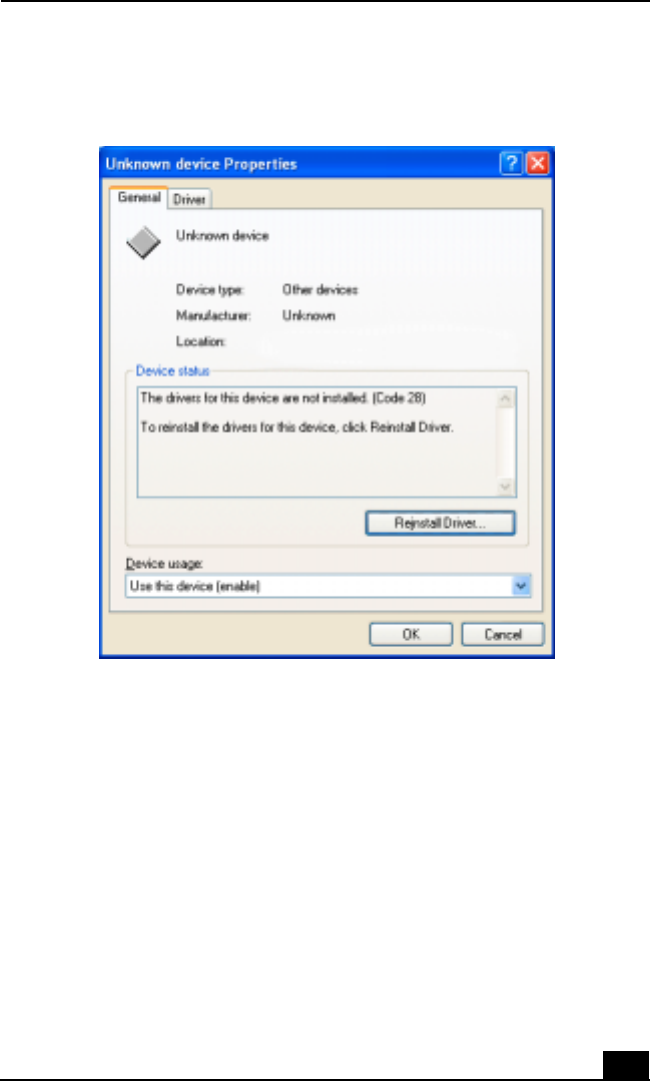
Using Your Recovery CDs
109
8Click Reinstall Driver. The Hardware Update Wizard appears.
9Click next. The wizard searches for the correct driver on your Driver
Recovery CD.
10 When the recovery process is complete, click Finish. Some drivers require
that you restart the computer to complete installation.
To use the System Recovery CD(s)
The System Recovery utility formats your hard disk drive and restores all
original software applications. Your computer is returned to the original factory
settings.
Properties dialog box
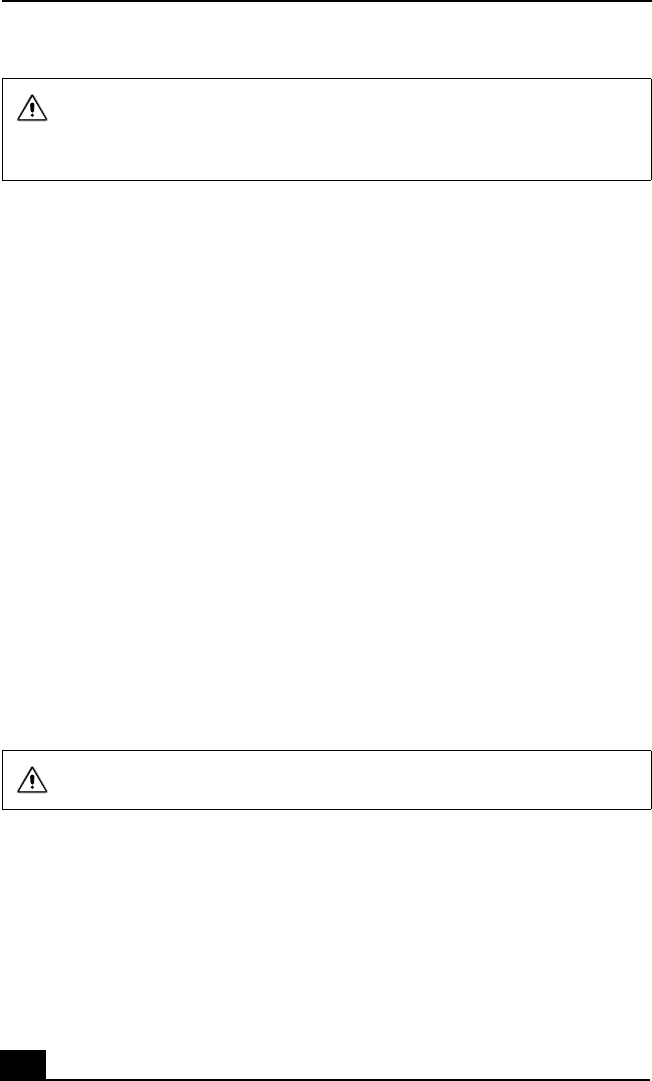
VAIO® Computer Quick Start
110
You can use the System Recovery CD(s) to reinstall the operating system and
software titles that shipped with your computer if they become corrupted or are
erased. You may not need to reinstall the entire contents of your hard drive. If
you experience a problem with your computer, reinstalling an individual device
driver or software title may correct the problem. Use the Application Recovery
CD(s) to reinstall individual applications or use the Driver Recovery CD(s) to
reinstall device drivers.
The System Recovery CD contains a backup copy of all the software originally
installed on your hard disk drive. It can be used only to recover the hard disk of
the computer you purchased.
System Recovery options
❑System Drive Recovery — All data on Drive C is deleted. The factory
default settings and software applications are restored on this drive only.
❑Change Partition Size — All partitions, custom installations, and changes
are removed from the hard disk drive. You can set the partition sizes for both
the Drive C and Drive D. The original, preinstalled operating system and
software applications are restored.
❑Recovery to Original Factory Defaults — All data and partitions are
removed from the hard disk drive. All original factory settings, operating
system, and preinstalled software is restored.
Using the System Recovery CD(s)
Your system may take a few minutes to load necessary files. A blue screen
appears during the downloading process.
The System Recovery process removes all software that you may have
installed since you started using your computer. Reinstall any
applications that were not included with the computer when you
purchased it.
The System Recovery utility does not back up your system’s data. If you
wish to retain your system data, perform a backup to an external media.

Using Your Recovery CDs
111
1Insert the Sony System Recovery CD in the optical drive. The System
Recovery utility starts from the optical drive. The first CD must be in the
drive when your turn on the computer.
2Shut down your computer as described in the “Shutting Down Your
Notebook” section of your supplied Quick Start.
3Wait 30 seconds and turn on your computer.
4The VAIO System Recovery Utility dialog box appears. Click Next.
5At the pop-up prompt, select Yes to begin the system recovery process.
Follow the on-screen instructions.
If your computer does not start from the Recovery CD
1Press the power button and hold it for more than four seconds to turn off the
computer.
2Turn on the computer. When the Sony logo is displayed, press the F2 key.
The BIOS setup menu screen appears.
3Press the arrow keys to select the Exit menu.
4Press the arrow keys to select “Get Default Values” and then press the Enter
key. The message “Load default values for all SETUP items.” appears.
5Check that “Yes” is selected, and press the Enter key.
6Press the arrow keys to select “Save and Exit,” and press the Enter key. The
message “Save configuration changes and exit now?” appears.
7Check that “Yes” is selected, and press the Enter key. The computer restarts
from the Recovery CD.
✍Your system may include one or more System Recovery CDs. If you have more than
one System Recovery CDs, insert the first CD to run the System Recovery program.
You are prompted to insert the second CD once the information from the first CD has
been installed.
The recovery process takes from 30 to 60 minutes to complete.

VAIO® Computer Quick Start
112
After recovering your system using the System Recovery CD(s), you may be
prompted to insert your Application Recovery CD(s) after restarting Windows.
Insert the Application Recovery CD to automatically complete recovery of your
system.

113
Troubleshooting
This section describes how to solve common problems you may encounter
when using your computer. Many problems have simple solutions, so try
these suggestions before you contact Sony Computing Support
(http://www.sony.com/pcsupport).
❑Troubleshooting Your Computer
❑Troubleshooting the LCD Screen
❑Troubleshooting the Mouse and Touchpad
❑Troubleshooting Drives, PC Cards and Peripheral Devices
❑Troubleshooting i.LINK devices
❑Troubleshooting Software
❑Troubleshooting the Modem
❑Troubleshooting Wireless LAN functions
❑Troubleshooting Audio
❑Troubleshooting Memory Stick Media

Change text in this variable definition to document title.
114
Troubleshooting Your Computer
My computer does not start.
❑Check that the computer is plugged into a power source and that it is turned
on. Check that the power indicator on the front panel of the computer
indicates that the power is on.
❑Check that the battery pack is inserted properly and is charged.
❑If you have connected an external floppy disk drive, make sure there is no
floppy disk in the floppy disk drive.
❑Confirm that the power cord and all cables are connected firmly. See
“Connecting a USB Device” for more information.
❑If you plugged the computer into a power strip or Uninterruptible Power
Supply (UPS), make sure the power strip or UPS is turned on and working.
❑If you are using an external display, check that it is plugged into a power
source and turned on. Check that the brightness and contrast controls are
adjusted correctly. See the manual supplied with your display for details.
❑Condensation may cause the computer to malfunction. If this occurs, do not
use the computer for at least one hour.
❑Unplug the power cord, press the reset button by using a thin, straight object
(such as a paper clip), remove battery pack, plug it in again and turn on the
power.
My computer starts, but a BIOS error appears.
❑When the computer’s internal backup battery is low on power, it may not
start your system properly. The message “Press <F1> to resume, <F2> to
setup” appears at the bottom of the screen. Follow these steps:
1Press the F2 key. The BIOS Setup menu appears.
2Set the date (month/day/year). Press Enter.
3Press to select System Time, then set the time (hour: minute:
second). Press Enter.
✍If this occurs on a regular basis, contact Sony Computing Support at:
http://www.sony.com/pcsupport/.

Troubleshooting Your Computer
115
4Press to select Exit, then press to select Get Default Values. The
message “Load default configuration now?” appears.
5Select Yes and press Enter.
6Select Exit (Save Changes), and then press Enter. The message “Save
configuration changes and exit now?” appears.
7Select Yes, and then press Enter. The computer restarts.
My computer starts, but the message “Operating system not
found” appears and Windows does not start.
❑If you have connected an external floppy disk drive, make sure there is no
floppy disk in the floppy disk drive (non-bootable).
❑If a non-bootable disk is in the drive, follow these steps:
1Turn off the computer, and then remove the floppy disk.
2Restart the computer and confirm that Windows starts properly.
❑If Windows still does not start, follow the steps below to initialize the BIOS:
1Remove any disk from the floppy disk drive.
2Remove any peripheral devices connected to the computer.
3Turn off the computer and then turn it on.
4Press the F2 key when the Sony logo appears. The BIOS setup menu
screen appears.
5Press the directional arrow keys to select the Exit menu.
6Press the arrow keys to select “Get Default Values” and then press
Enter. The message “Load default configuration now?” appears.
7Select Yes, then press Enter.
8Use the directional arrow keys to select “Exit” (Save Changes), and then
press Enter. The message “Save configuration changes and exit now?”
appears.
9Select Yes, then press Enter. The computer restarts.
If your computer continues to display the message “Operating system not found,”
and Windows does not start, contact Sony Computing Support.

Change text in this variable definition to document title.
116
My computer stops responding or does not shut down.
It is best to shut down your computer using the Turn Off Computer command on
the Windows Start menu. Using other methods, including those listed here, may
result in loss of unsaved data.
❑Try restarting the computer. On the Windows taskbar, click the Start button,
click Turn Off Computer, and then click Restart.
❑If you cannot restart as described in the preceding step, you can restart the
computer by pressing the Ctrl+Alt+Delete keys at the same time. The
Windows Task Manager dialog box appears, and you can turn off the
computer from the Shut Down menu.
❑If the previous step does not work, press and hold the power button for at
least four seconds. This turns off the power to the computer.
❑If your computer stops responding while playing a CD or DVD, stop the
CD/DVD, and restart the computer by pressing the Ctrl+Alt+Delete keys at
the same time. The Windows Task Manager dialog box appears, and you can
restart the computer from the Shut Down menu.
❑Unplug the computer from the AC adapter and remove the battery pack from
your computer.
The Power Management setting is not responding.
Your computer’s operating system may become unstable if it is interrupted or if
you attempt to make changes before the computer completely enters a lower
power mode, such as Hibernate.
❑To restore the computer to its normal operating stability:
1Close all open applications.
2Restart the computer by pressing the Ctrl+Alt+Delete keys at the same
time to display Windows Task Manager, and then selecting Restart from
the Shut Down menu.
✍Pressing the Ctrl+Alt+Delete keys to turn off the computer via Windows Task
Manager, or turning off the computer with the power switch may result in data loss
in files that are currently open.

Troubleshooting Your Computer
117
The sound of my computer’s fan is too loud.
Use the PowerPanel™ utility to change the Thermal Control Strategy setting to
Quiet. This setting slows down the CPU speed. See PowerPanel Help for more
information.
Why does the System Properties dialog box display a slower
CPU speed than advertised?
This is normal. Because your computer’s CPU utilizes a type of CPU speed
controlling technology, System Properties may display the CPU’s current speed
instead of the maximum advertised speed.
✍If this procedure does not work, press and hold the power button for at least
four seconds to shut down the computer.

Change text in this variable definition to document title.
118
Troubleshooting the LCD Screen
My LCD screen is blank.
❑Check that the computer is plugged into a power source and that it is turned
on.
❑Check that the power indicator on the computer is on.
❑Check that the battery pack is inserted properly and that it is charged.
❑The computer may be in LCD (Video) Standby mode. Press any key to
activate the screen.
❑The display mode may be set to external display mode. Press and hold the Fn
key while pressing F7 several times.
The image on my connected external display is not centered
or sized properly.
Use the controls on your external display to adjust the image. See the manual
supplied with your display for more information.
I cannot simultaneously display movies, DVD video, or the
Smart Capture (Finder) window on the LCD display and an
external display.
Images cannot be displayed on both the LCD display and an external display at
the same time. Select only one display option.
I want to change the video resolution of my display.
You can use independent controls to change the video resolution of your display.
❑Click Start, point to Control Panel, point to Appearance and Themes, and
then click the Display icon. The Display Properties dialog box appears.
❑Click on the Settings tab.
❑Move the Screen Area slider to change your video resolution.

Troubleshooting the Mouse and Touchpad
119
Troubleshooting the Mouse and Touchpad
My mouse does not work.
❑If you are using an external mouse, check that the mouse cable is plugged
into the USB port. See “Connecting an External Display” for details. A serial
mouse or PS/2® mouse is not compatible with this computer.
❑Reinstall the mouse/touchstick drivers. See “Using Your Recovery CDs” for
more information.
My touchpad does not work properly.
You may have disabled the touchpad without a mouse being connected to the
notebook. To enable the touchpad:
1Press the Windows® key and use the arrow keys to select Programs, and
then Sony Notebook Setup.
2Select the Touchpad tab using the arrow keys.
3Select Enable Touchpad, and press Enter.
You must restart the notebook to make the touchpad work again.
If your touchpad is interpreting a single tap as a double-click, you must adjust the
button assignments. Follow these steps:
1Press the Windows key and use the arrow keys to select Control Panel, and
then Mouse.
2Change the button assignments in the Mouse Properties dialog box. (One of
the buttons is assigned to the double-click action.)
If this procedure does not work, ensure that another mouse was not installed. You
may need to use your supplied Driver Recovery CD(s) to reinstall the mouse
drivers. See “To use the Driver Recovery CD(s)” for more information.
The pointer does not move while I am using the Touchpad or
Mouse.
❑The computer should be restarted. Follow these steps:
1Press the Windows key.

Change text in this variable definition to document title.
120
2Press the “U” key to select Turn Off Computer / Shut Down, and wait at
least four seconds.
3Press the “R” key to restart your computer.
❑If you cannot restart your notebook as described in the step above, press
Ctrl+Alt+Delete simultaneously to display Windows Task Manager, press
Alt+”U” to display the Shut Down menu, and press “R” to restart the
computer.
❑If you cannot restart your notebook as described in the step above, press and
hold the power button for more than four seconds to turn off the notebook.
❑If the pointer does not move while playing a disc, press Ctrl+Alt+Delete
simultaneously to stop playback, display the Windows Task Manager and
enable you to restart the notebook by selecting Restart from the Shut Down
menu.
❑If this procedure does not work, ensure that another mouse was not installed.
❑You may need to use your supplied Driver Recovery CD(s) to reinstall the
touchpad drivers. See “To use the Driver Recovery CD(s)” for more
information.

Troubleshooting Drives, PC Cards and Peripheral Devices
121
Troubleshooting Drives, PC Cards and
Peripheral Devices
My floppy disk drive icon doesn’t appear even though it is
connected.
❑Make sure that the floppy disk drive is properly connected. Wait a few
moments to allow the computer to recognize the drive.
❑Close all open applications and restart your computer with the connected
floppy disk drive. Make sure that there is no floppy disk in the floppy disk
drive, in order for the computer to start up correctly.
My optical drive is not playing my disc properly.
❑Make sure the optical drive is inserted correctly into the PC Card slot or
i.LINK®* port.
❑Make sure the label of the disc is facing up.
❑If the disc requires software, make sure the software is installed according to
the manufacturer’s instructions.
❑A dirty or damaged disc may cause the computer to stop responding while it
tries to read the disc. If necessary, restart the computer, remove the disc, and
then check it for dirt or damage.
❑If you see video but can not hear audio, check all of the following:
❑Check that your optical drive does not have the mute setting enabled.
❑Check the volume setting in the audio mixer.
❑If you are using external speakers, check the volume settings, and then
check the connections between your external speakers and the
computer.
* i.LINK is a trademark of Sony used only to designate that a product contains an IEEE 1394
connection. The i.LINK connection may vary, depending on the software applications, oper-
ating system, and compatible i.LINK devices. All products with an i.LINK connection may
not communicate with each other. Refer to the documentation that came with your compati-
ble i.LINK device for information on operating conditions and proper connection. Before
connecting compatible i.LINK PC peripherals to your system, such as CD-RW or hard disk
drive, confirm their operating system compatibility and required operating conditions.

Change text in this variable definition to document title.
122
❑Check that the correct drivers are installed properly. To view the drivers,
do the following: Click Start, point to Control Panel, click System,
select the Hardware tab, and click Device Manager.
❑Check that digital CD audio is enabled for your optical drive. Perform the
following steps:
1Click Start, point to Control Panel, and click System. The System
Properties window appears.
2Select the Hardware tab and then click the Device Manager button. The
Device Manager window appears.
3Double-click the DVD/CD-ROM drive name. The Properties window
appears.
4Click the Properties tab, and then select the “Enable digital CD audio
for this CD-ROM device” check box.
❑Do not use adhesive labels to identify the CD. The label may come off while
the disc is in use in the optical drive and cause the drive to malfunction.
❑If a region code warning appears when you try to use a DVD-ROM drive, it
may be that the DVD you are trying to play is incompatible with the
DVD-ROM drive. Check the region code listing on the DVD packaging.
❑Condensation may cause the computer to malfunction. If this occurs, do not
use the computer for at least one hour.
My optical disc drive tray does not open.
❑Make sure the computer is turned on.
❑Press the Eject button on the optical drive.
❑If the Eject button does not work, you can open the tray by inserting a long,
thin object (such as a straightened paper clip) into the hole to the right of the
Eject button.
I cannot use digital video (DV) devices. The message “DV
equipment seems to be disconnected or turned off” appears.
❑Check that the DV device is turned on and that the cables are properly
connected.
❑Disconnect the i.LINK® cable and connect it again.

Troubleshooting Drives, PC Cards and Peripheral Devices
123
My PC Card is not working.
❑Make sure the PC Card is inserted properly into the PC Card slot.
❑Make sure the PC Card is compatible with Microsoft® Windows®.

Change text in this variable definition to document title.
124
Troubleshooting i.LINK devices
I cannot establish a connection between two VAIO computers
when using an i.LINK cable.
1Disconnect the i.LINK®* cable from both computers and reconnect it.
2Wait for the computers to respond. If neither computer responds after a few
moments, restart both computers.
* i.LINK is a Sony trademark used only to designate that a product contains an IEEE 1394 con-
nection. The i.LINK connection may vary, depending on the software applications, operating
system, and compatible i.LINK devices. All products with an i.LINK connection may not
communicate with each other. Refer to the documentation that came with your compatible
i.LINK device for information on operating conditions and proper connection. Before con-
necting compatible i.LINK PC peripherals to your system, such as a CD-RW or hard disk
drive, confirm their operating system compatibility and required operating conditions.
✍The computers may not recognize an i.LINK connection after returning from a
power saving mode (Standby or Hibernate). If that happens, restart the computers to
establish a connection.

Troubleshooting Software
125
Troubleshooting Software
My software program stops responding or crashes.
Contact the software publisher or designated provider for technical support. See
the “Software Support Information” section for more information.
When I click an application icon, the message “You must
insert the application CD into your CD-ROM (DVD-ROM) drive”
appears, and the software does not start.
❑Make sure that your optical drive is connected to your computer.
❑Some titles require specific files that are located on the application CD.
Insert the disc and try starting the program again.
❑Make sure you place the CD in the tray with the label side facing up.
I cannot use the DVgate software.
If your computer is using the Ultimate Battery Life profile for its power saving
mode, you cannot use DVgate or Smart Connect software. Please select another
profile.
My computer’s start-up time seems longer after I have
installed AOL. What can I do?
On some computers, installing America Online® (AOL) may increase boot time
by up to a minute. If you experience this on your system and would like to speed
up the time required to start your computer, you may want to disable the AOL
WAN driver. Do the following:
1Click Start in the Windows® taskbar and select Control Panel.
2Click Network Connections. The Network Connections dialog box appears.
3Right-click on the Local Area Connection with device name “WAN Network
Driver,” and select Disable.
Verify that your AOL connection still functions satisfactorily with the WAN
Network Driver disabled. If you need to reverse this setting, repeat the steps
above and select Enable.

Change text in this variable definition to document title.
126
What software do I use for CD-R/CD-RW software functions?
Sony recommends using the preinstalled SonicStage software’s Record function
to create CDs on your VAIO® computer, if the specific model you purchased is
preconfigured with all necessary components for CD-R and CD-RW capability.
Downloading the optional RealJukebox CD-burning component to create any
CDs on your computer may interfere with normal system operations.

Troubleshooting the Modem
127
Troubleshooting the Modem
My modem does not work.
❑Check that the phone line is plugged into the line jack. See “Connecting a
Telephone Cable” for details.
❑Check that the phone line is working. You can check the line by plugging in
an ordinary phone and listening for a dial tone.
❑Check that the phone number the program is dialing is correct.
❑Check that the software you are using is compatible with the computer’s
modem. (All preinstalled Sony programs are compatible.)
❑Reinstall the modem driver. See “Using Your Recovery CDs” for more
information.
My modem connection is slow.
Your computer is equipped with a V.90/K56flex-compatible modem. Many
factors may influence modem connection speed, including telephone line noise
or compatibility with telephone equipment (such as fax machines or other
modems). If you think your modem is not connecting properly to other PC-based
modems, fax machines, or your Internet Service Provider, check the following:
❑Have your phone company check that your phone line is free from any line
noise.
❑If your problem is fax-related, check that there are no problems with the fax
machine you are calling and that it is compatible with fax modems.
❑If you are having a problem connecting with your Internet Service Provider,
check that the ISP is not experiencing technical problems.
❑If you have a second phone line available, try connecting the modem to that
line.

Change text in this variable definition to document title.
128
Troubleshooting Wireless LAN functions
I cannot use the Wireless LAN functionality.
Check if the Wireless LAN switch on the left side of the computer is in the ON
position.
The computer cannot connect to a Wireless LAN Access
Point.
❑Check if the Wireless LAN switch on the left side of the computer is in the
ON position.
❑Check if power to the Access Point is on.
❑Check if the Access Point is displayed in the “Available networks” window.
Do the following:
1Click Start and select Control Panel.
2Click Network Connections.
3Right-click Wireless Network Connection and select Properties. The
Wireless Network Connection Properties dialog box is displayed.
4Select the Wireless Networks tab, and check if the Access Point is
displayed in the “Available networks” window.
❑Connection availability is affected by distance and obstructions. You may
need to move your computer away from obstructions or nearer to any Access
Point you may be using.
❑Be sure that the encryption key is correctly inserted.
I cannot access the Internet.
❑Check the Access Point settings. Refer to the instructions supplied with the
Access Point.
❑Check if your computer and the Access Point are connected to one another.
❑Move your computer away from obstructions or nearer to any access point
you may be using.

Troubleshooting Wireless LAN functions
129
The data transfer speed is slow.
❑The Wireless LAN data transfer speed is affected by distance and
obstructions between devices and access points. Other factors include device
configurations, radio conditions, and software compatibility. To maximize
the data transfer speed, move your computer away from obstructions or
nearer to any Access Point you may be using.
❑If you are using a Wireless LAN Access Point, the device may be
temporarily overloaded depending on the number of other devices
communicating via the access point.
The communication speed is interrupted or slowed down
when MPEG2 data is transferred.
The typical effective data transfer speed via an Access Point is 4-5 Mbps when
adhering to the IEEE802.11b standard. High-rate stream transfers with MPEG2
data may lower this rate further.
Data transfers are interrupted.
Data transfer interruptions may occur with large files. Check if the Access Point
connection is intact. Do the following:
1Right-click the Wireless Network Connection icon in the taskbar and select
Status. The Wireless Network Connection Status dialog box appears.
2Check the connection status.
Next, change the settings temporarily by performing the following actions:
1Click Start and select Control Panel.
2Click Network Connections.
3Right-click Wireless Network Connection and select Properties. The
Wireless Network Connection Properties dialog box is displayed.
4Select the Wireless Networks tab.
5Click to deselect the “Use Windows to configure my wireless network
settings” option.
6Resume or restart the file transfer.

Change text in this variable definition to document title.
130
7When the file transfer has been completed, repeat the steps above to select
the “Use Windows to configure my wireless network settings” option.

Troubleshooting Audio
131
Troubleshooting Audio
My speakers have no sound.
❑If the built-in speakers are turned off, press the Fn+F3 keys to turn on the
speakers. You can also turn on the speakers using the Jog Dial control.
❑If the speaker volume is turned to the minimum, press the Fn+F4 keys and
press the Up or Down icon to increase the volume or you can use the
Jog Dial control to control the volume.
❑If nothing is displayed when you press the Fn+F3 or Fn+F4 keys, then:
1Click Start, point to Control Panel, click “Sounds, Speech, and Audio
Devices,” and click “Sounds and Audio Devices.” The Sounds and
Audio Devices Properties dialog box appears.
2Verify that the Mute box has not been checked, and that the volume is
not on the lowest setting. You can choose advanced options to
customize audio settings.
❑If your computer is battery-powered, check that the battery pack is inserted
properly and that it is charged.
❑If you are using an application that has its own volume control, check that
the volume is turned up.
❑Check the volume controls in Windows®.
❑If you connect external speakers, check that the speakers are properly
connected and the volume is turned up. If the speakers have a mute button,
make sure it is off. If the speakers are powered by batteries, check that the
batteries are inserted properly and that they are charged.
❑If you have connected an audio cable to the Headphone jack, disconnect the
cable.
There is noise distortion while listening to music with USB
speakers or USB headphones.
Use the preinstalled PowerPanel™ software to set the CPU control to
Performance. Do the following:

Change text in this variable definition to document title.
132
1Right-click the CPU icon on the bottom right of the taskbar, and click
“Edit/create profiles. The Profile editor window appears.
2In the left portion of the window, click the power management profile you
want to set. Maximum Battery Life is the default selection when your
computer runs on battery power.
3In the right portion of the window, double-click CPU Control. The list of
CPU control options appears.
4Click Performance.
5Click the File menu and select Save.
6Close the Profile Editor window.
My microphone does not work.
If you are using an external microphone, check that the microphone is plugged
into the Microphone connector. See “Connecting an External Microphone” for
details.

Troubleshooting Memory Stick Media
133
Troubleshooting Memory Stick Media
Image files do not open even though I insert Memory Stick
media into the slot.
❑By the default setting, VisualFlow™ software starts automatically when you
insert Memory Stick® media into the slot.
❑If VisualFlow software is active and the image files in Memory Stick media
are not displayed, the format type of the Memory Stick media can be
different.
❑Copy the data from the Memory Stick media onto the hard disk drive of your
computer and then format the Memory Stick media using Memory Stick
Formatter software preinstalled on your computer.
Memory Stick media does not work. I cannot access the
removable drive.
❑If you cannot find the Memory Stick icon in My Computer, click the View
drop-down menu and select Refresh. Wait a few moments to recognize the
Memory Stick media. Click the Memory Stick icon to view any possible
contents.

Change text in this variable definition to document title.
134

135
Getting Help
Sony provides you with several support resources to answer questions
about your VAIO® computer or the preinstalled software. Refer to these
resources in the order they are listed.
Support Options
If you have questions about your computer or the preinstalled software, refer to
the following sources for answers in the sequence listed below.
1VAIO® Computer User Guide
The online VAIO® Computer User Guide and the printed VAIO®
Computer Quick Start provide you with information on how to maximize
your notebook capabilities and solve common problems.
2 Software Manuals and Online Help Files
The software preinstalled on your notebook may come with an online
manual. These manuals are stored on the hard disk drive as online Help
files. You can find the Help files from the Help menu under the specific
software application. Some software applications may come with a
printed manual.
3 Operating System Online Support
Your computer comes preinstalled with Microsoft® Windows®. For
operating system support, you can access Microsoft® customer support
at: http://support.microsoft.com/directory/.
4 VAIO Support Agent
You can find VAIO Support Agent by clicking Start and selecting Help
and Support. Using advanced diagnostic technology, Sony’s VAIO
Support Agent runs scheduled protections of your applications, network
settings, and other important software settings. When your software is
protected, you can use VAIO Support Agent to repair software problems
by restoring your software to any of the previously protected states.

VAIO® Computer Quick Start
136
5 Sony Computing Support
This service provides instant access to information on commonly
encountered problems. Enter a description of your problem and the
Knowledge Database searches for the corresponding solutions online.
You can access Sony Computing Support at:
http://www.sony.com/pcsupport.
6 Sony Fax-on-Demand
This service, which requires a fax machine or your fax software, provides
answers to commonly asked questions. You can use this automated
service to request a list of available topics, and select the topics that you
want to receive. To contact the Sony fax-on-demand service, call:
1-888-4-SONY-PC (1-888-476-6972).
7 Sony Customer Support
Software support is available free of charge for 90 days after the original
date of purchase. You can call and speak with a Sony Customer Support
Representative without using your computer by calling:
1-888-4-SONY-PC (1-888-476-6972).
8 Sony Service Center
For the Sony Service Center nearest you, call 1-888-4-SONY-PC
(1-888-476-6972) or find Sony Customer Service on the Web at
http://www.sony.com/pcsupport.

137
A
About This Computer tab 73
AC power setting 76
Access Point, Wireless LAN 68
adding
hardware 41
memory 85
peripherals 41
printer 56
adjusting
brightness 17
volume 17
Alt key 14
Application Recovery CD 107
Applications key 14
audio
adjusting volume 17
connecting external speakers 64
external microphone 65
troubleshooting 131
Audio tab 73
B
battery packs
charge status icons 80
conserving battery power 78
brightness
adjusting 17
built-in speaker 17
volume 17
C
cameras
digital video recorder 58
canceling commands 13
Caps Lock
indicator light 16
CD or DVD discs
cleaning 49
handling 49

Change text in this variable definition to document title.
138
inserting 47
CD-ROM drive
closing lid 48
connecting 28, 46
using 46
cleaning
CD or DVD discs 49
coin-operated telephones 33
computer
connecting to another 63
expanding capabilities 68
online support 135
setup screen 72
connecting
another computer 63
CD-ROM drive 28, 46
coin-operated telephones 33
digital video recorder 58
Ethernet 34
external speakers 64
floppy disk drive 42
i.LINK device 58
i.LINK optical disc drive 50
LAN 34
microphone 65
monitor 60
multiple phone lines 33
network 28
party phone lines 33
PBX 33
phone line 33
printer 56
USB device 55
correction keys 13, 14
Ctrl key 14
cursor-movement keys 13
D
digital video camera 58
display

139
mode 83
options 62
selecting 62
Driver Recovery CD 108
drives 46
CD-ROM 46
floppy disk 42
optical 46
troubleshooting 121
DV In/Out 58
DVD-ROM drive tray
troubleshooting 122
DVgate applications 99
E
Eject button 44
ejecting
floppy disks 44
Escape key 13
expanding your computer capabilities 68
external devices
display 60, 62
speakers 64
external display
connecting 60
F
floppy disk drive
connecting 42
disconnecting 29, 44, 52
floppy disks
ejecting 44
handling 45
Fn key 14
combination commands 16
function keys 13, 14
G
getting help 135
Guide mode 21

Change text in this variable definition to document title.
140
H
handling
CD or DVD discs 49
floppy disks 45
help 135
Hibernate mode 18, 31
I
i.LINK 58
connecting 58
i.LINK optical disc drive
connecting 50
notes on 52
IEEE 1394 58
indicator lights
Caps Lock 16
Num Lock 16
Scroll Lock 16
Insert key 13, 14
inserting
CD or DVD discs 47
installing
hardware 41
memory 28
peripherals 41
J
Jog Dial control 20
K
keyboard 16
connecting 53
using 12–15
L
LAN
connecting 34
Launcher mode 20
LCD
selecting display 62
troubleshooting 118

141
M
MagicGate 24
Maximum Battery Life power setting 76
Maximum Performance power setting 76
memory
adding 85
confirming added capacity 92
removing 90
memory module
installing 28
Memory Stick
notes on 26
troubleshooting 133
using 24
Memory Stick card slot 24
Memory Stick media
displaying contents 25
microphone
connecting 65
troubleshooting 132
modem
troubleshooting 127
monitor
connecting 60
selecting 62
switching among 17
mouse
connecting 53
troubleshooting 119
multiple phone lines 33
N
navigation keys 13
network
connecting 28
LAN 34
Wireless LAN 36
Notebook Setup tabs 73
Num Lock

Change text in this variable definition to document title.
142
indicator light 16
numeric keypad area 13
O
online support 135
operator keys 14
output devices
adding 56
P
party phone lines 33
PBX 33
PC Card
inserting 28
removing 29
troubleshooting 121
Type I and II 28
using 28
Wireless LAN Access Point 68
PDA 68
peripheral devices
troubleshooting 121
Personal Digital Assistant 68
phone
connecting line 33
jack 33
ports
printer 56
USB 55
Power Management
commands 77
profiles 75
power management
settings 74
Power Management Off power setting 76
Power On
Password tab 73
power saving modes
Hibernate 18, 31
Standby 17, 31

143
power setting
AC 76
Maximum Battery Life 76
Maximum Performance 76
Power Management Off 76
Standby 78
Video Standby 78
PowerPanel
customizing toolbar 75, 78
Print Screen key 13
printer
connecting 56
port 56
R
Recovery CDs 107
removing
floppy disk drive 29, 44, 52
floppy disks 44
memory module 90
restoring data 107
S
Scroll Lock
indicator light 16
setup screen
About This Computer tab 73
Audio tab 73
displaying 72
Power On Password tab 73
setup tabs 73
Shift key 14
software
descriptions 93
DVgate 99
support 101
troubleshooting 125
using the Jog Dial control with 21
Sony Fax-on-Demand 136
Sony Notebook Setup screen 72

Change text in this variable definition to document title.
144
Sony Service Center 103
speakers
external 64
troubleshooting 131
Standby mode 17, 31, 78
support, Sony 135
switching
display 17
monitor 17
System Recovery CD 109
T
technical support 135
touchpad
troubleshooting 119
troubleshooting
audio 131
drives, PC Cards, and peripheral devices 121
general 113
LCD screen 118
Memory Stick media 133
modem 127
mouse 119
software 125
touchpad 119
U
USB
connecting 55
keyboard 55
mouse 55
port 55
using
Jog Dial control 20
Memory Stick 24
PC Cards 28
V
VAIO Action Setup 19, 98
video camera 58
volume

